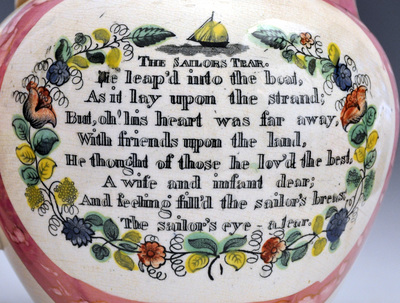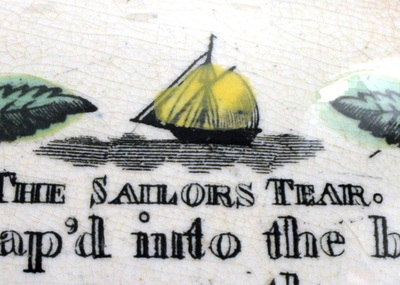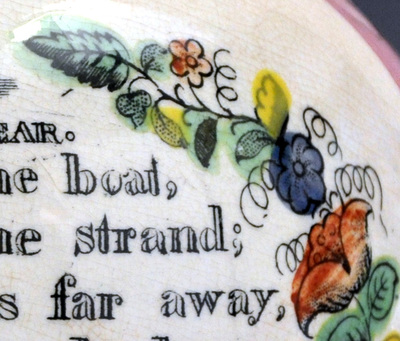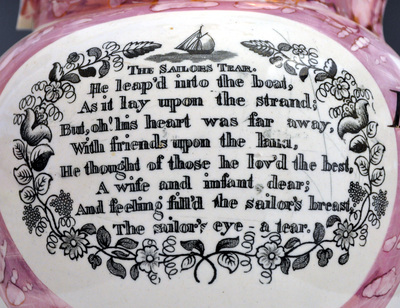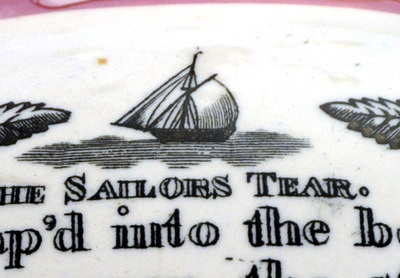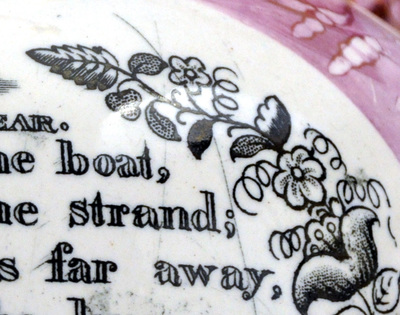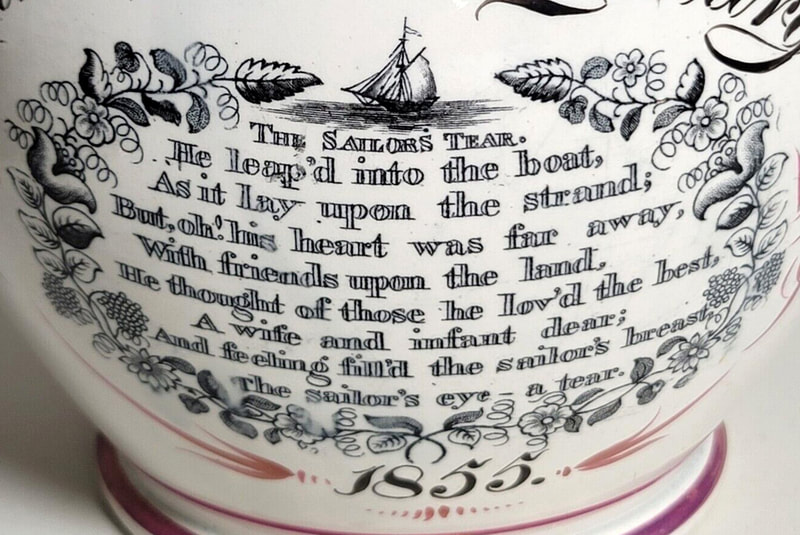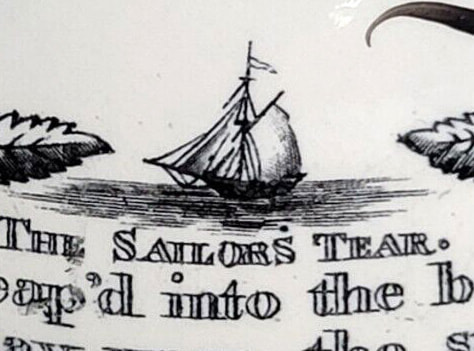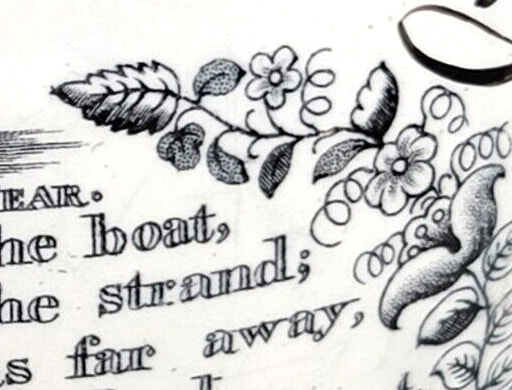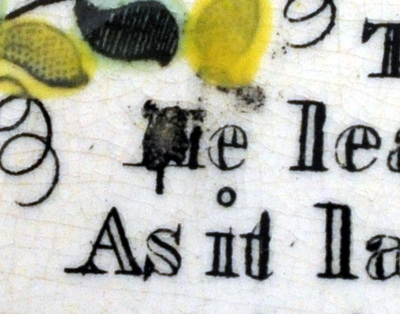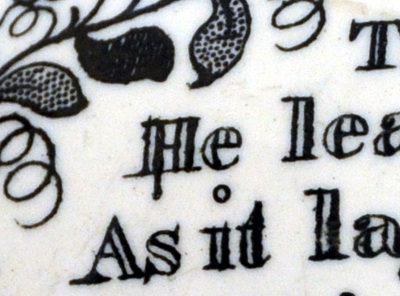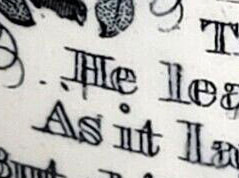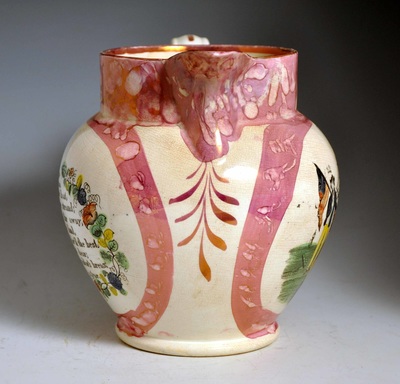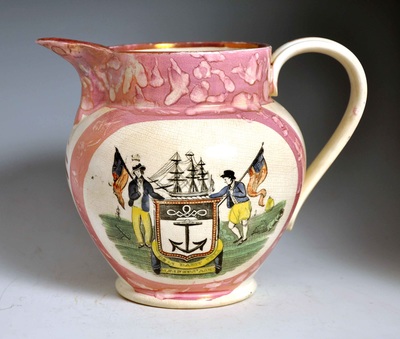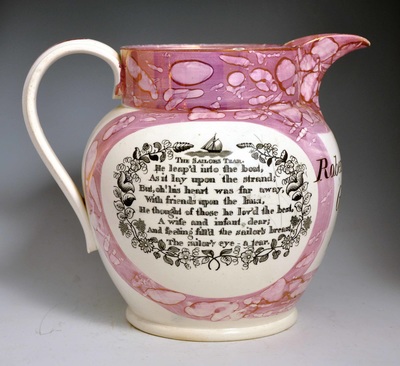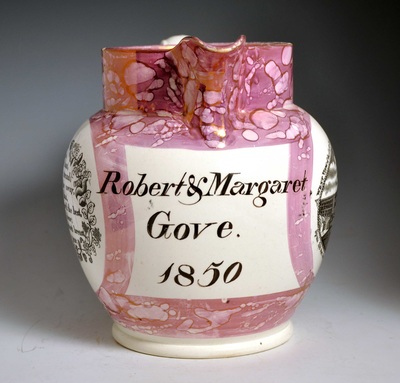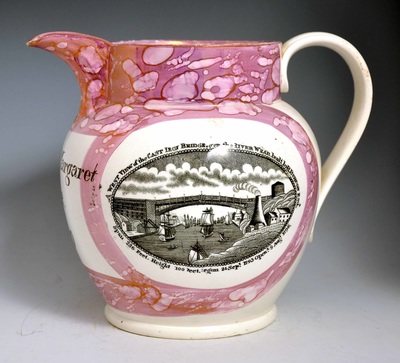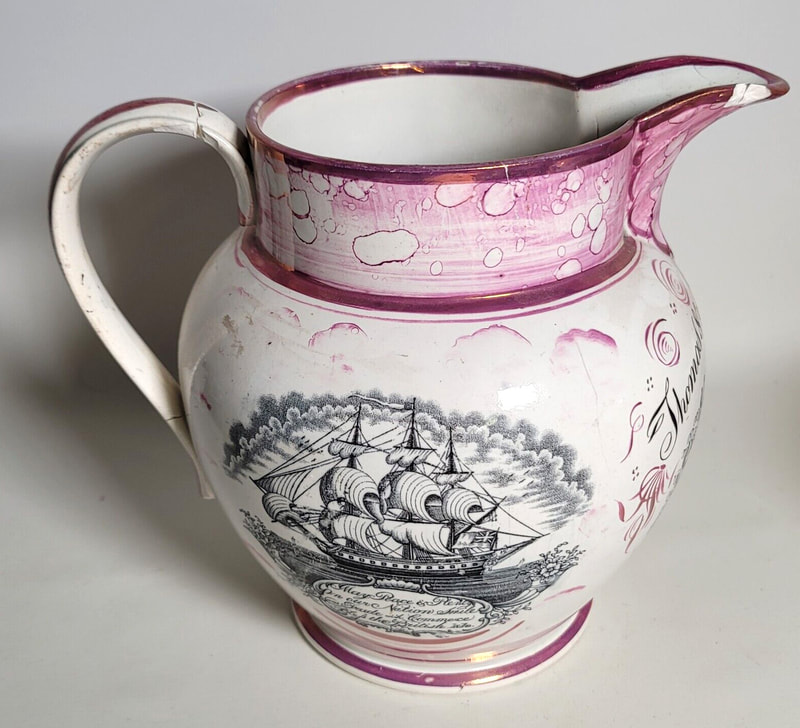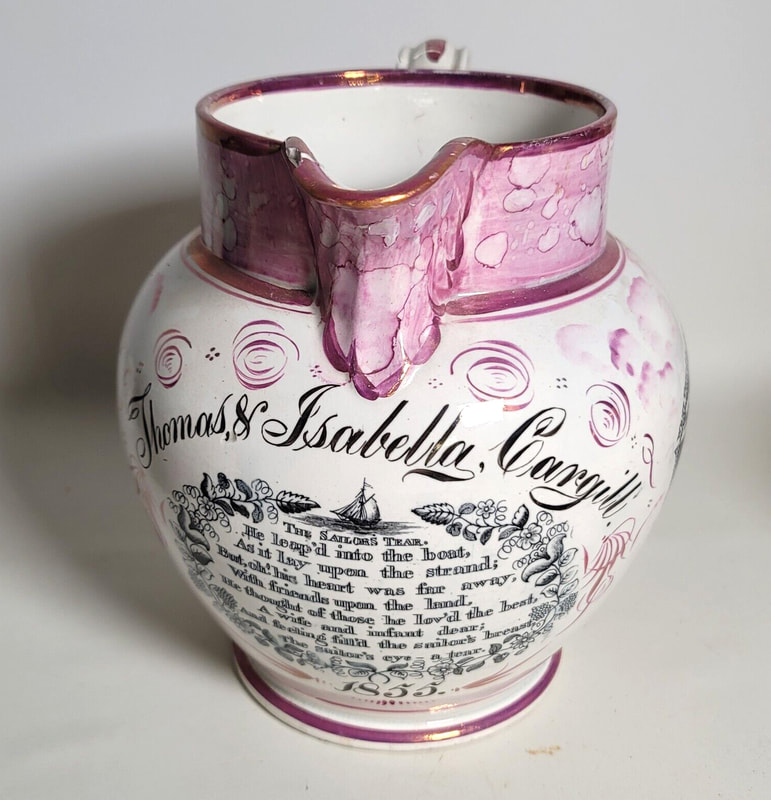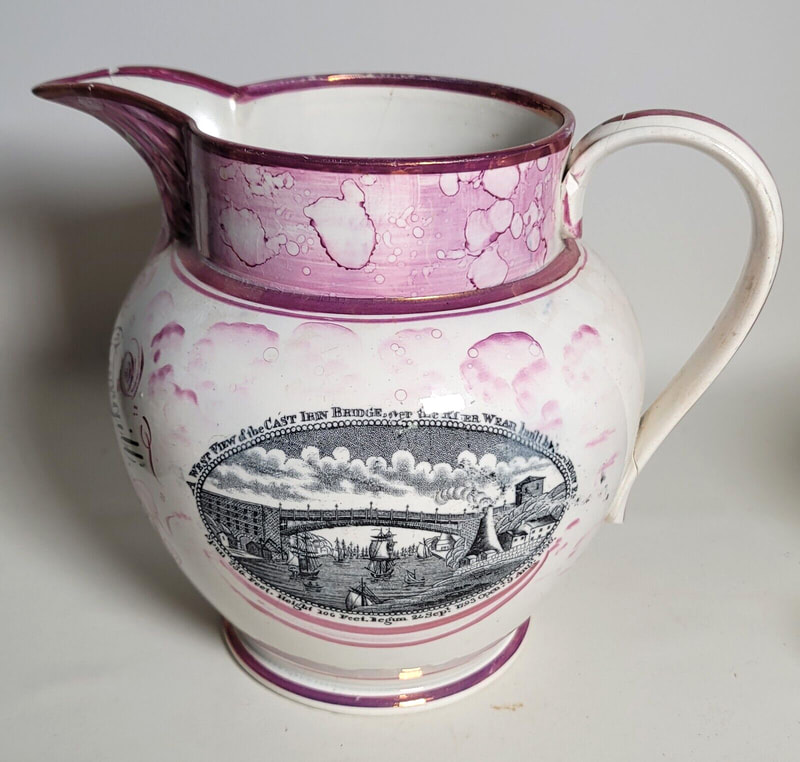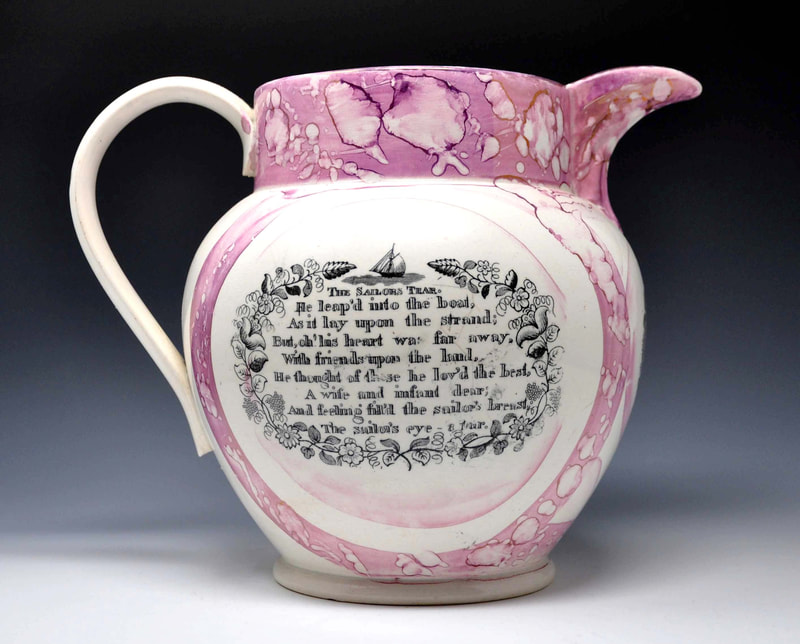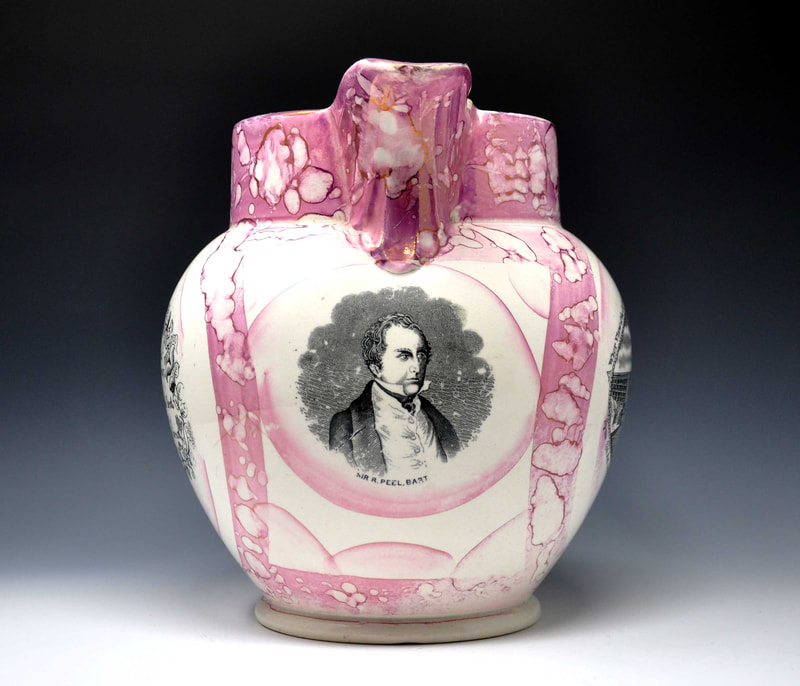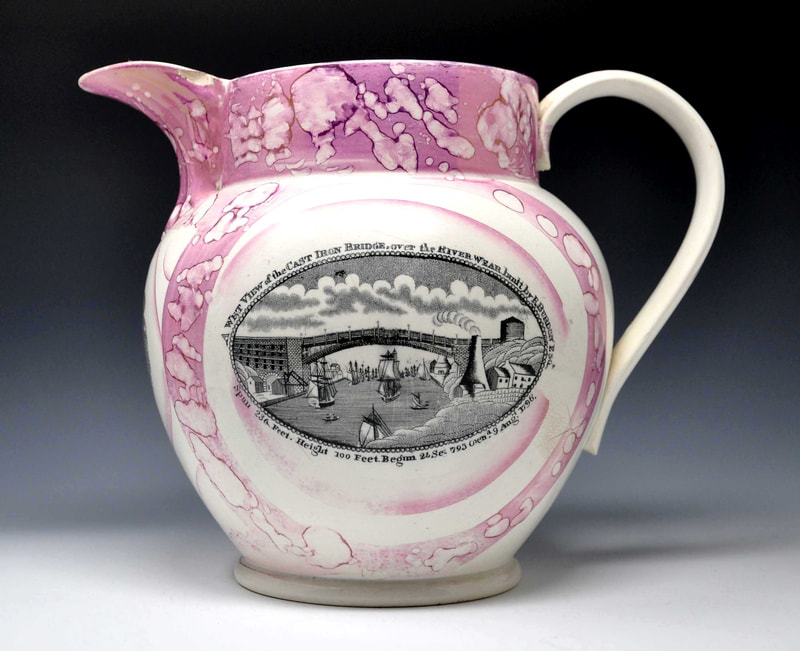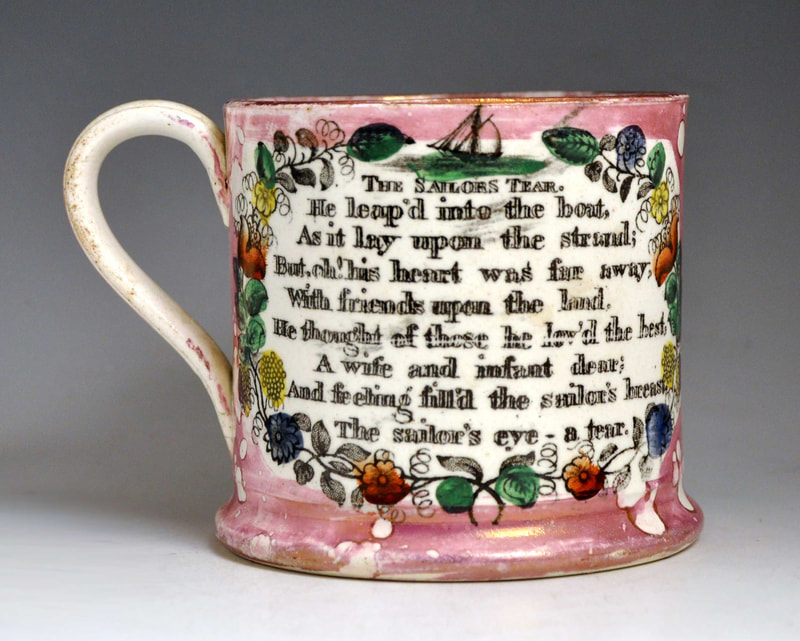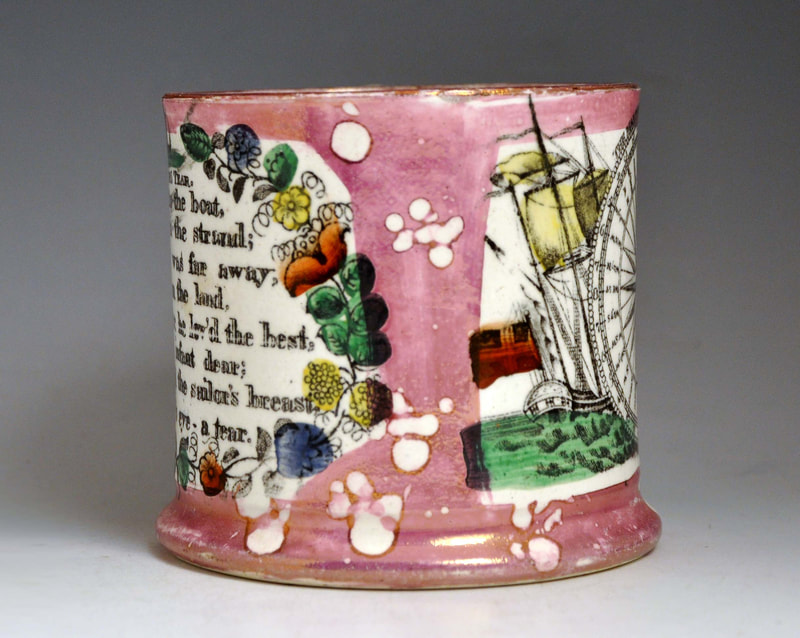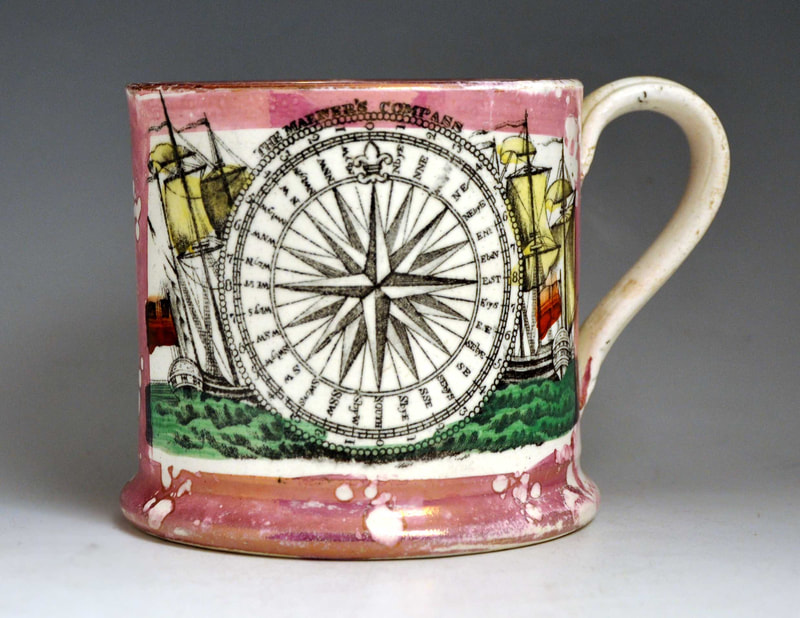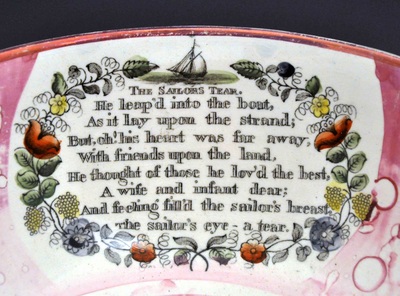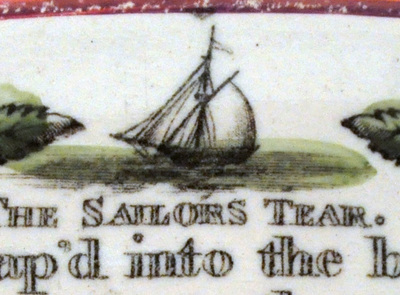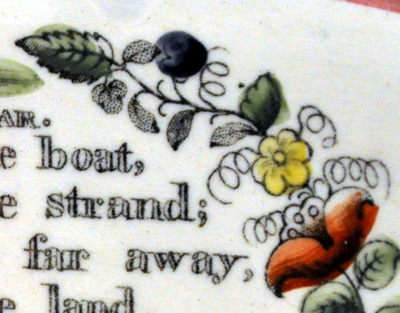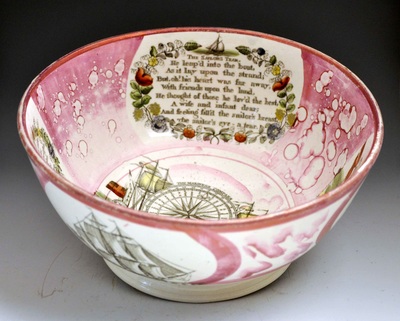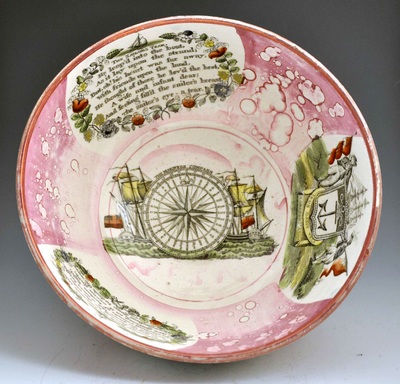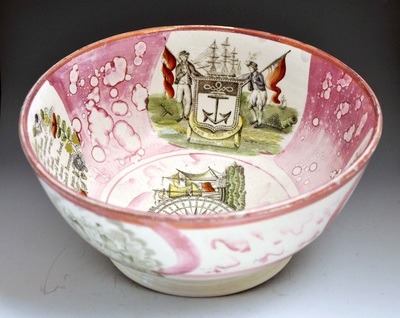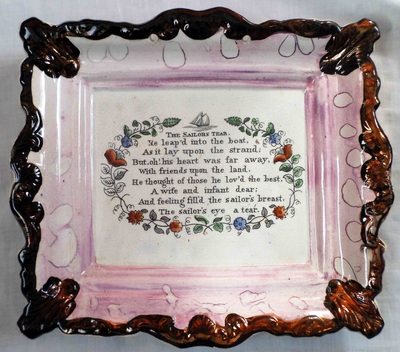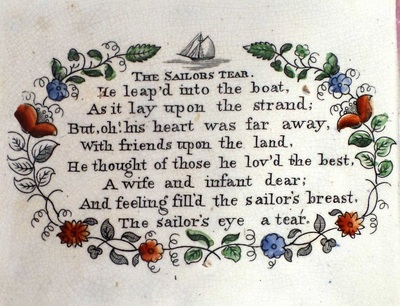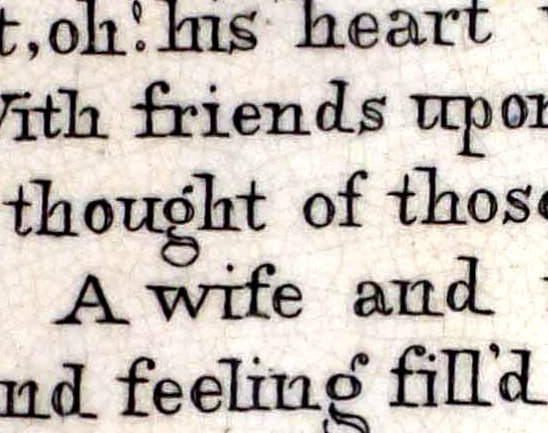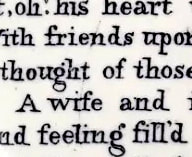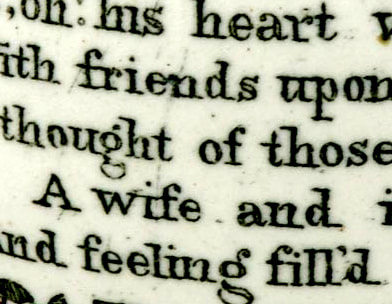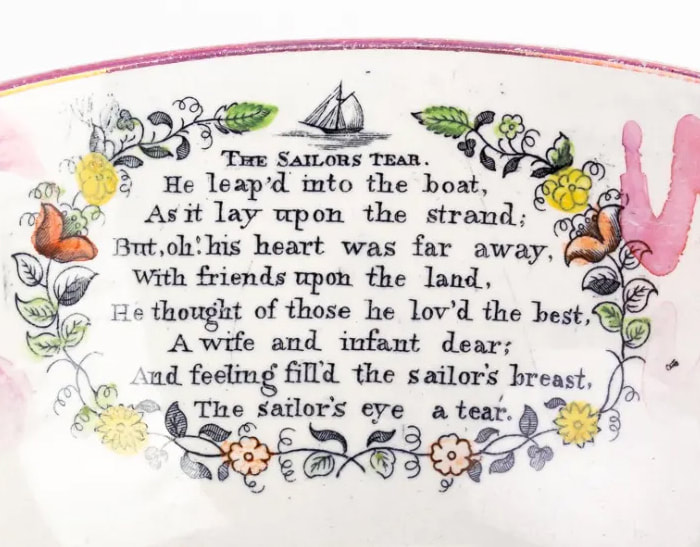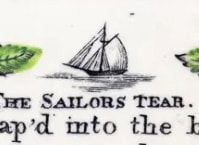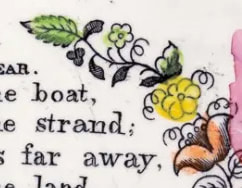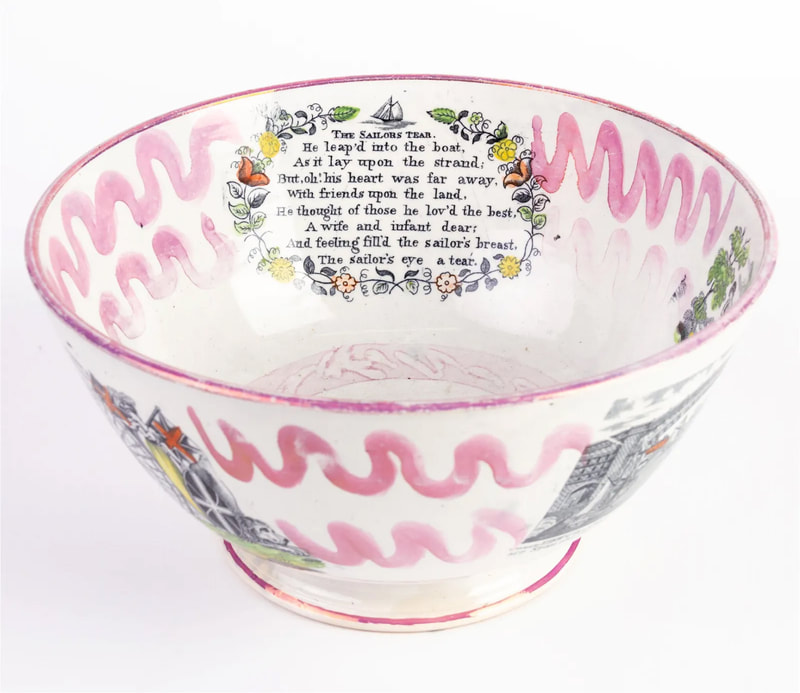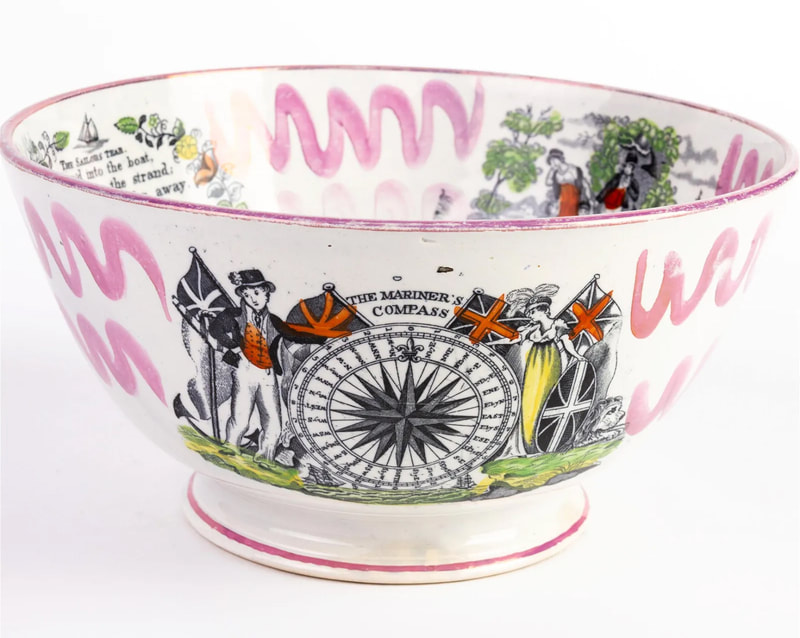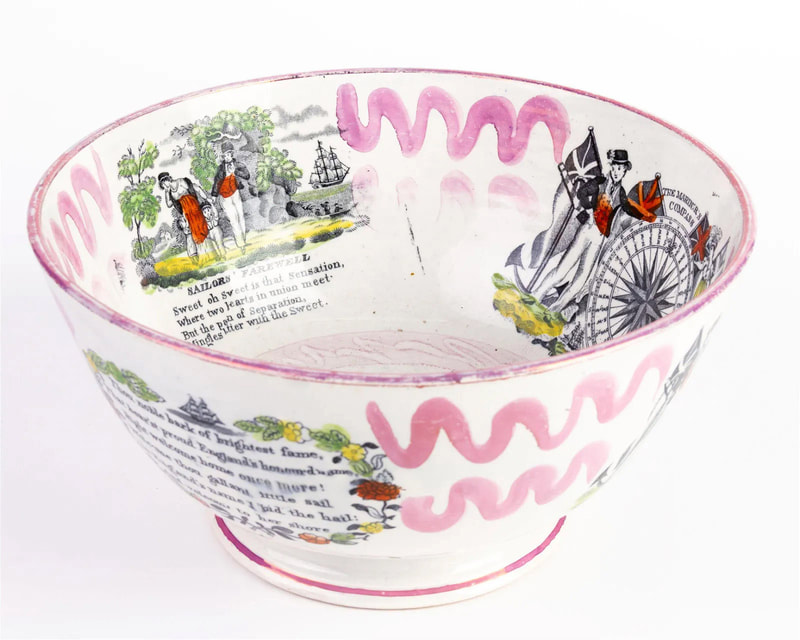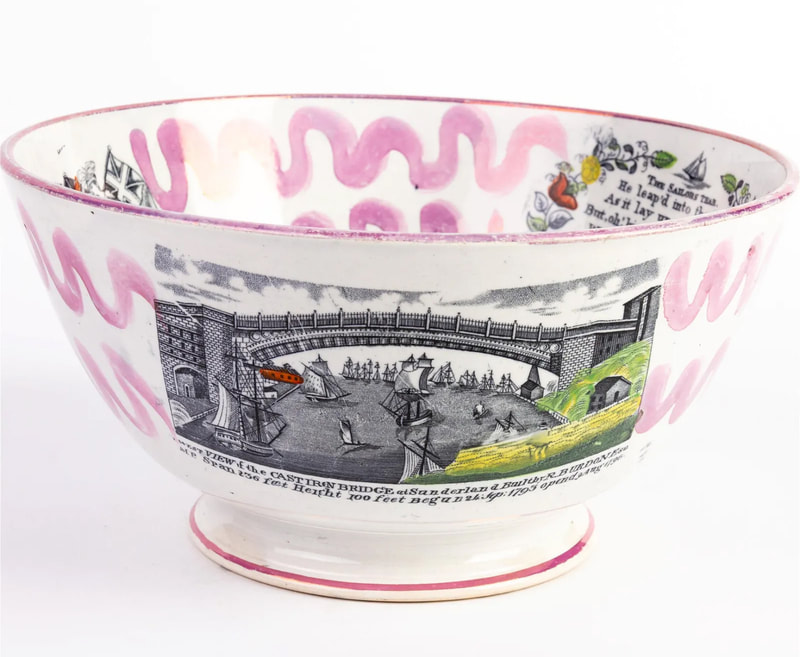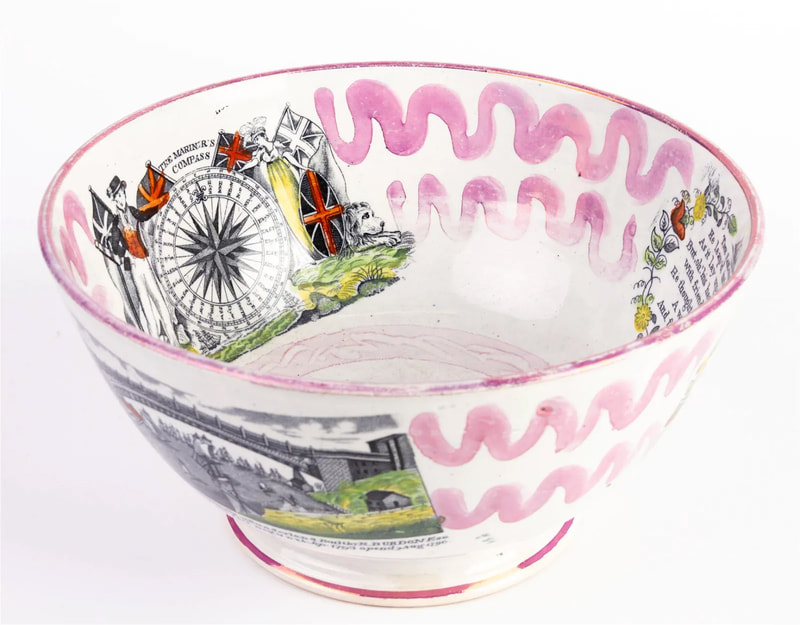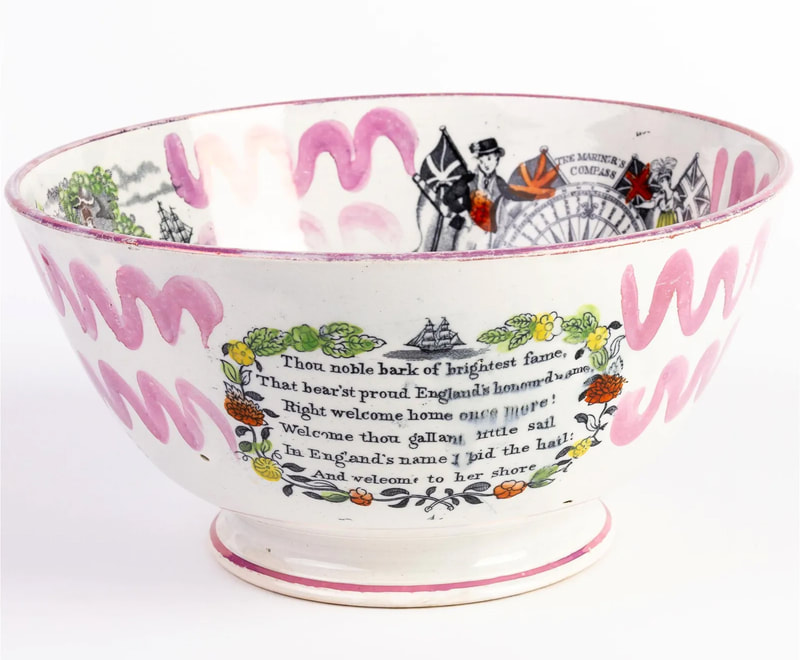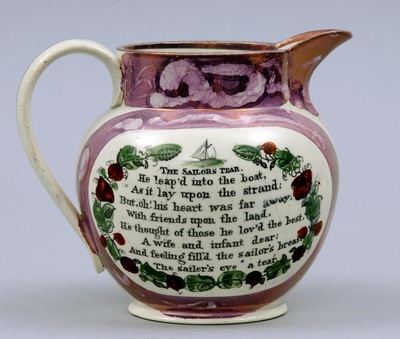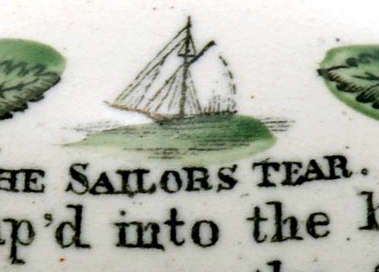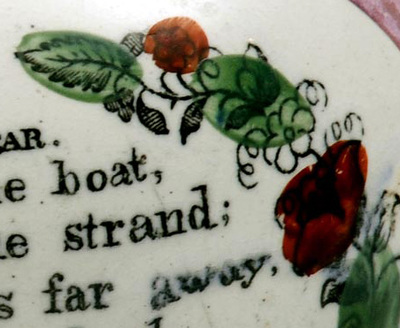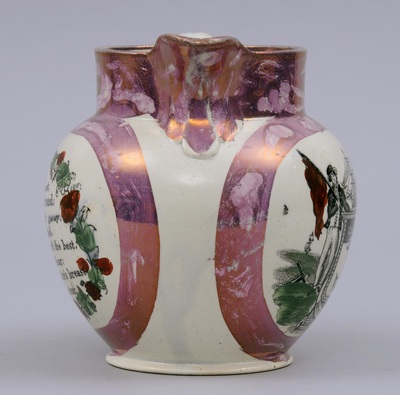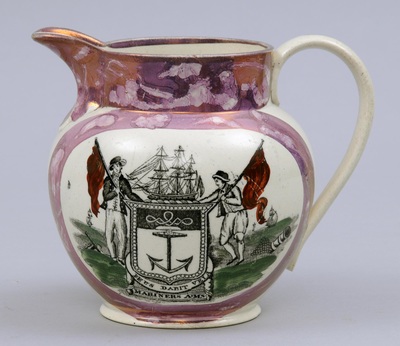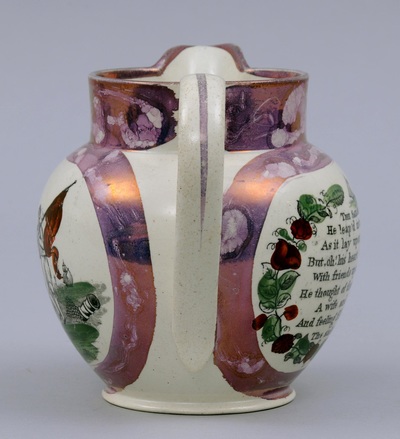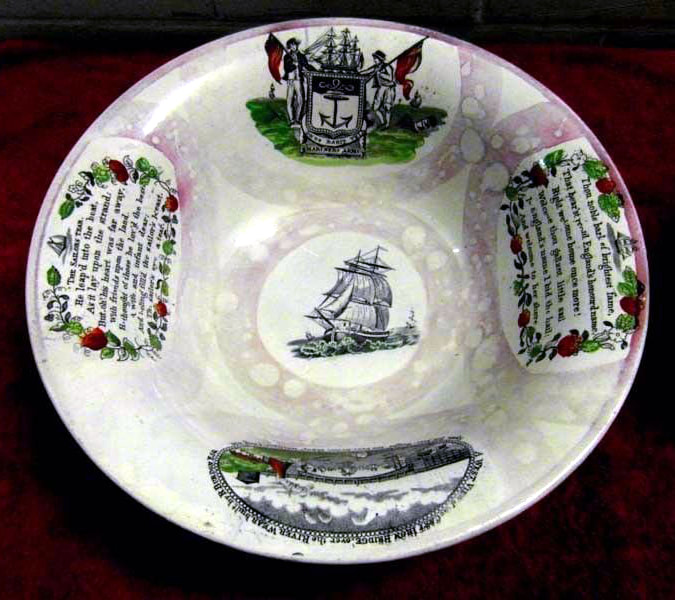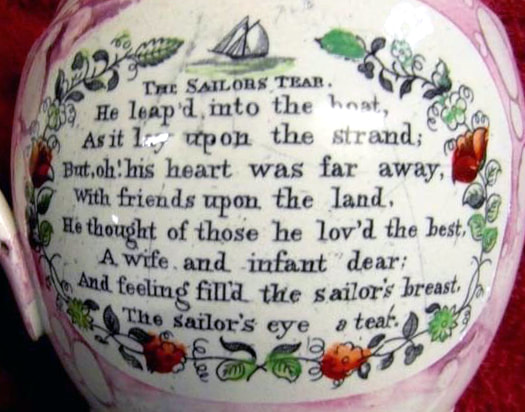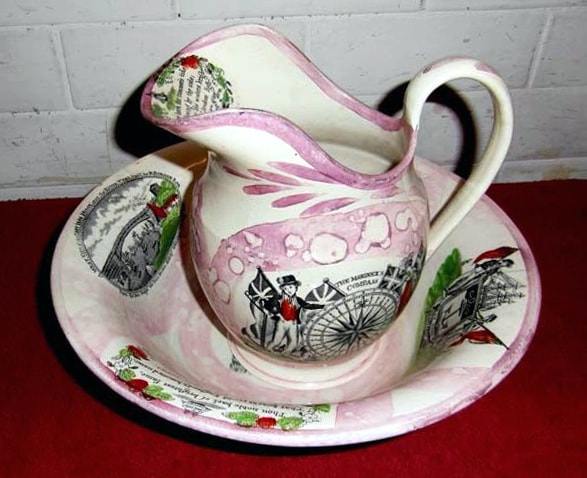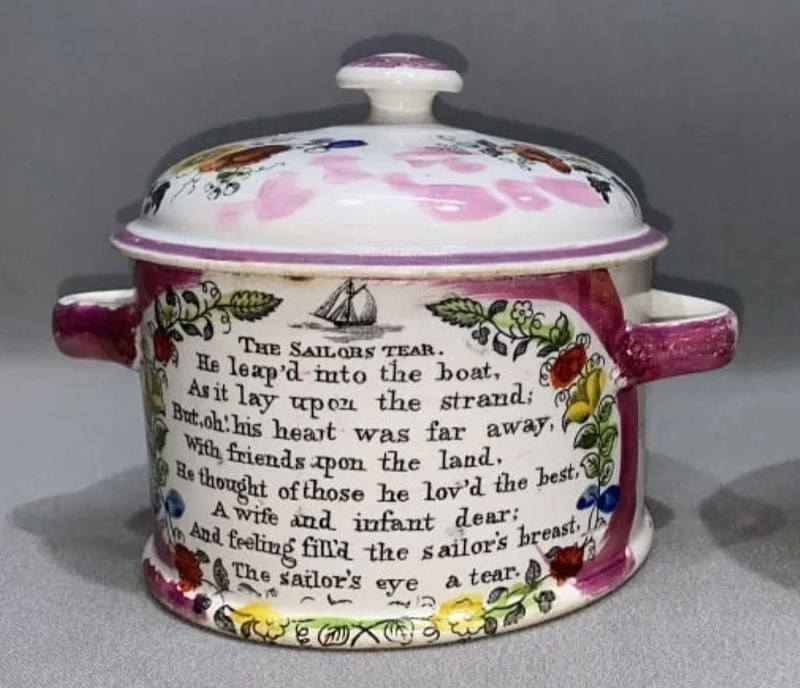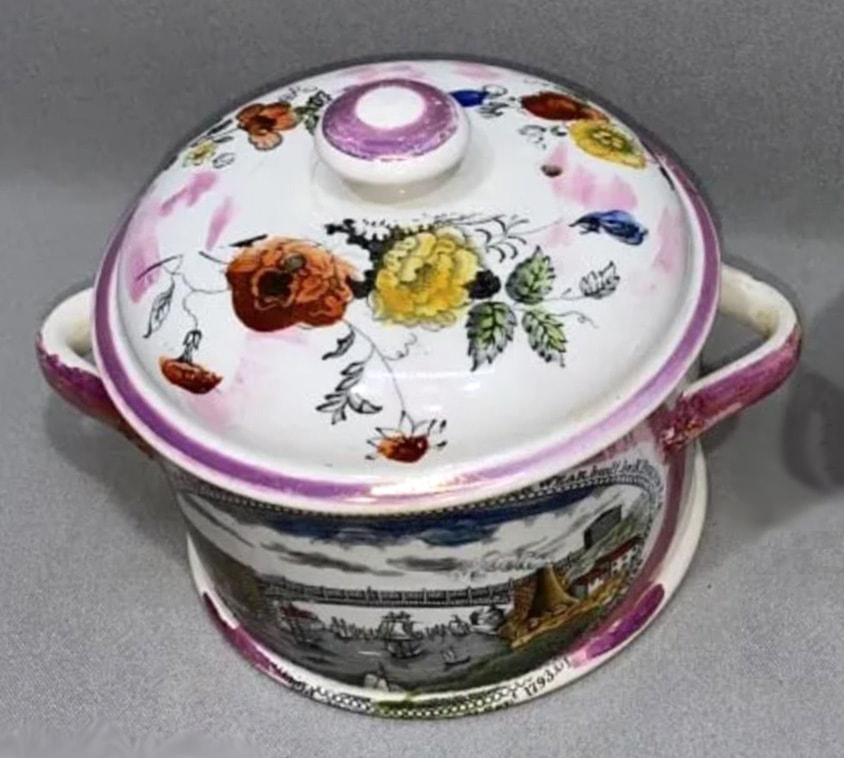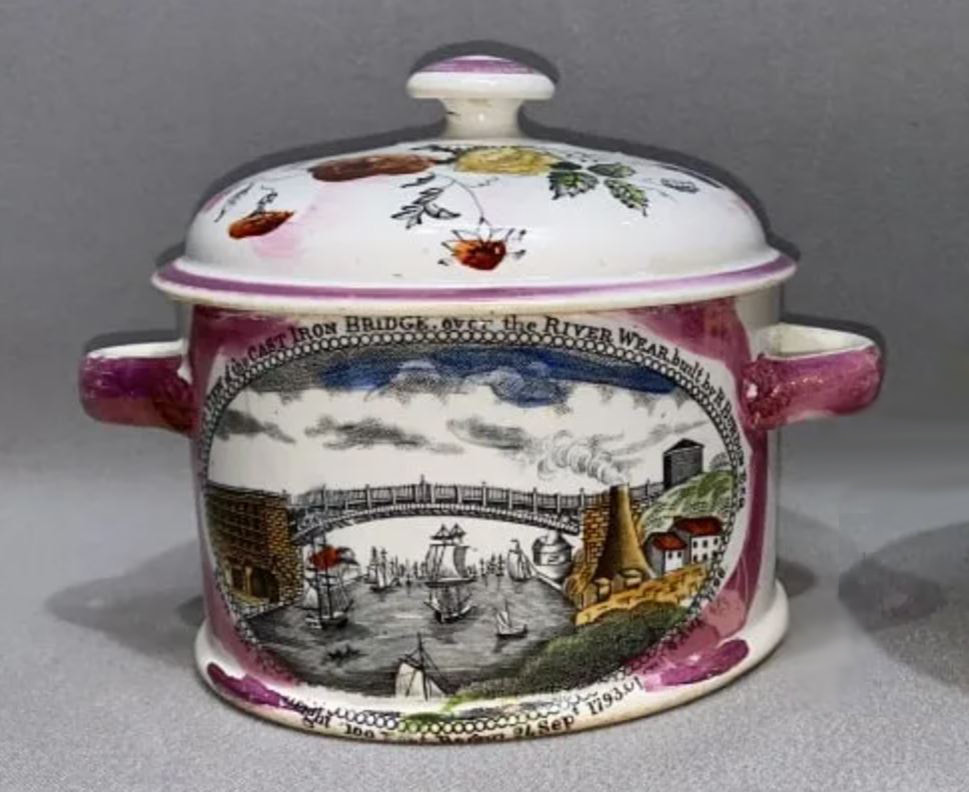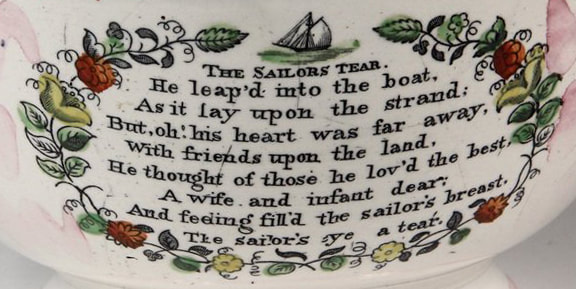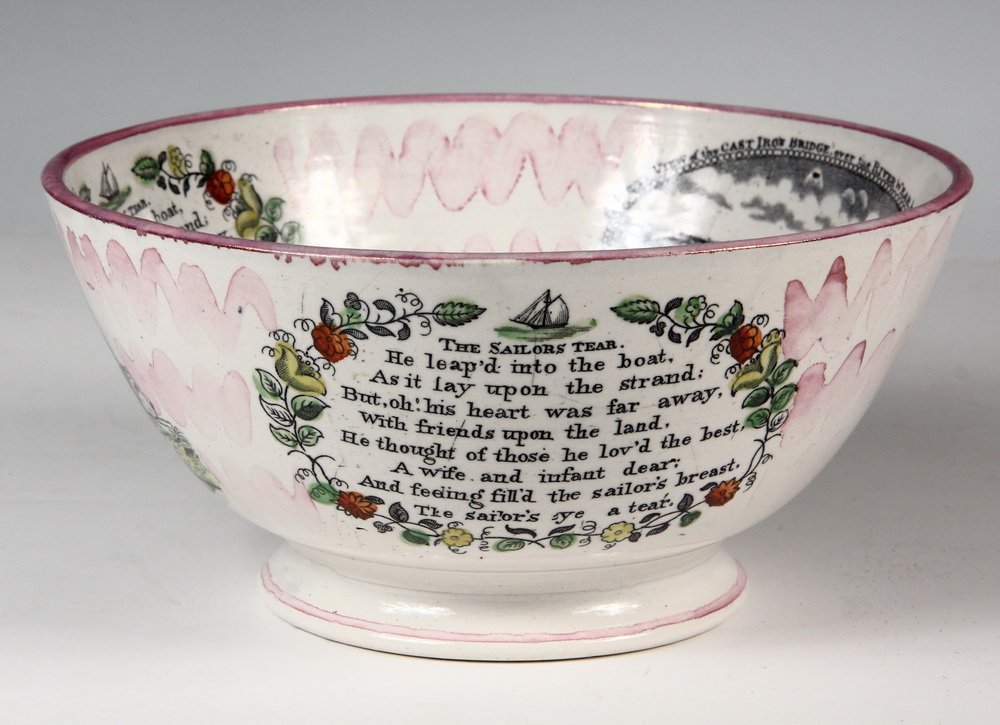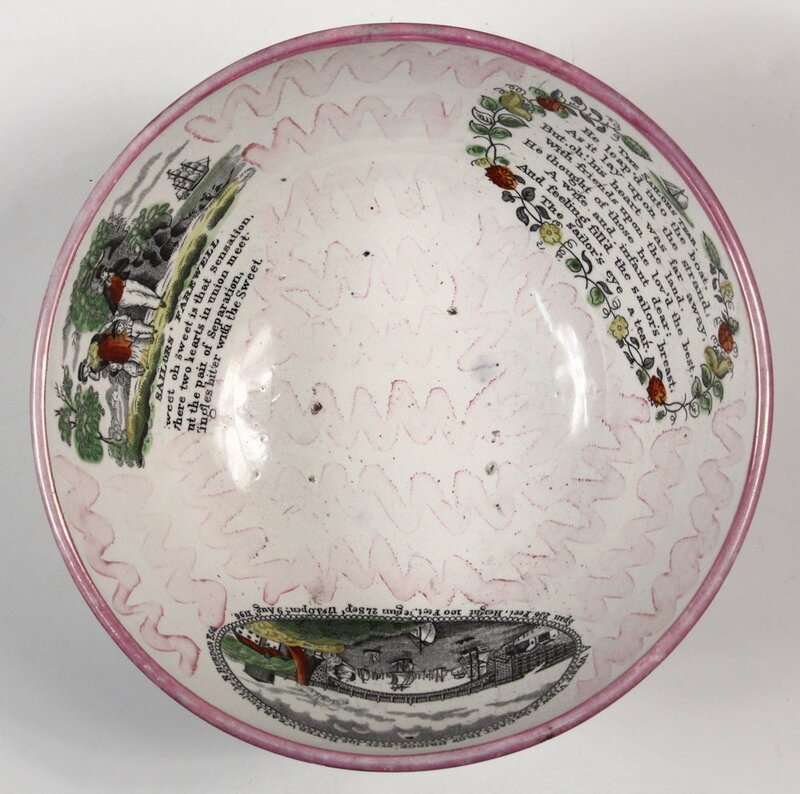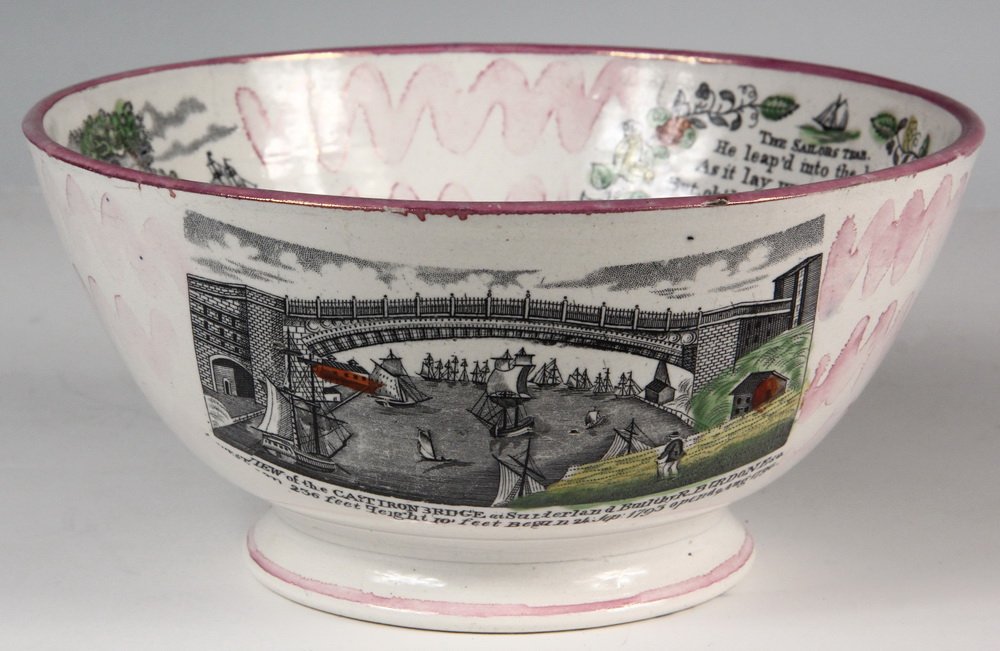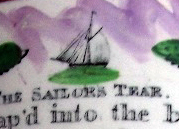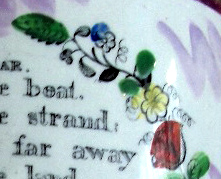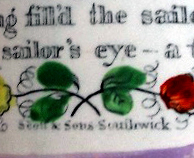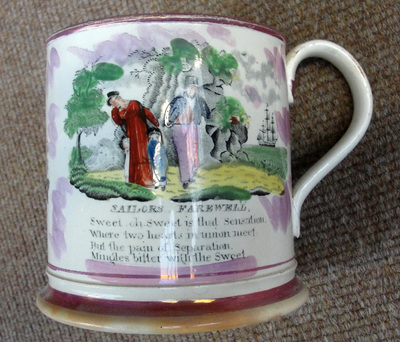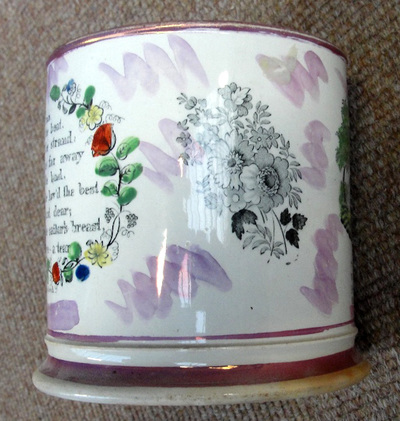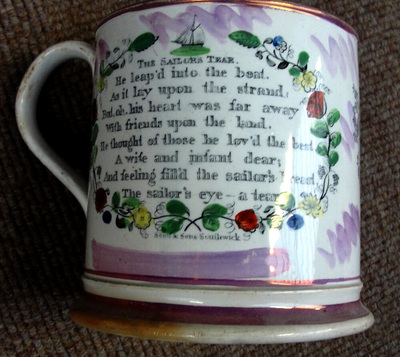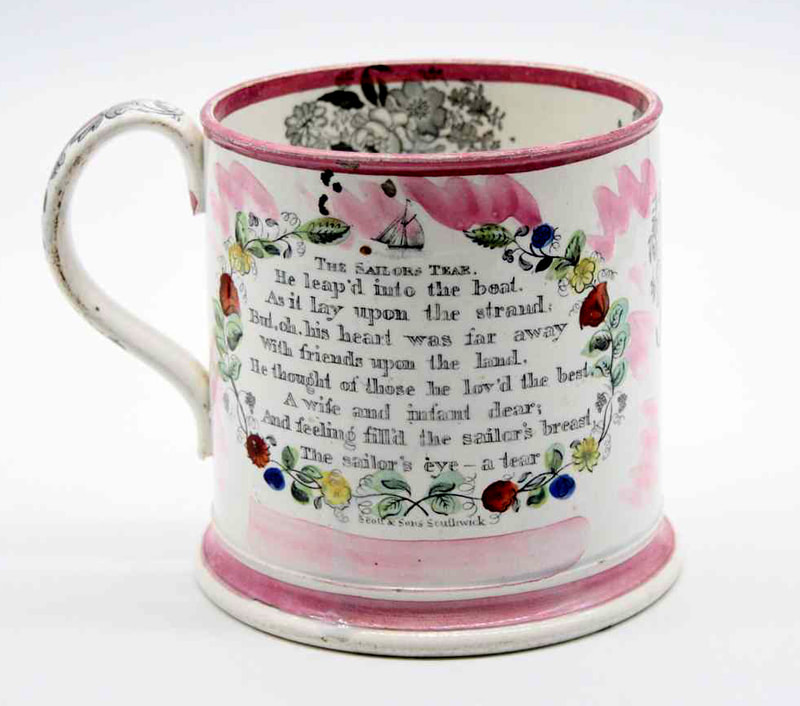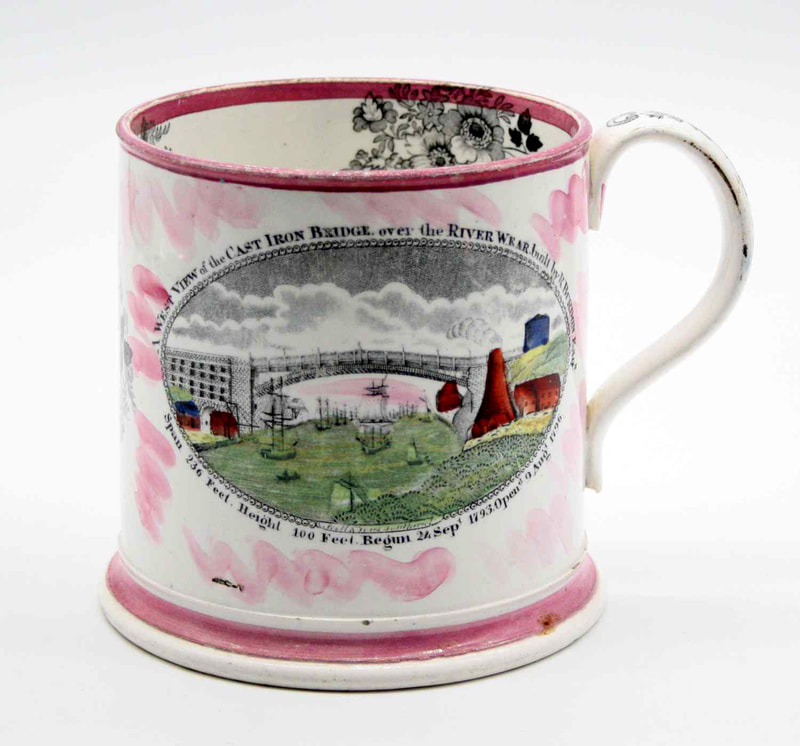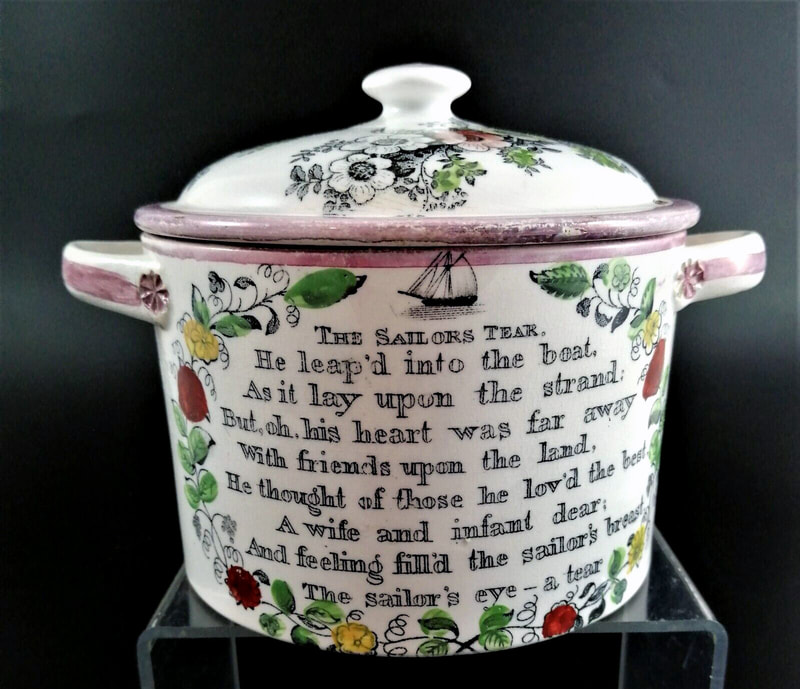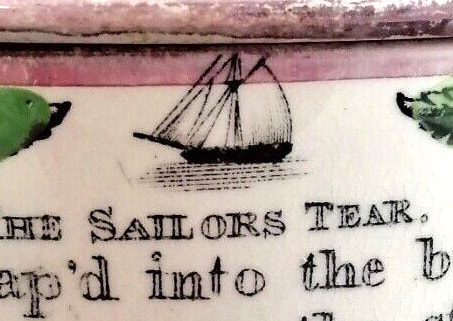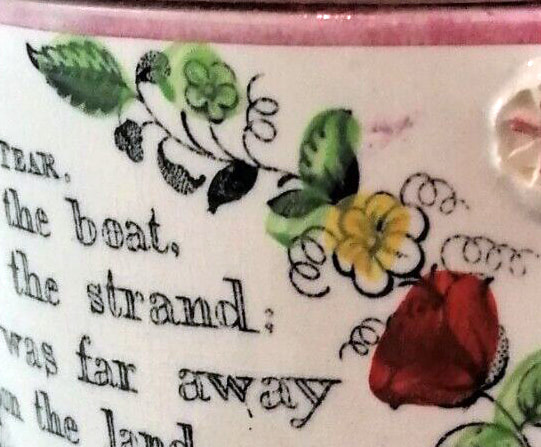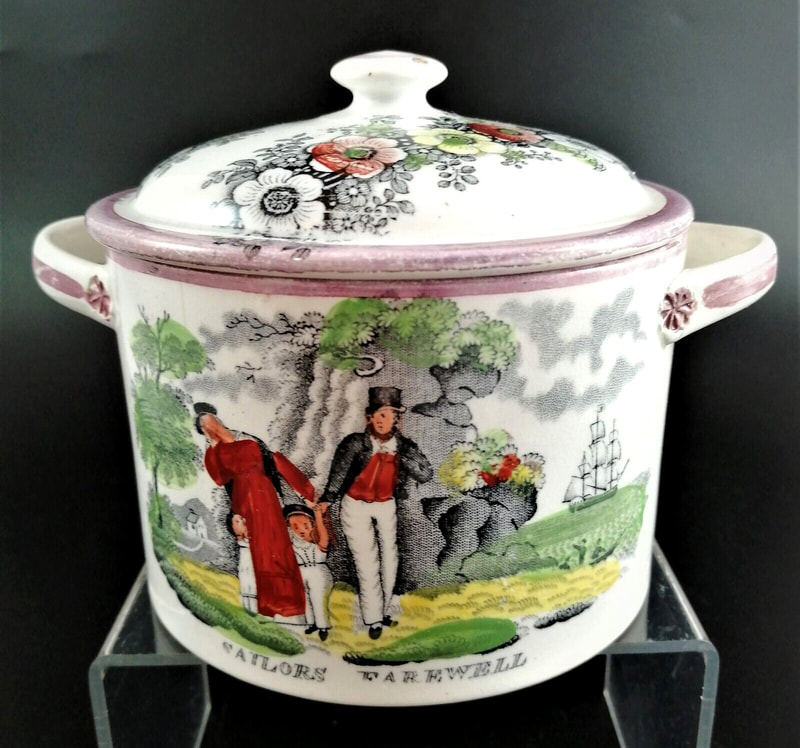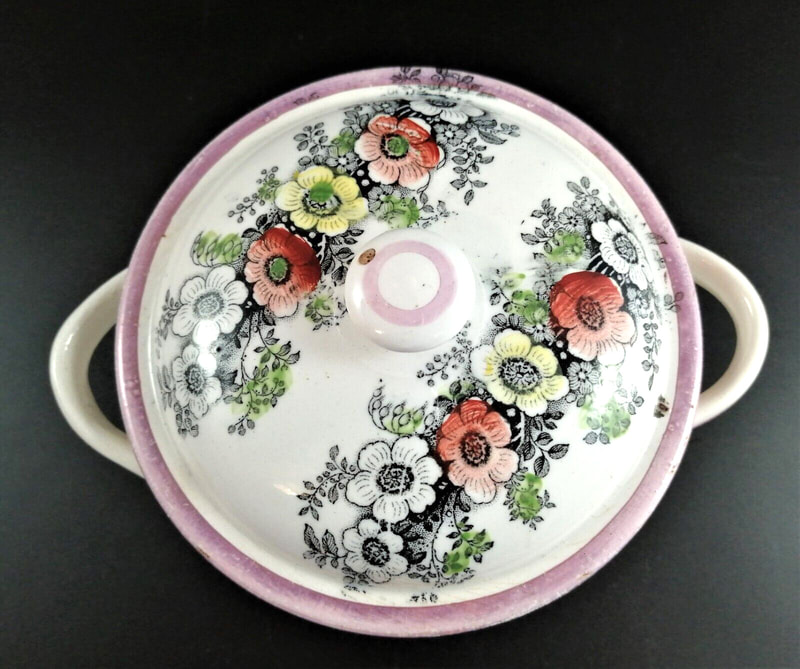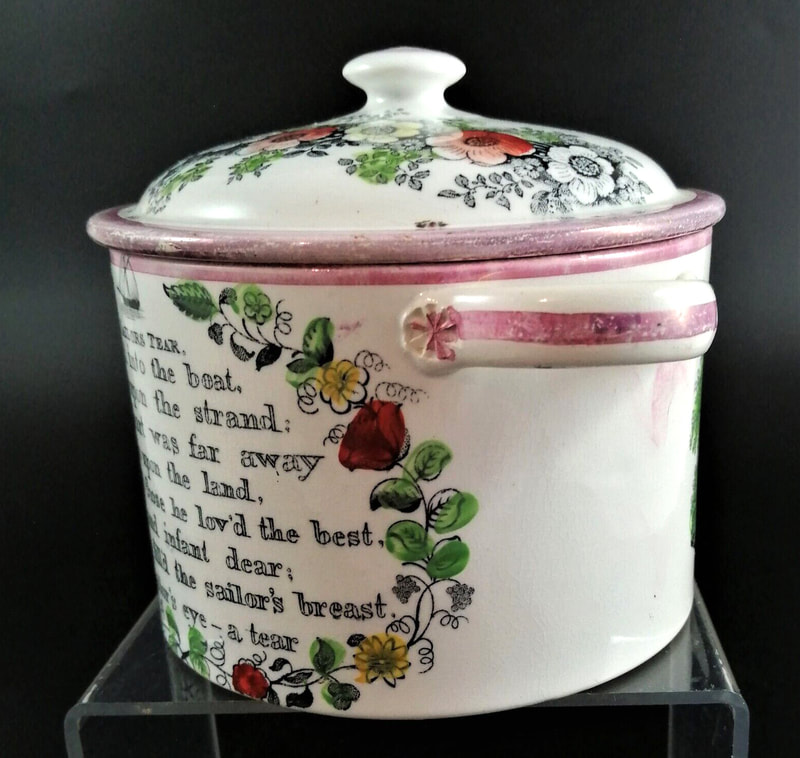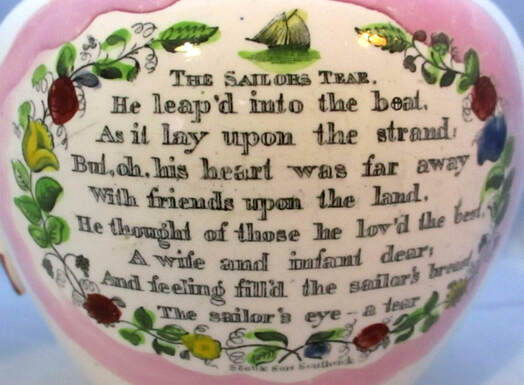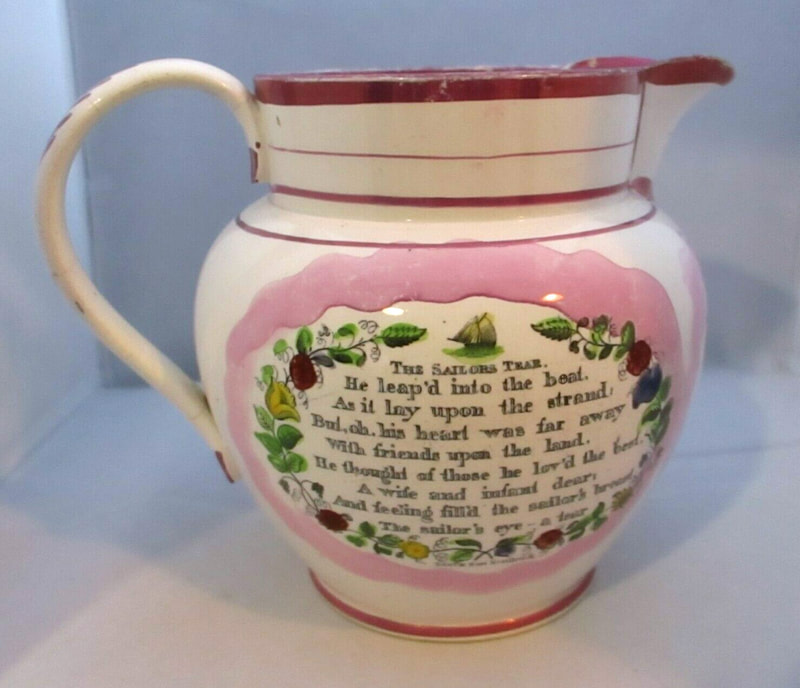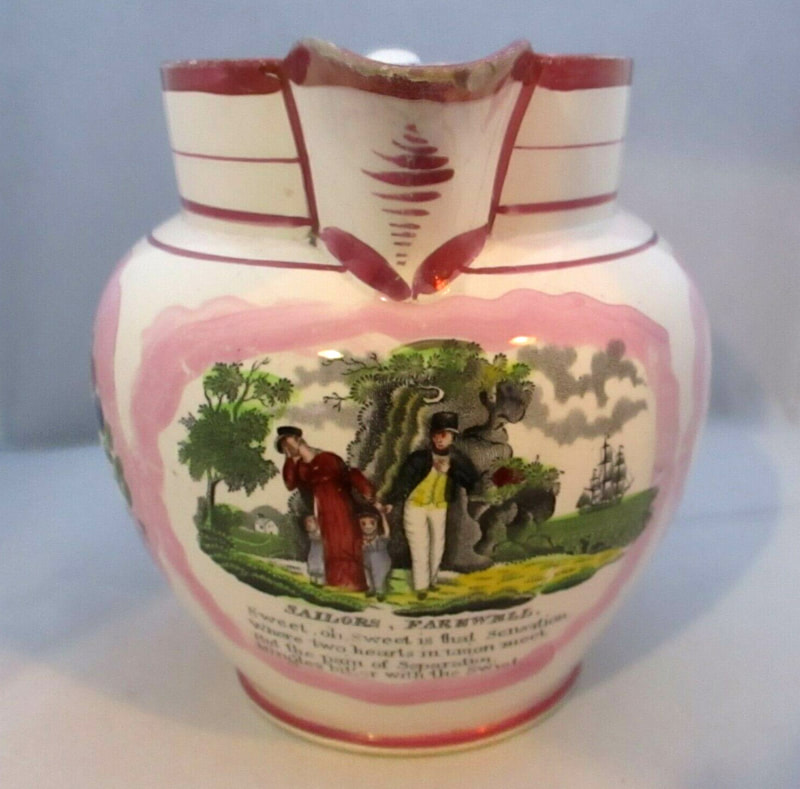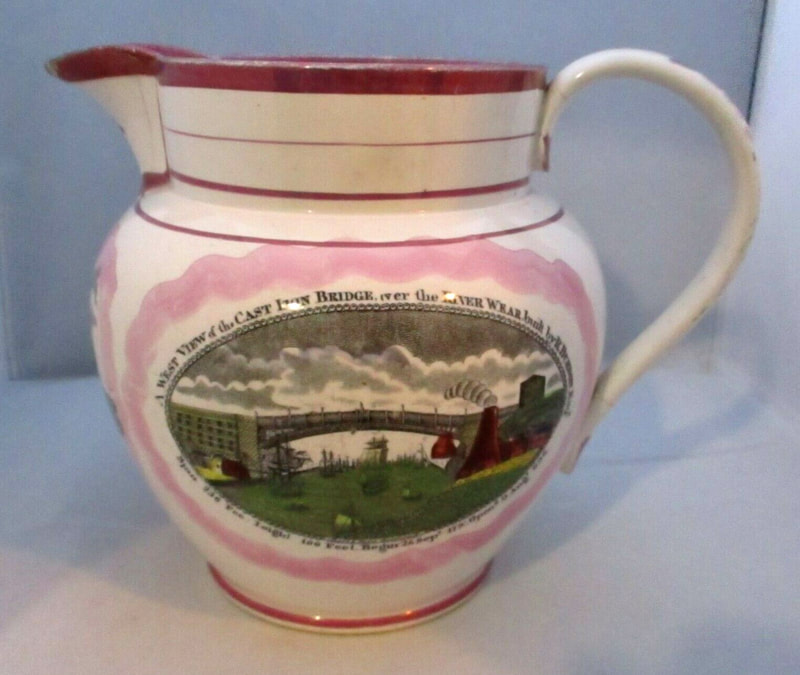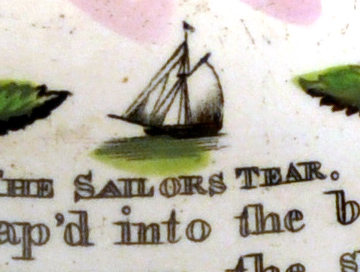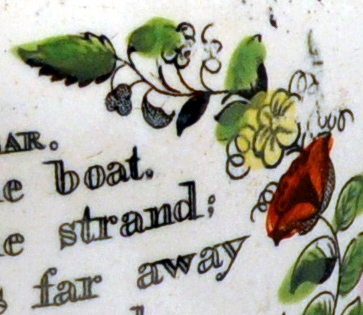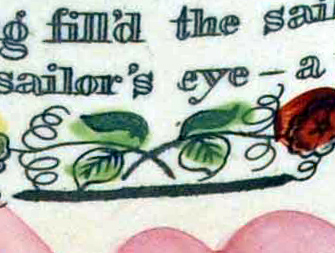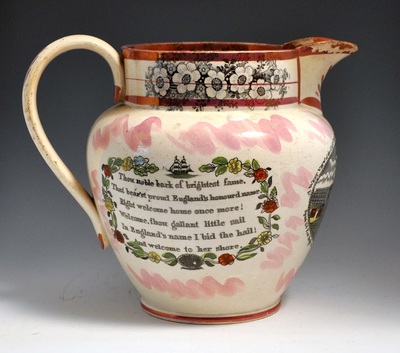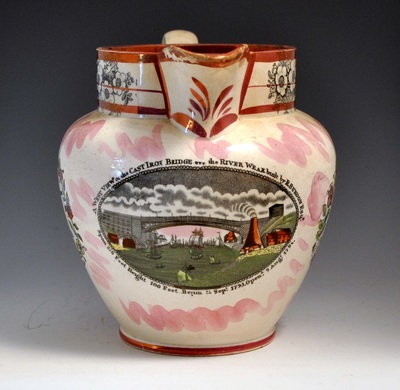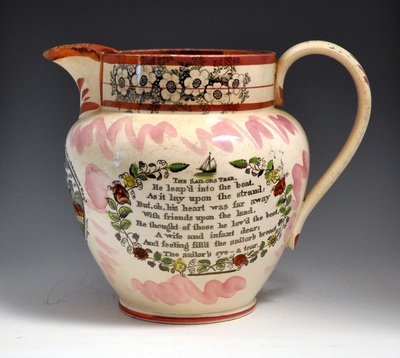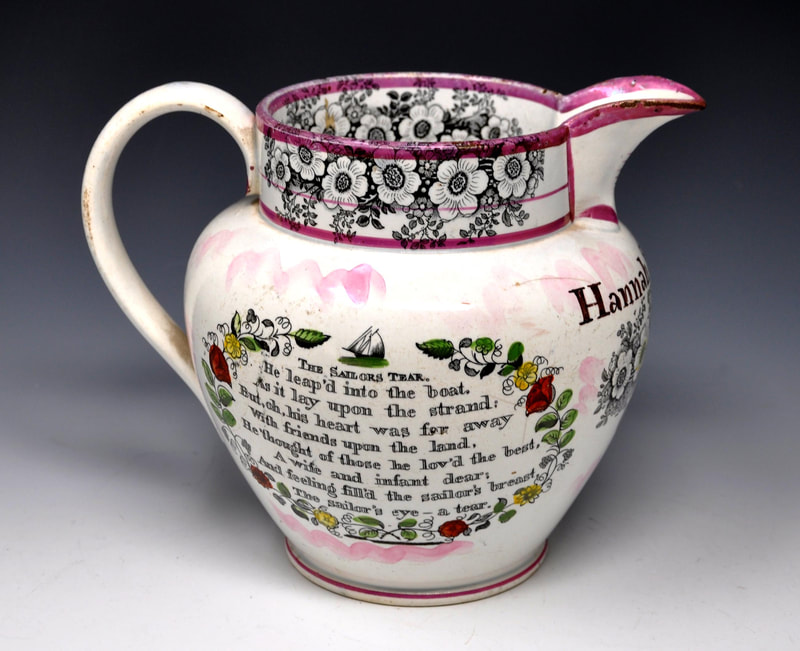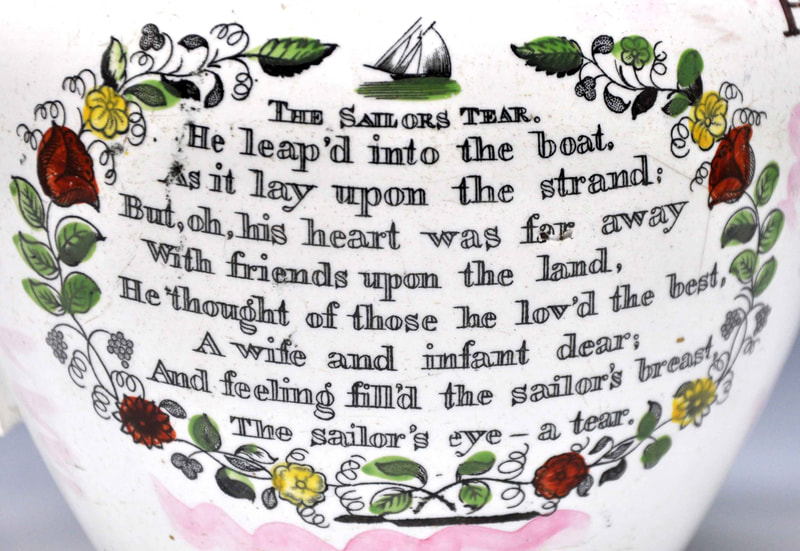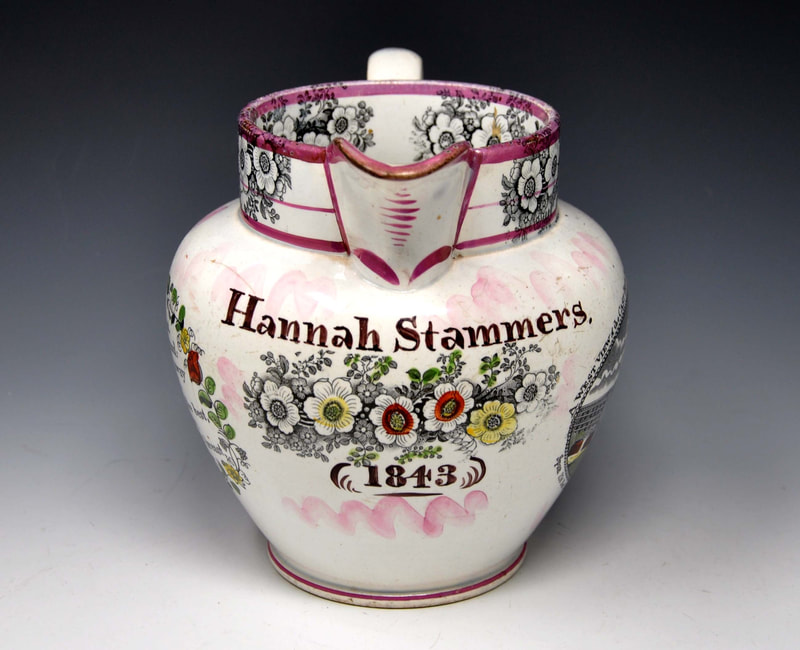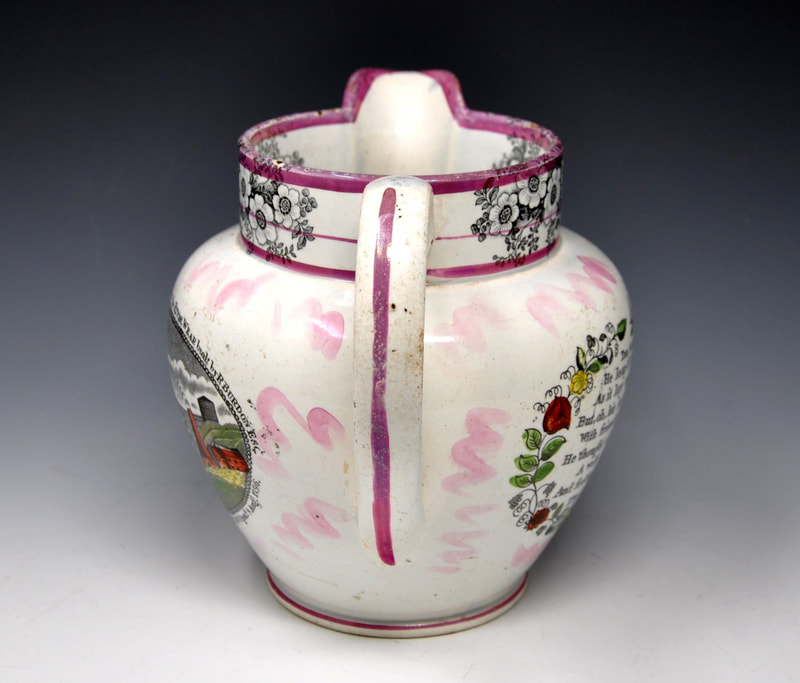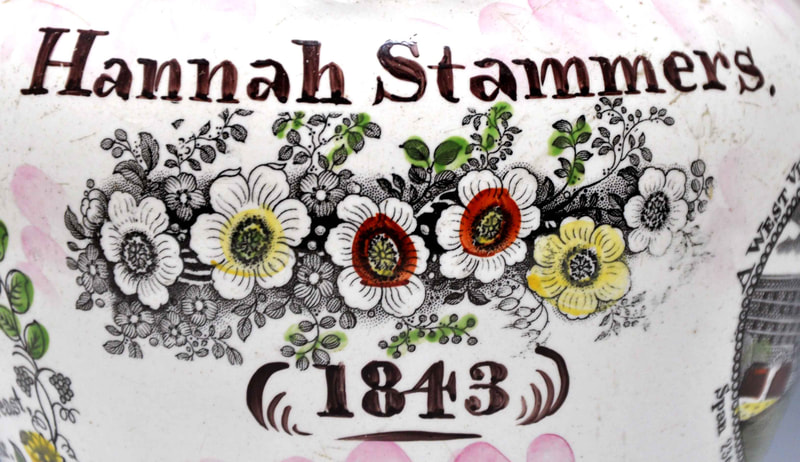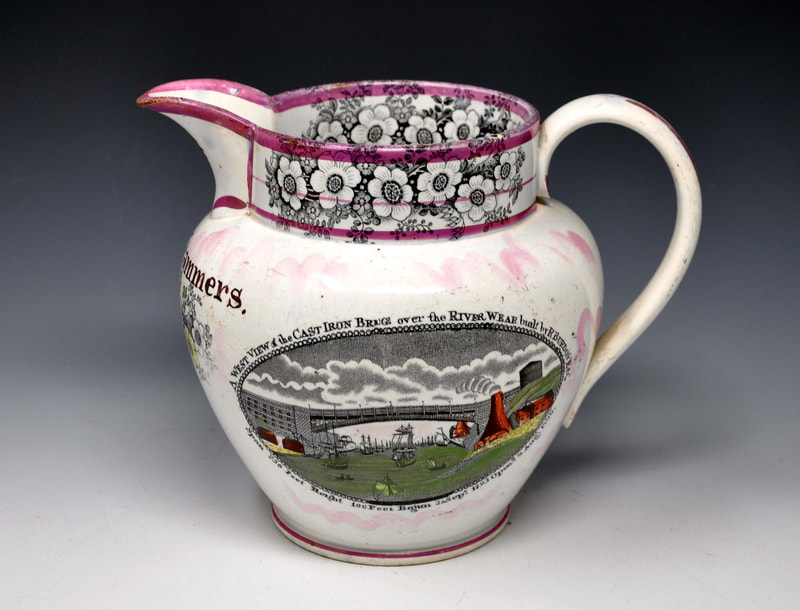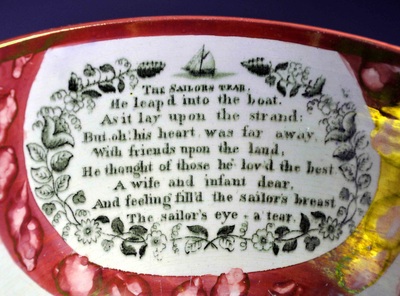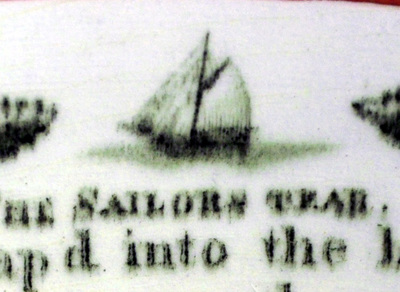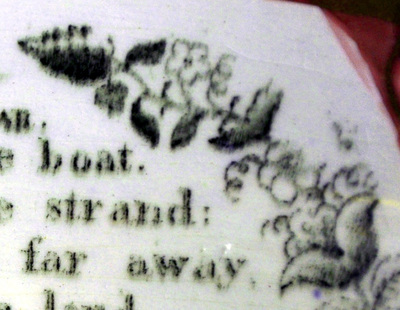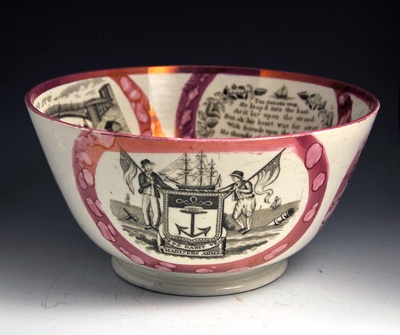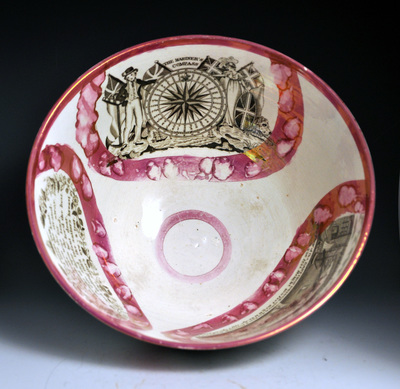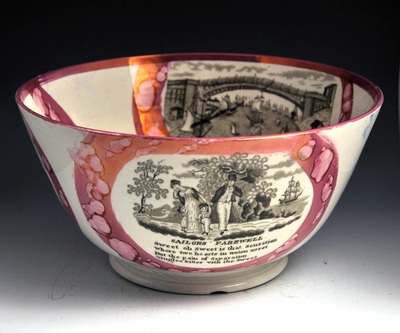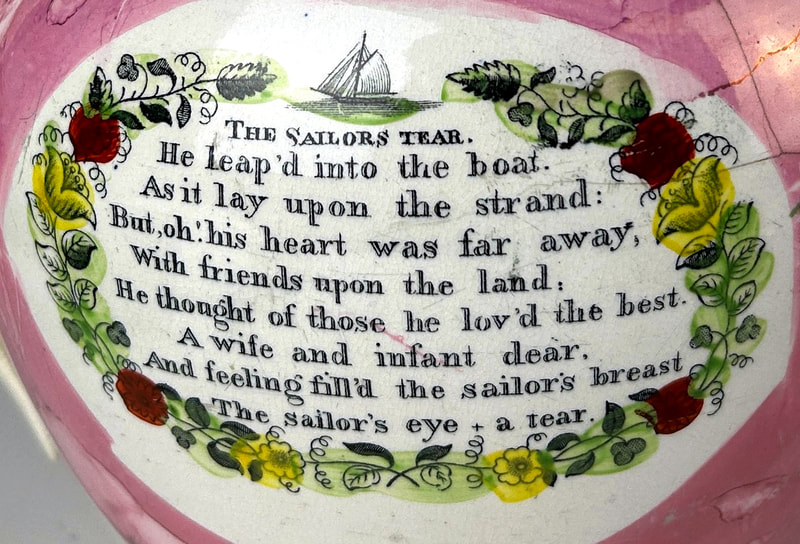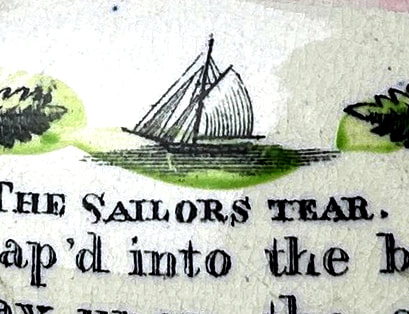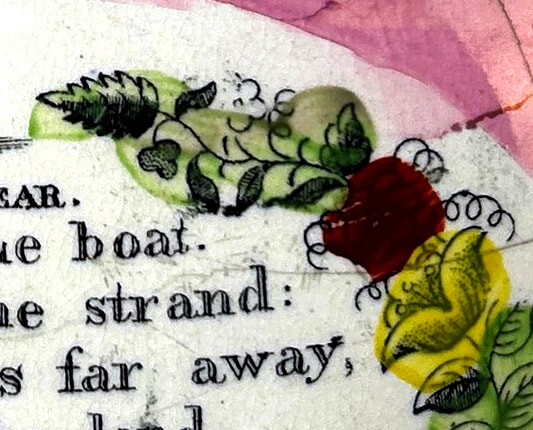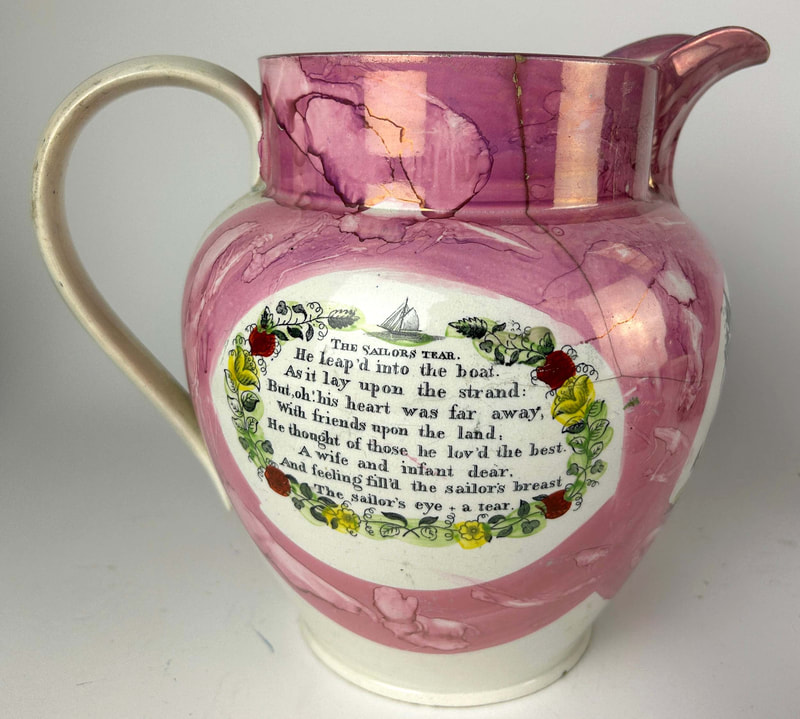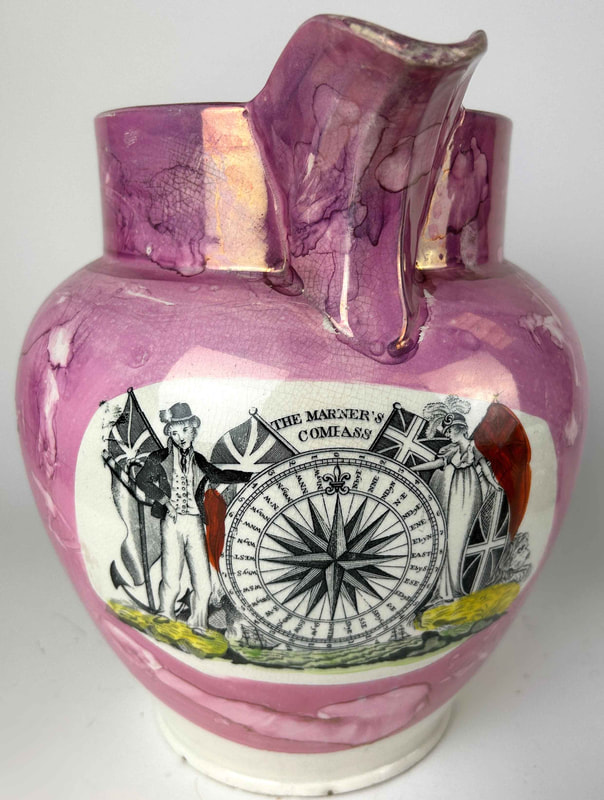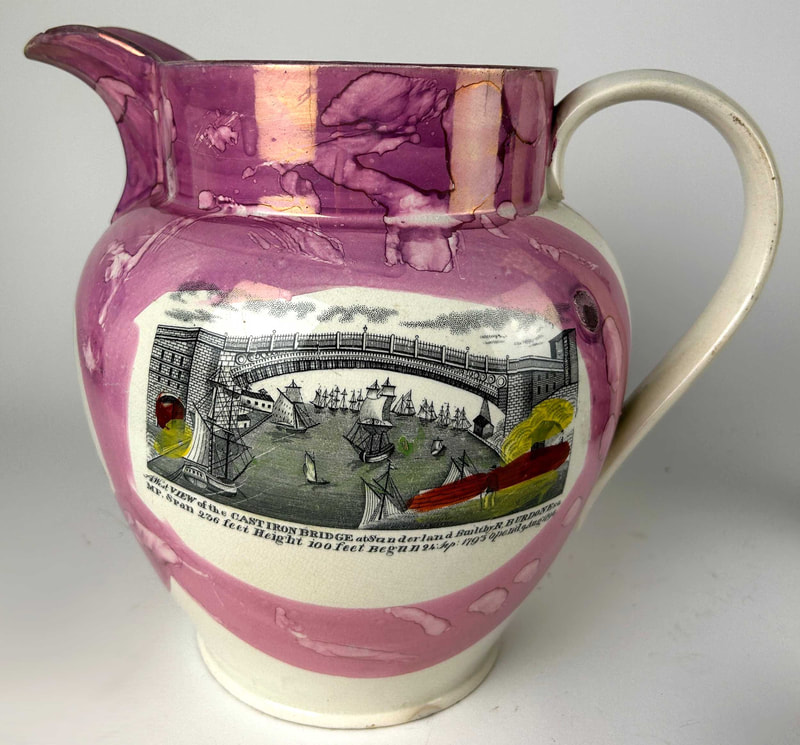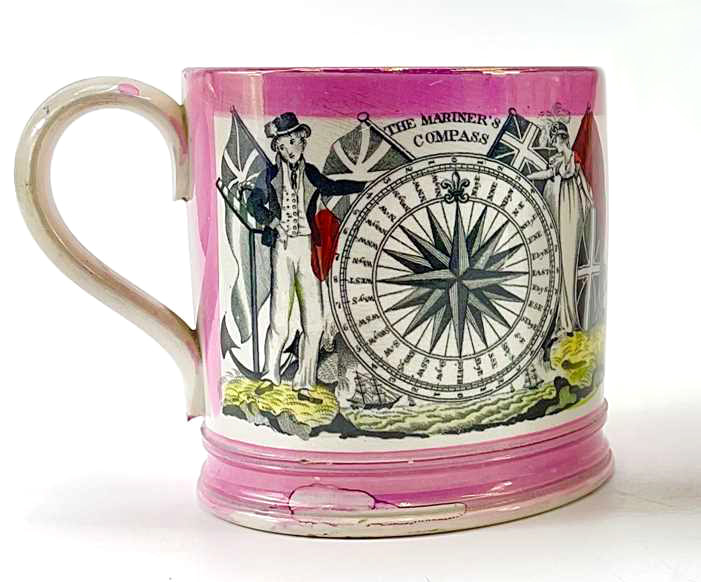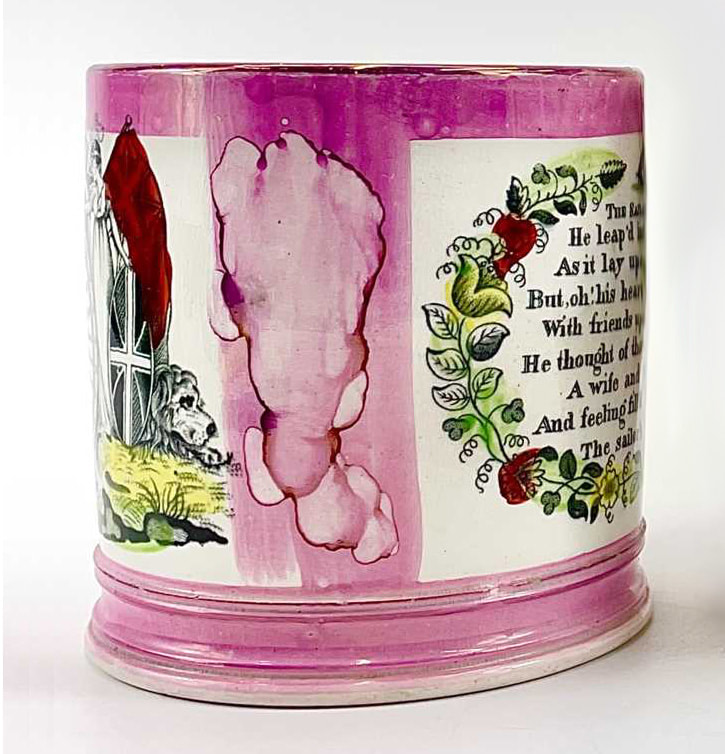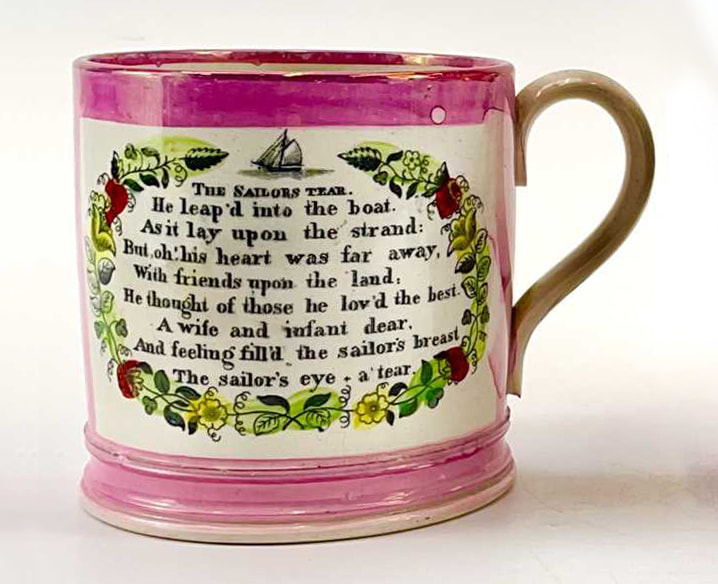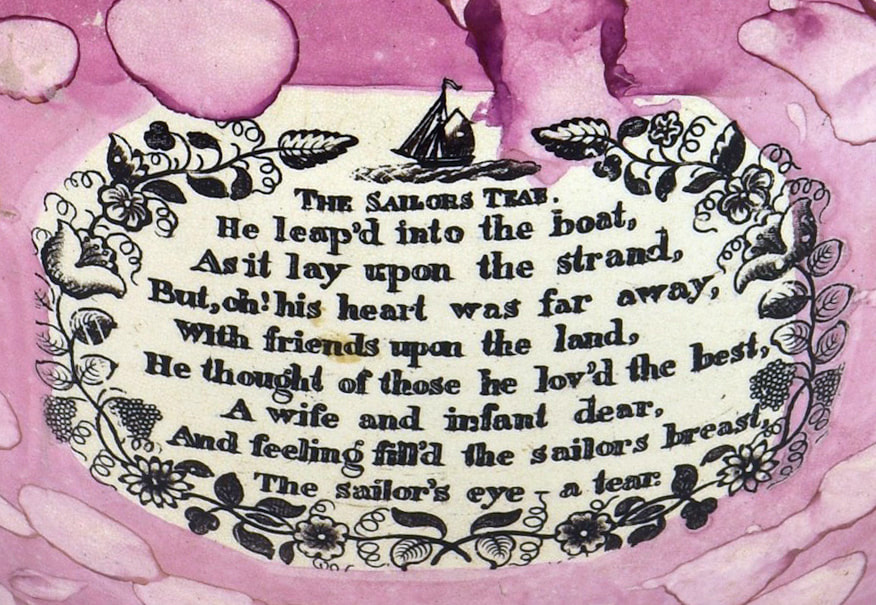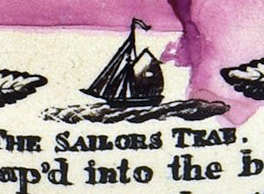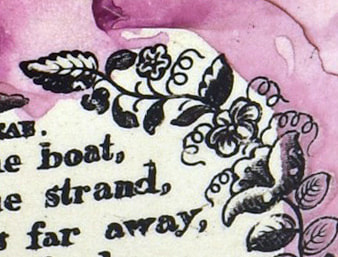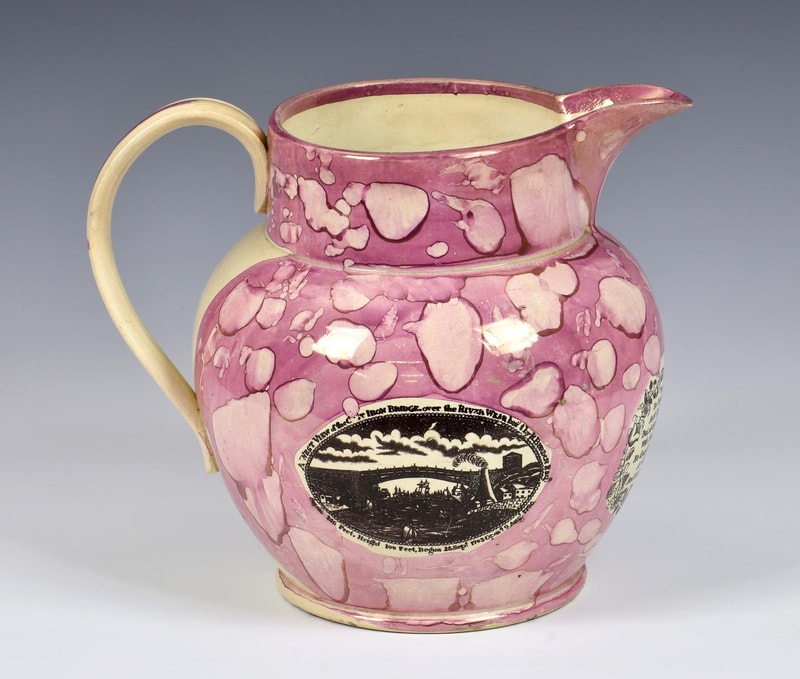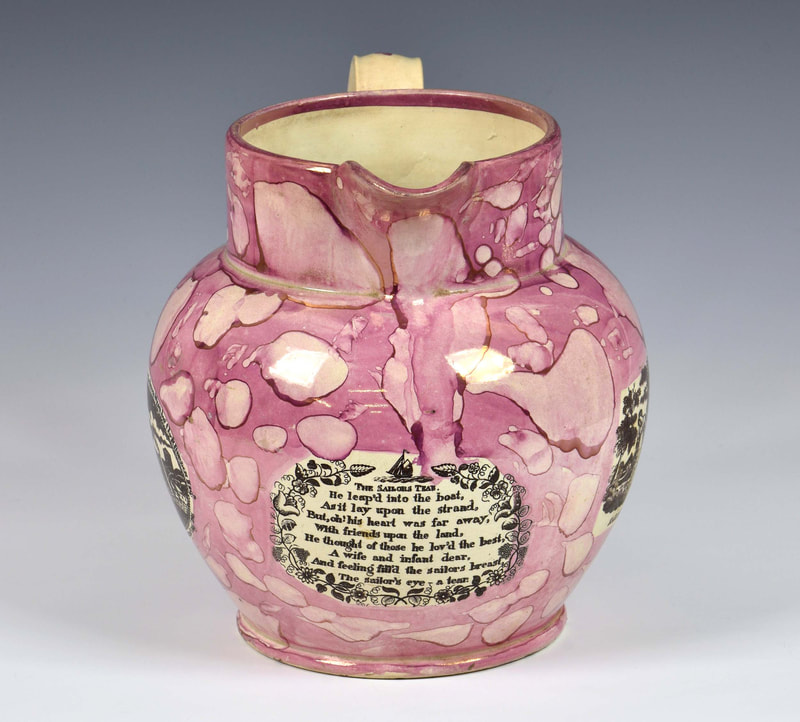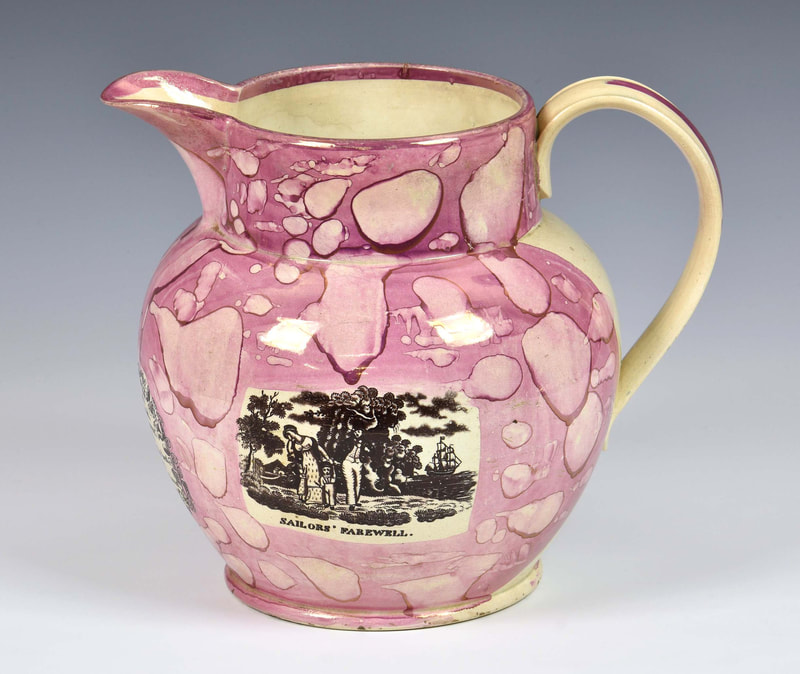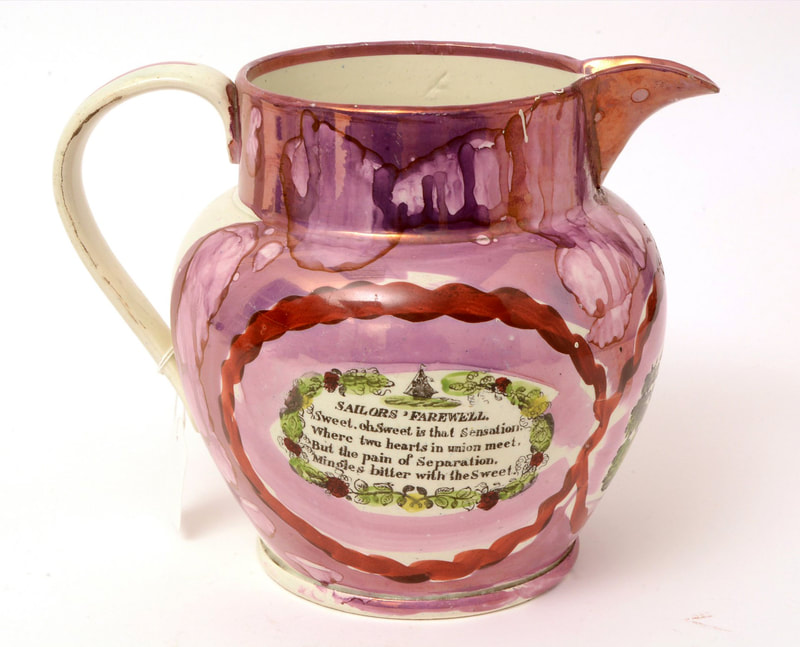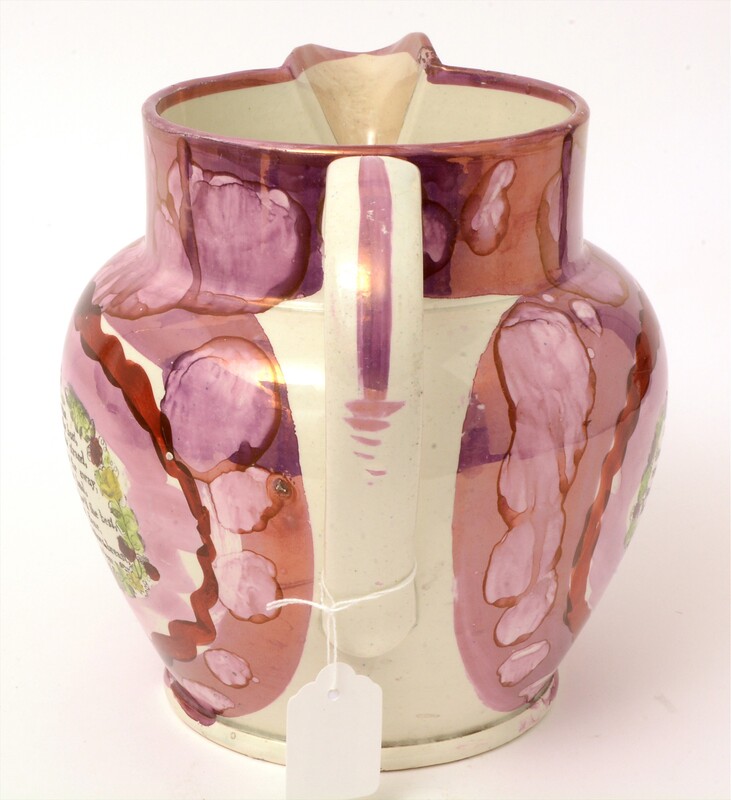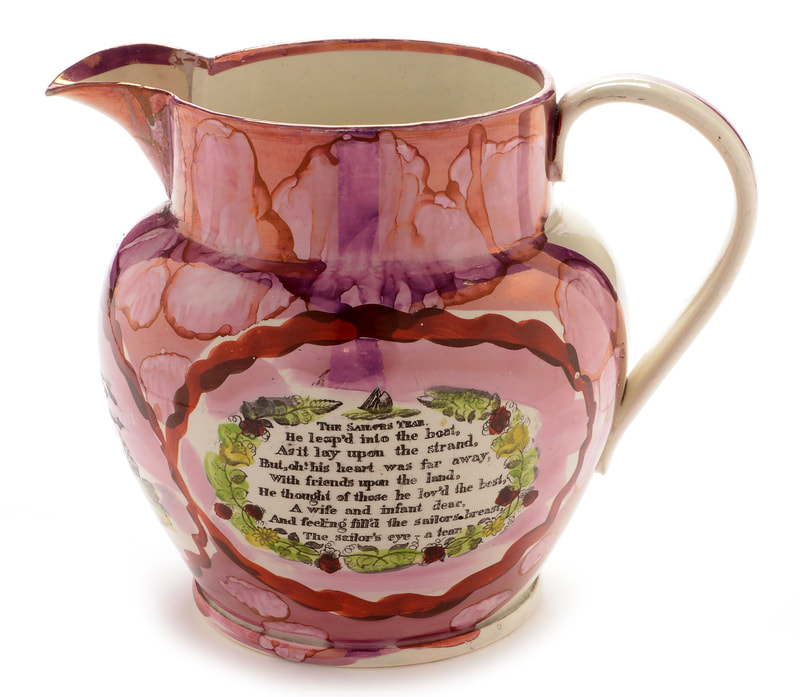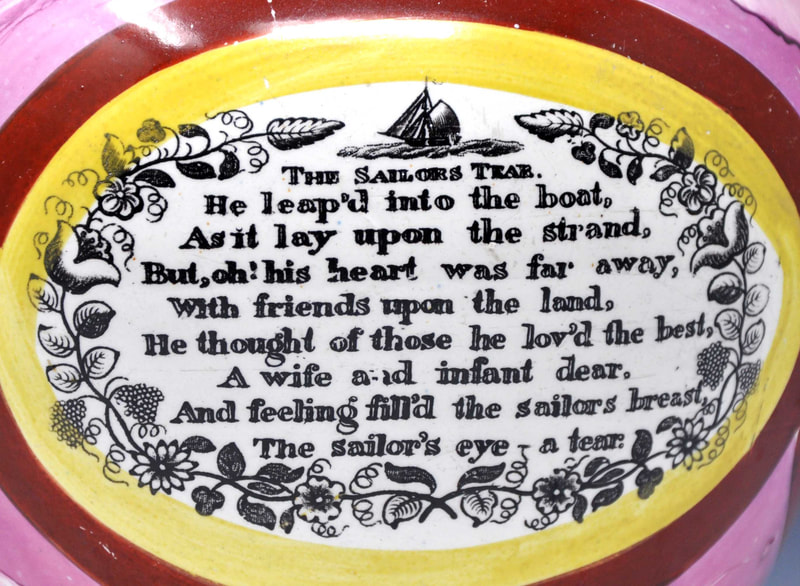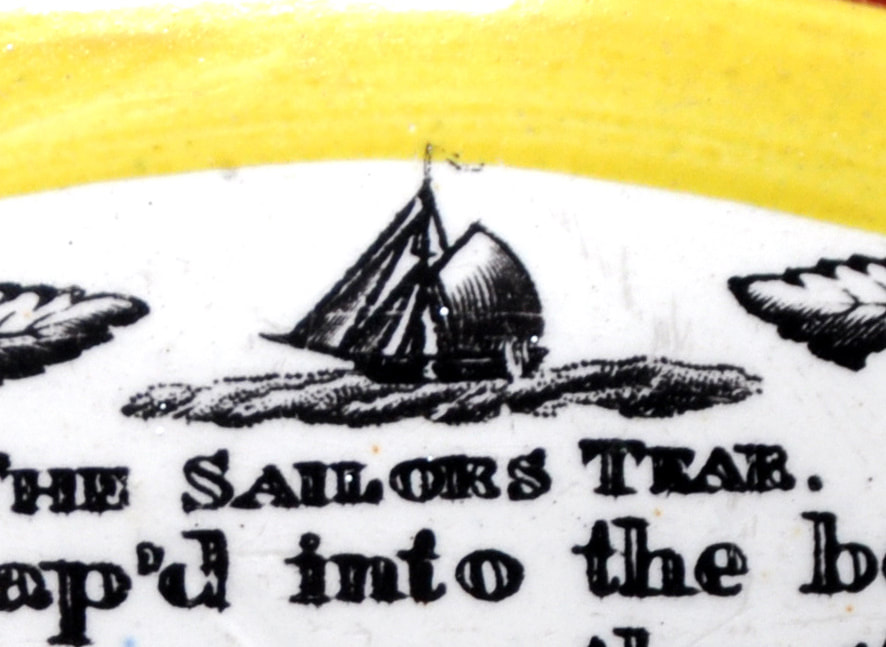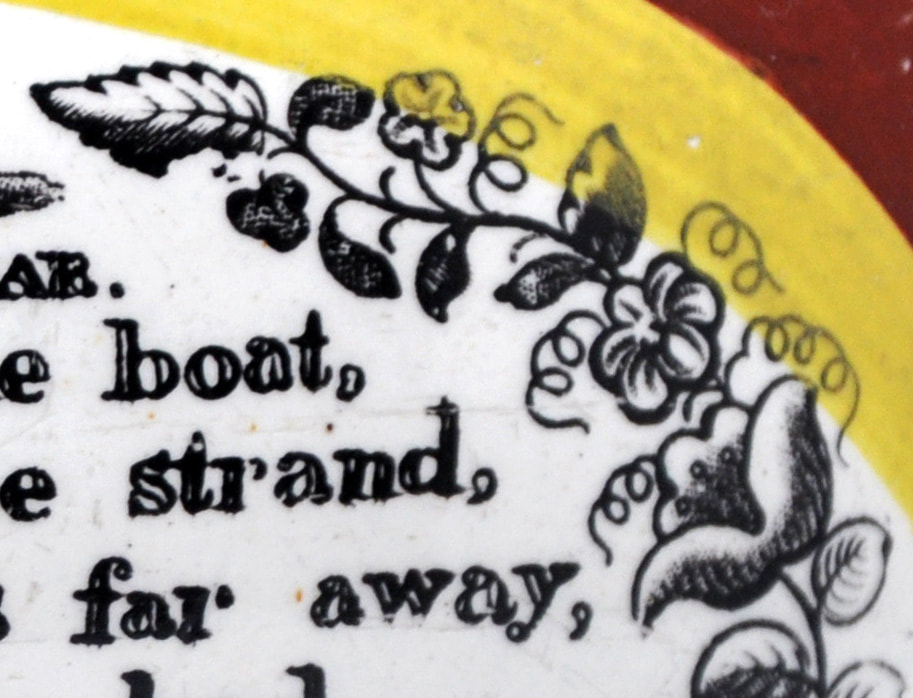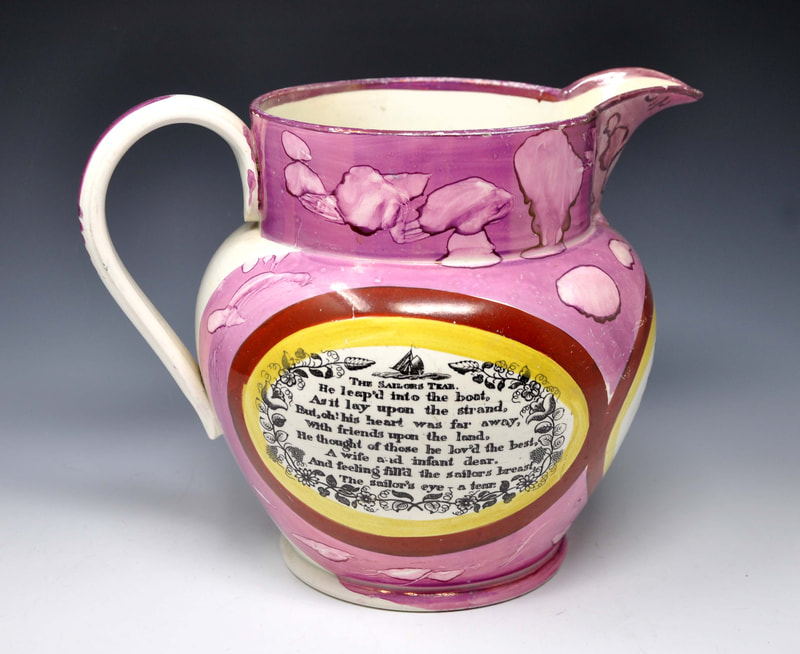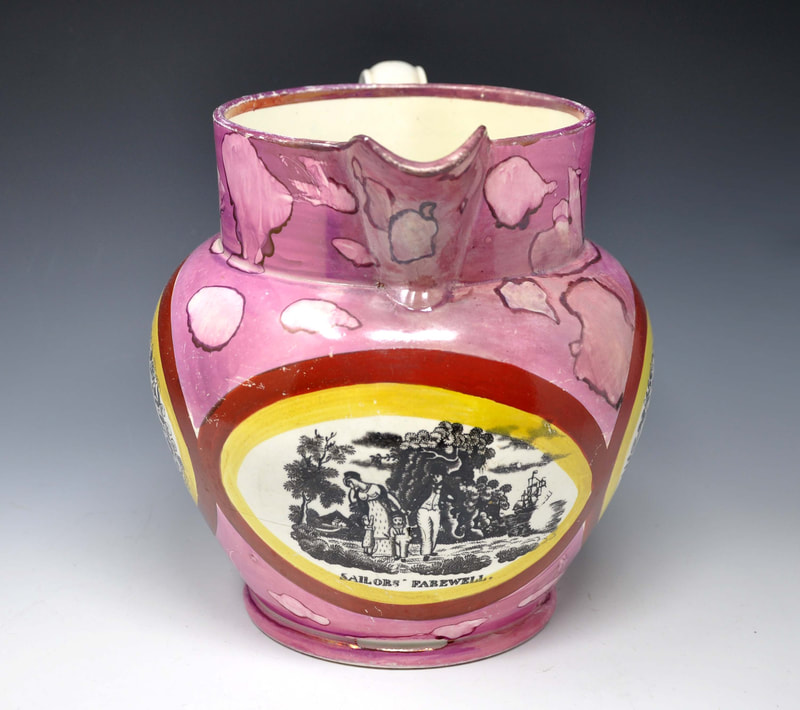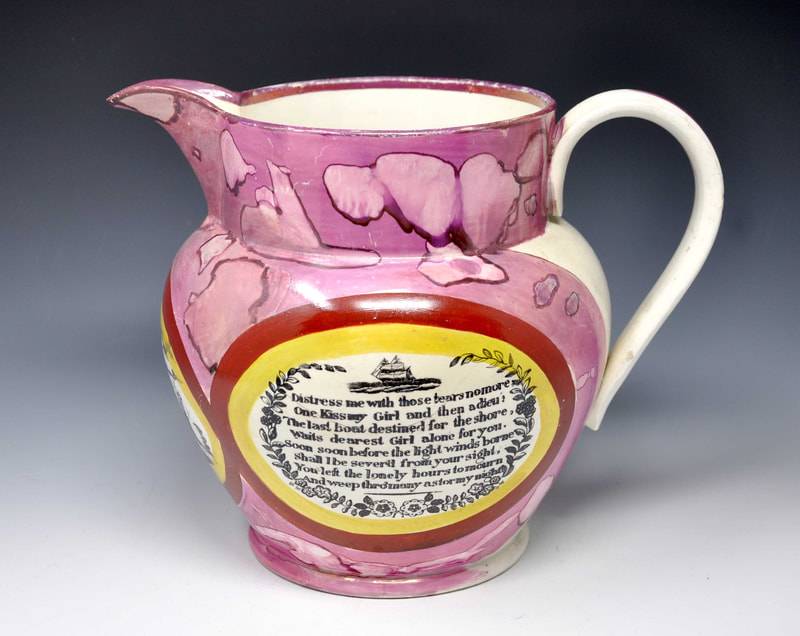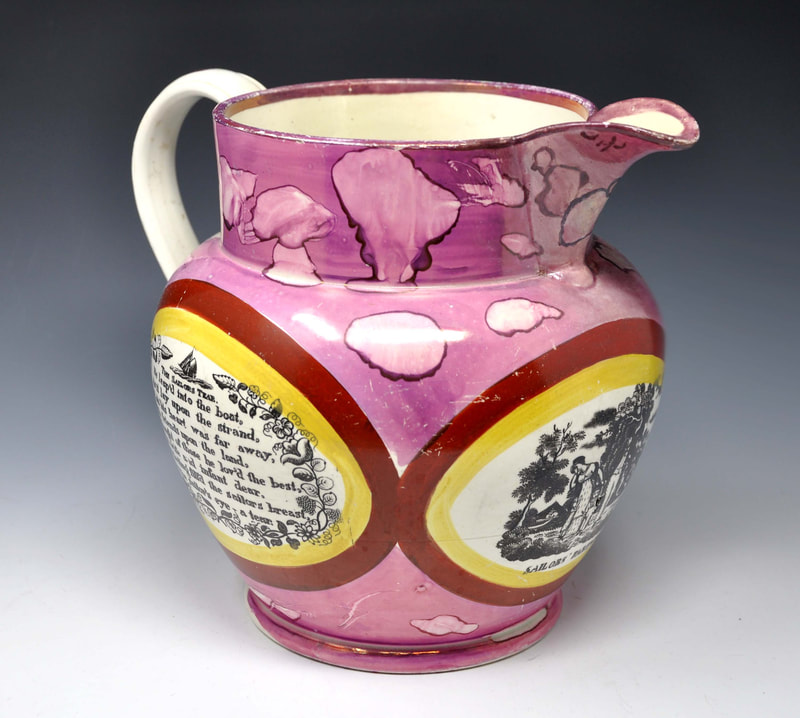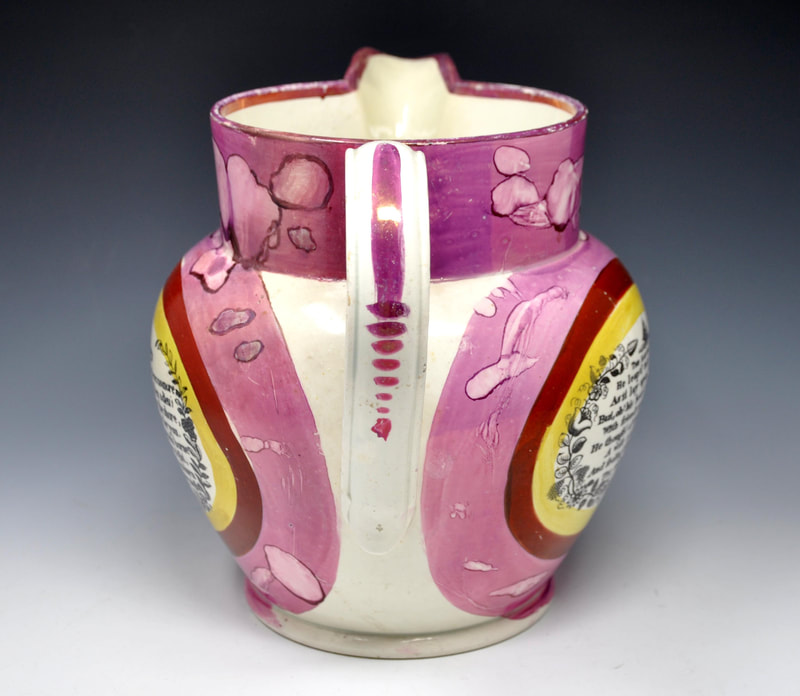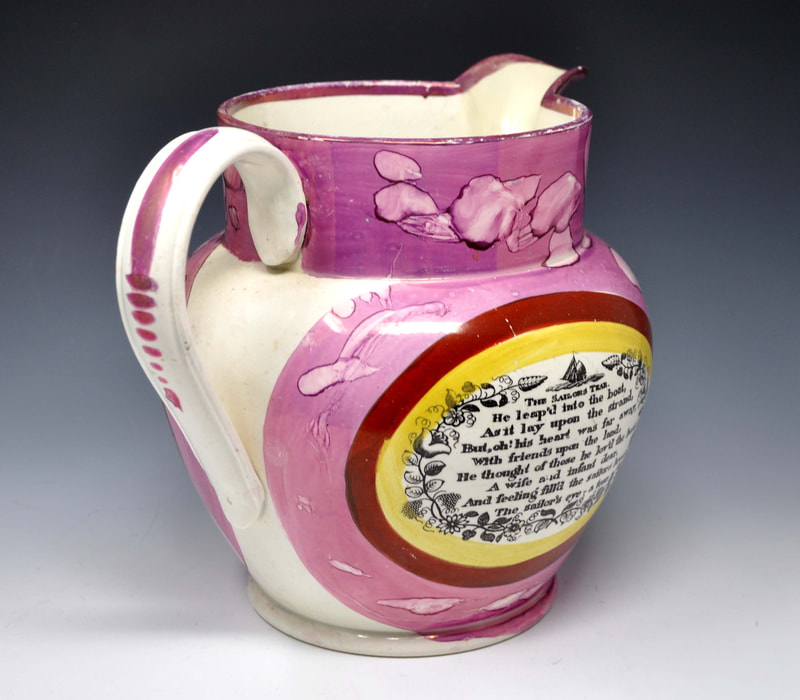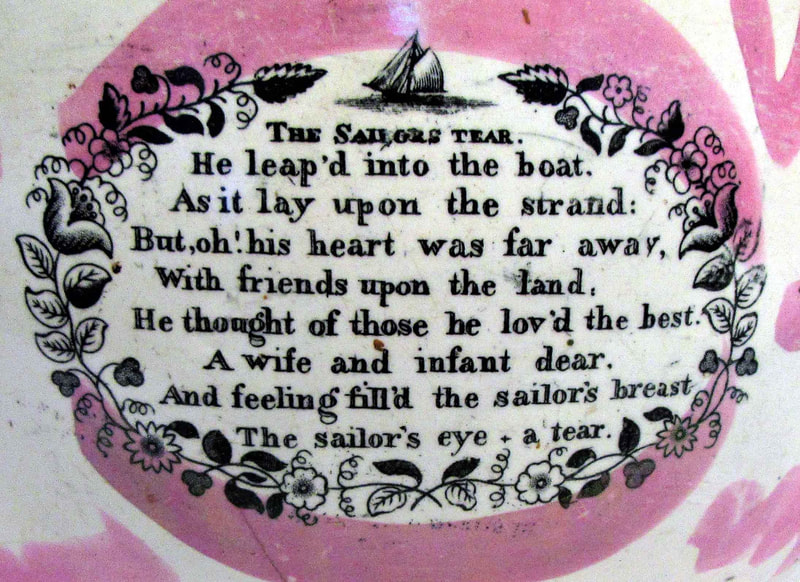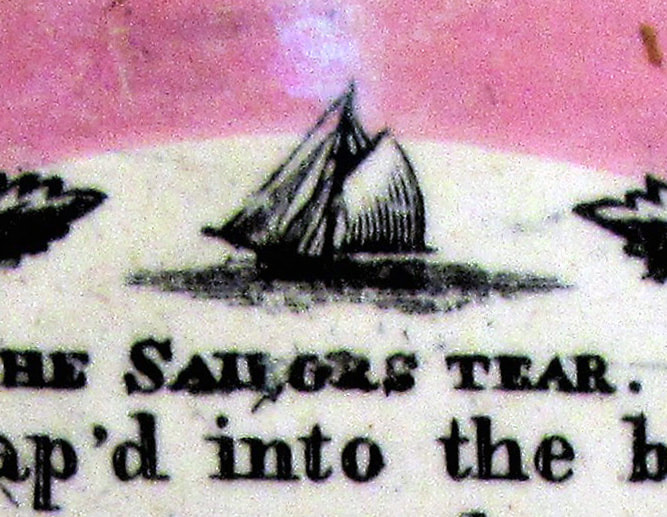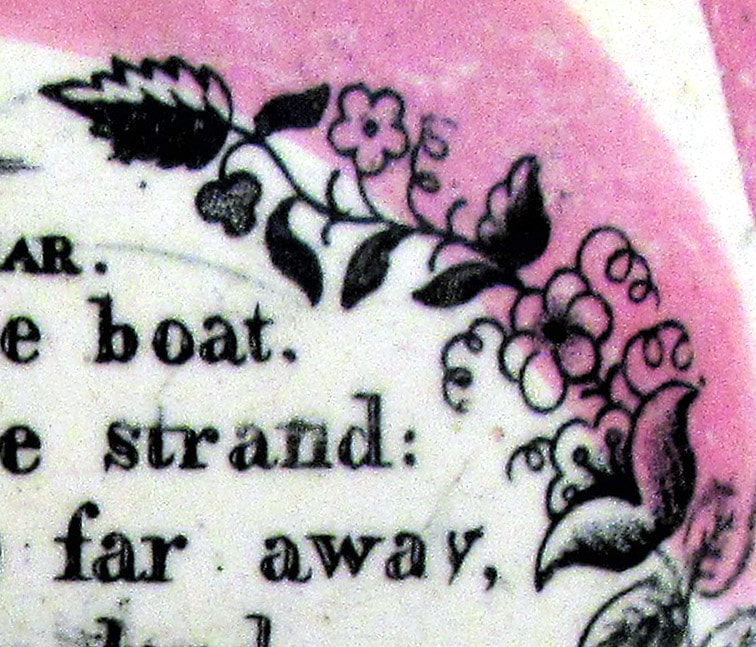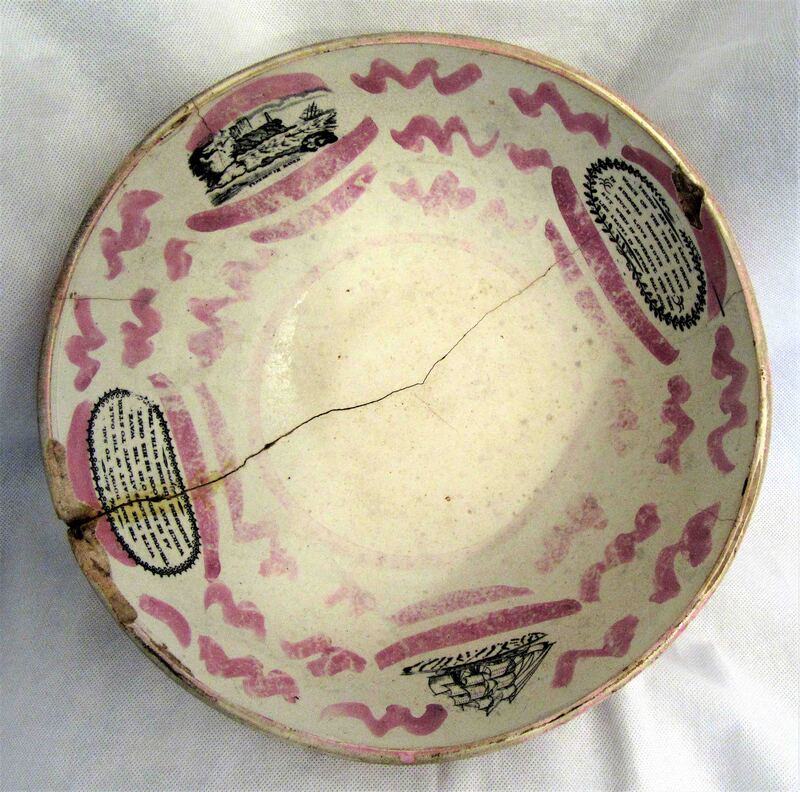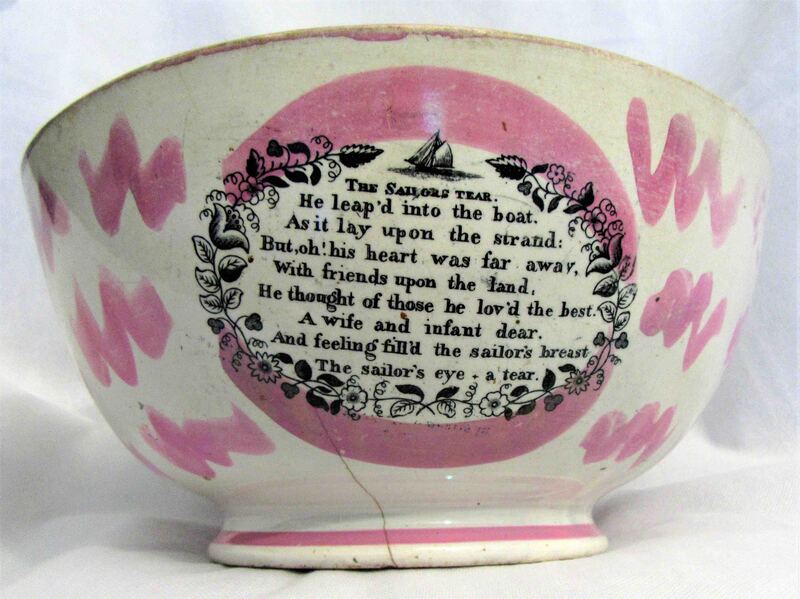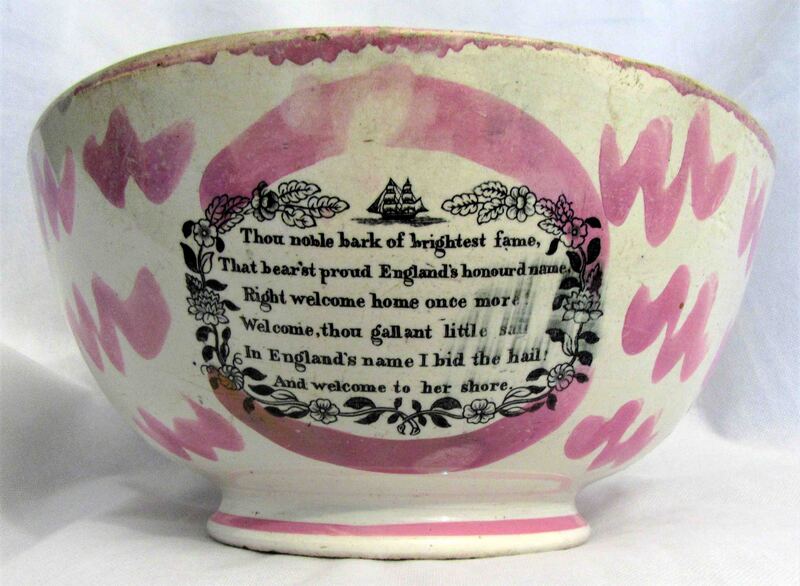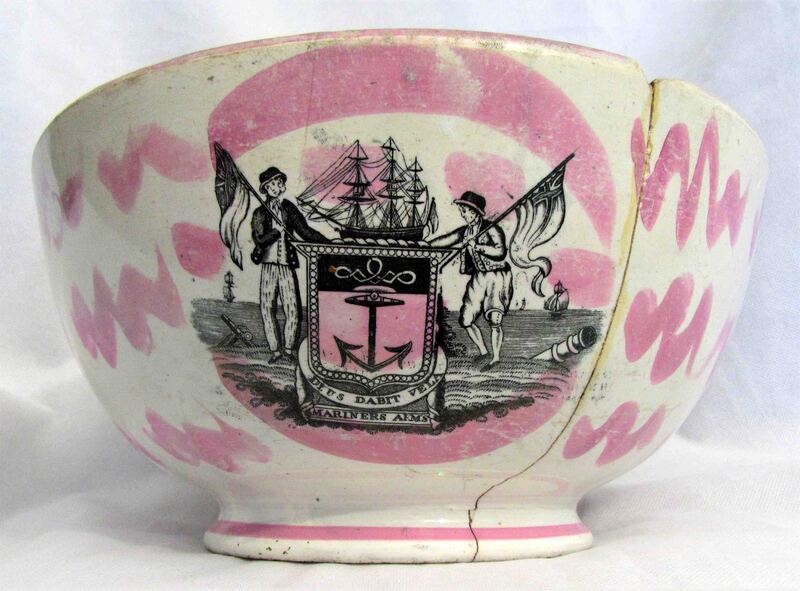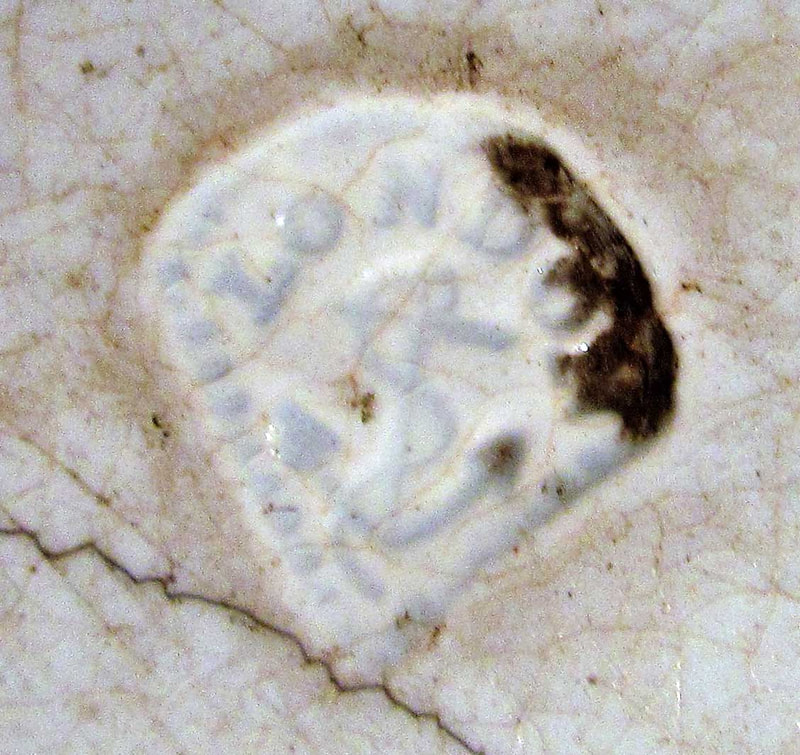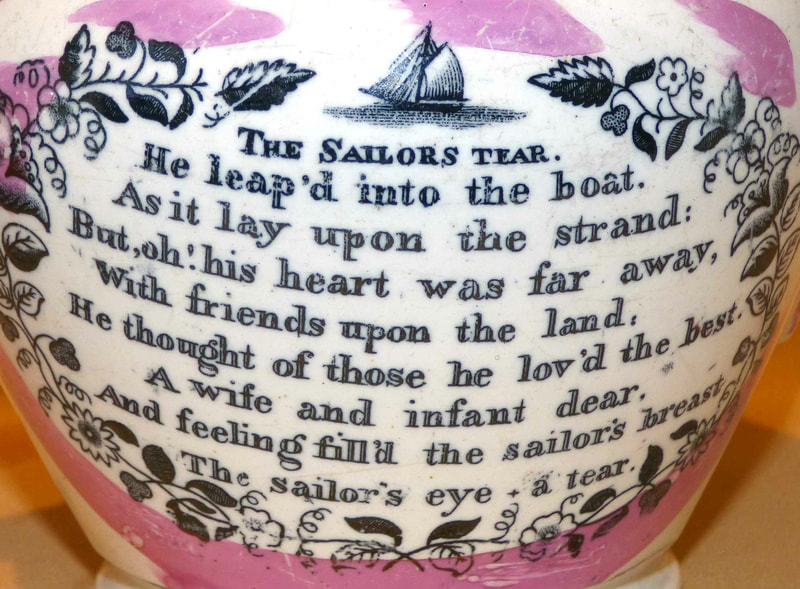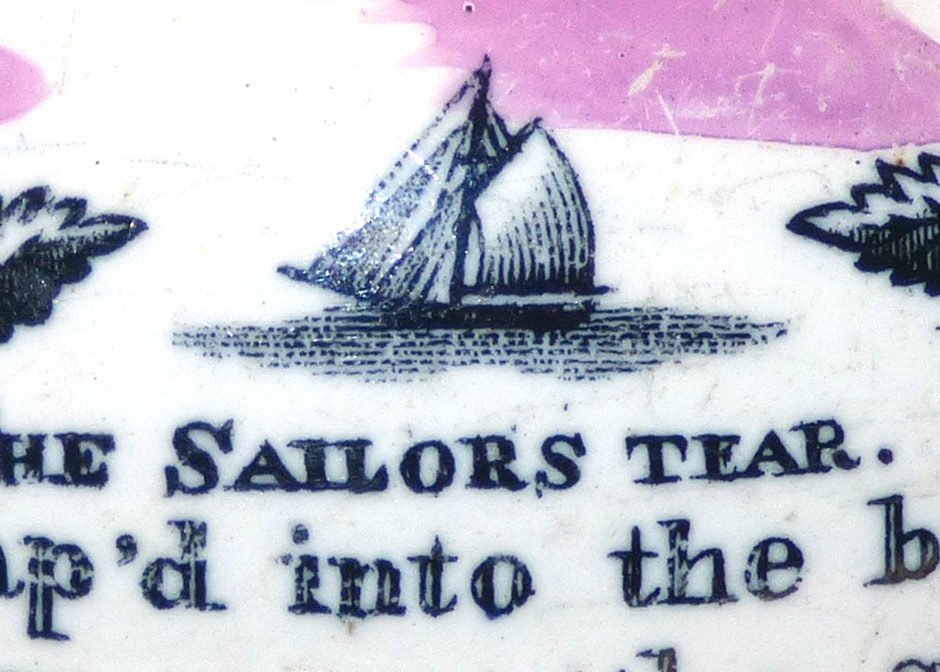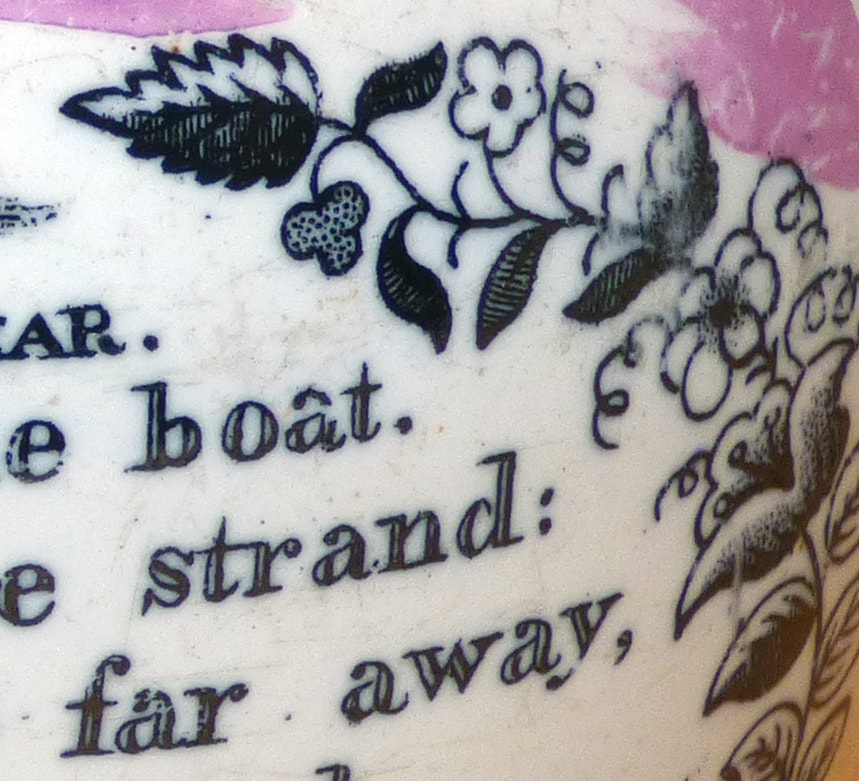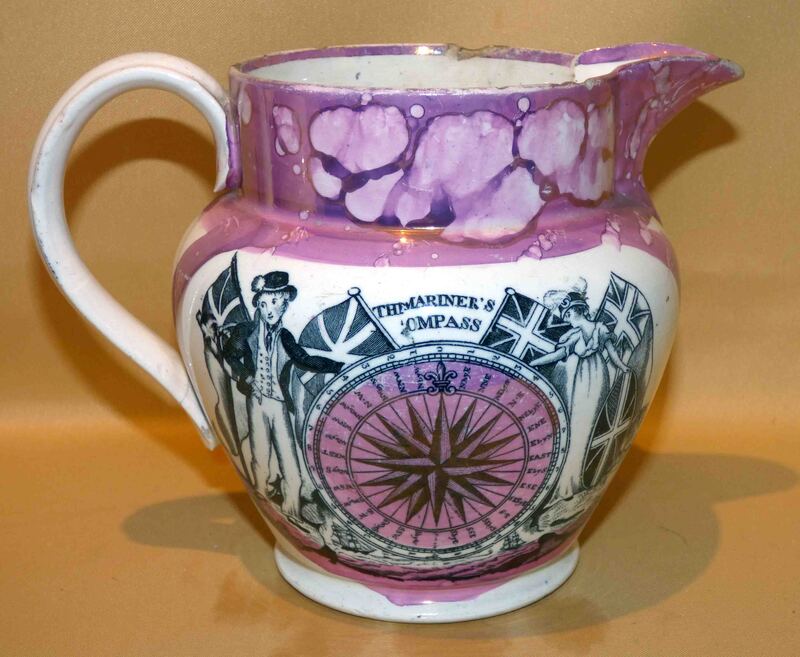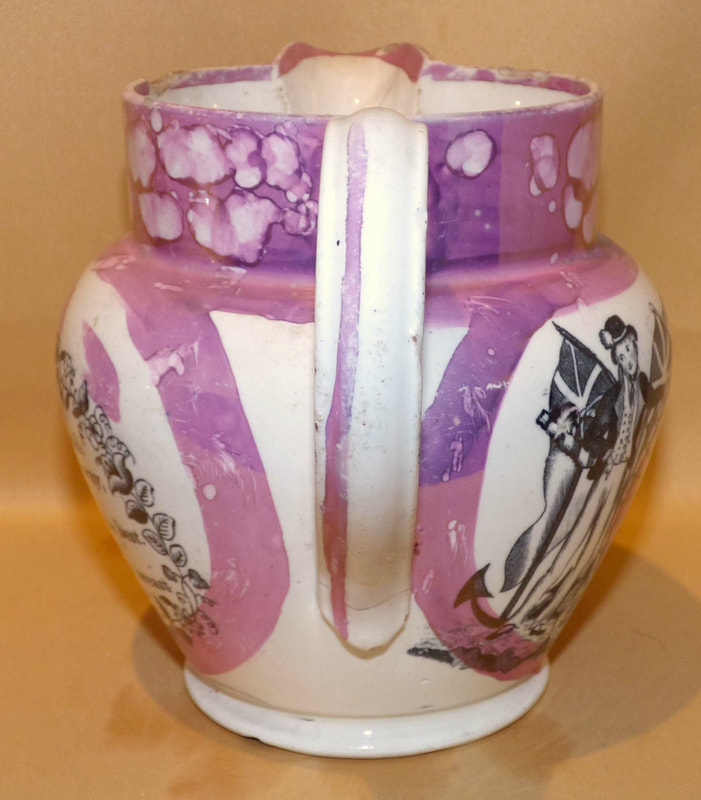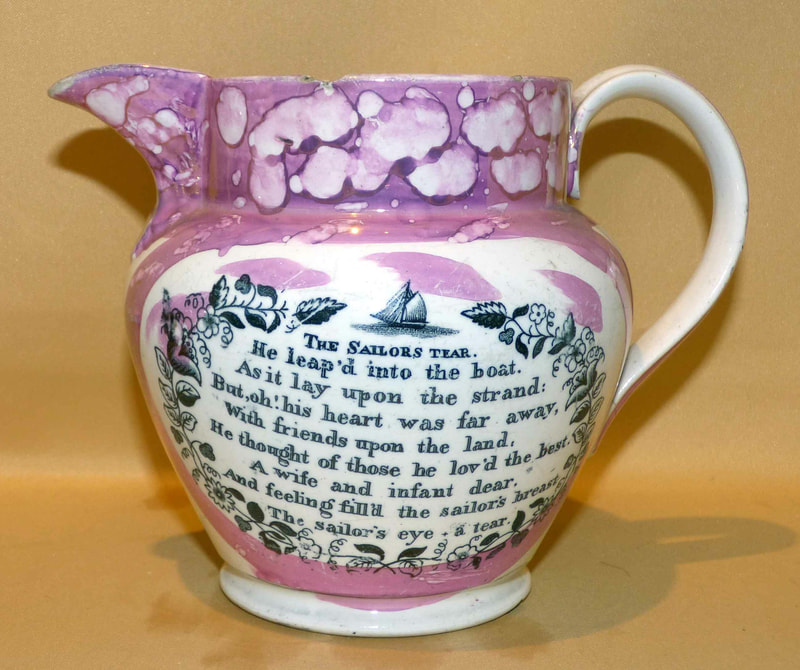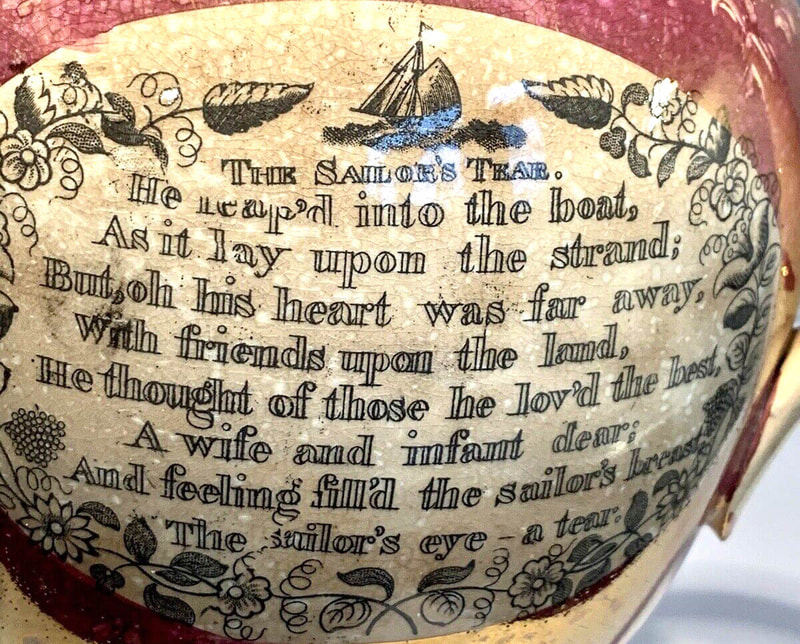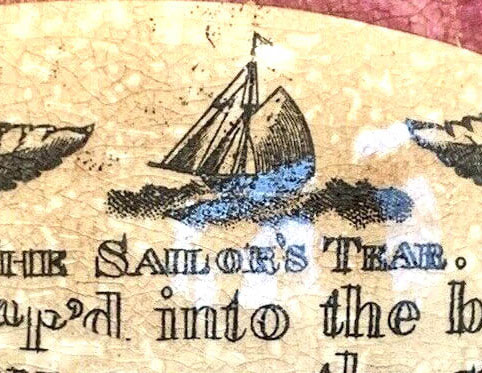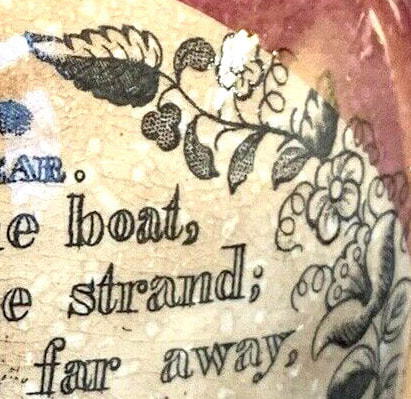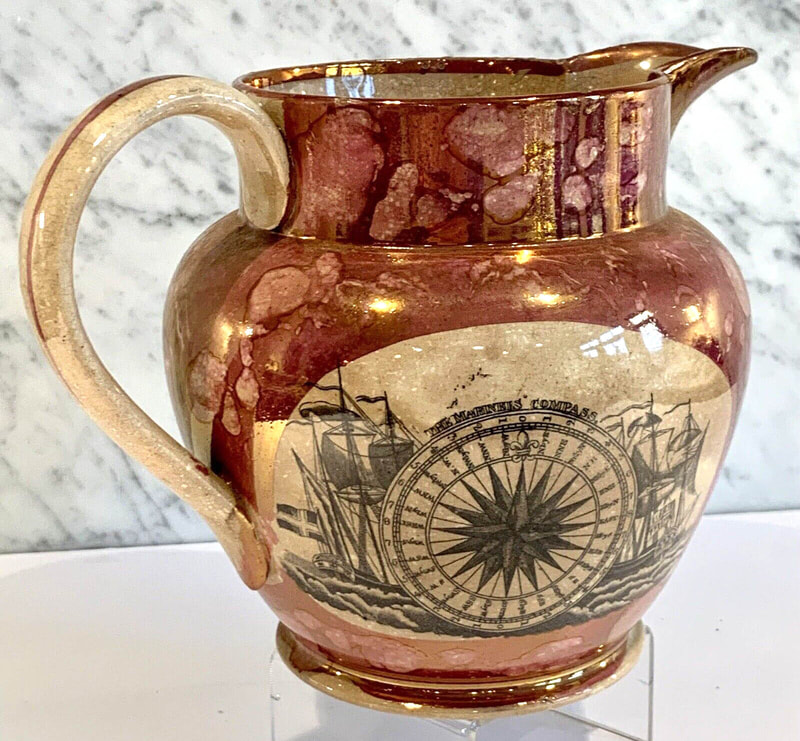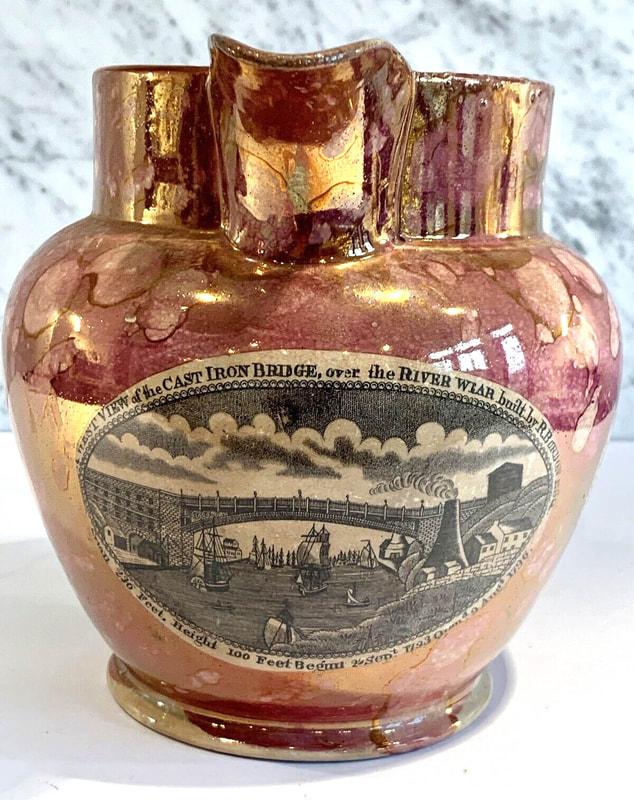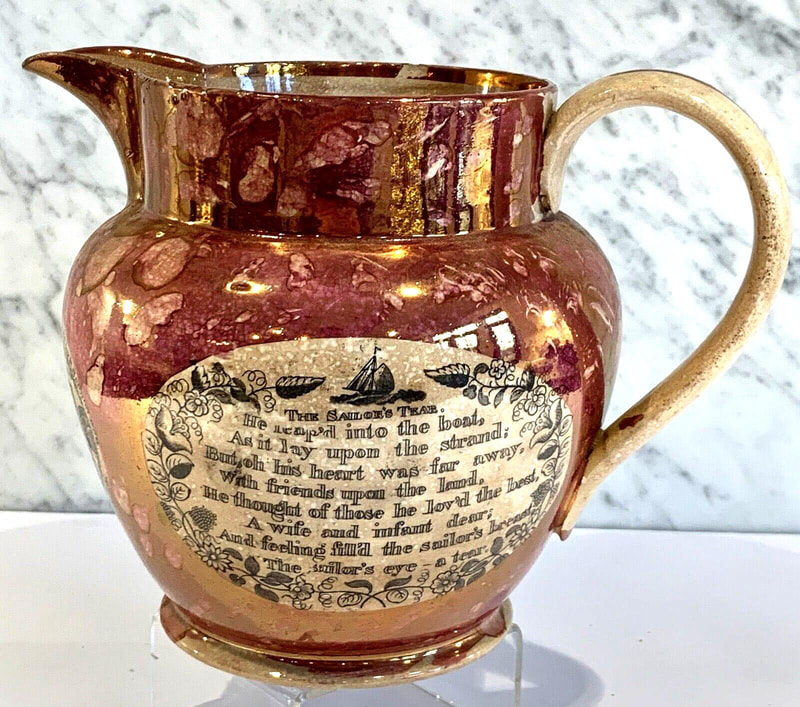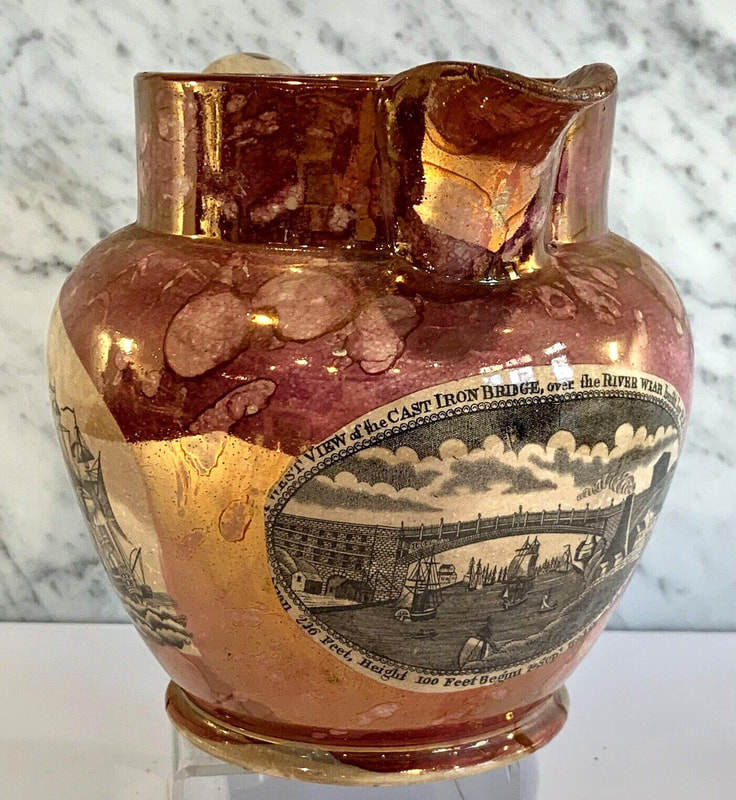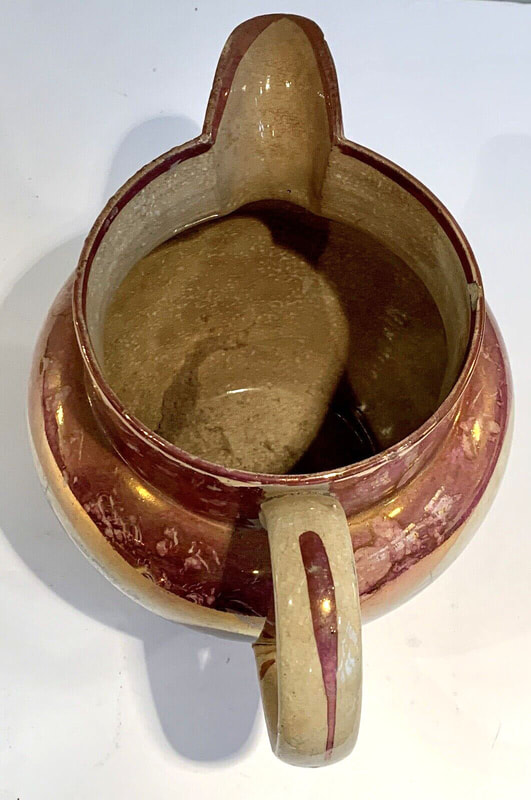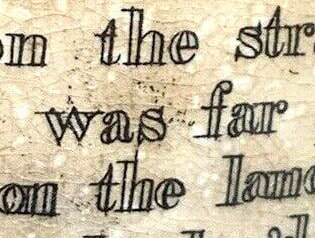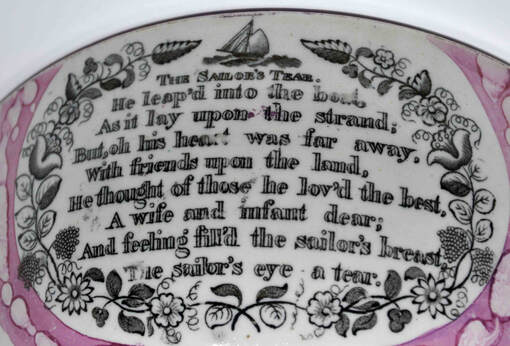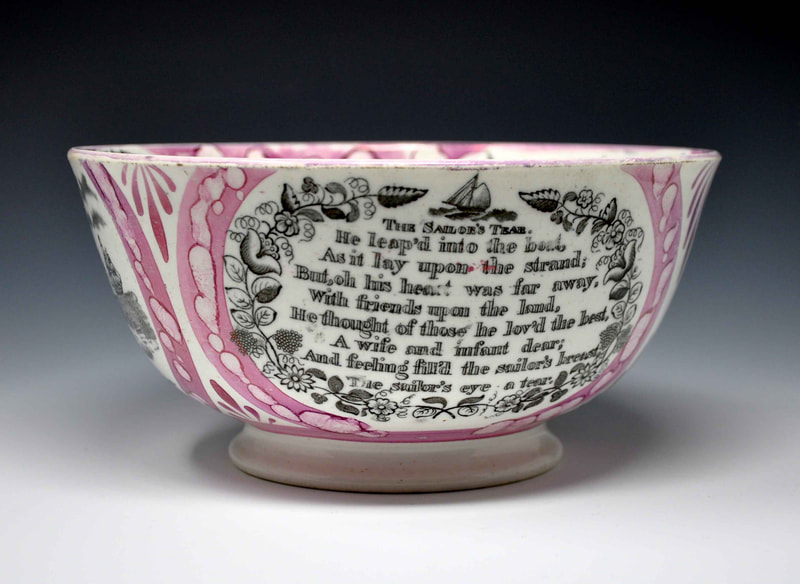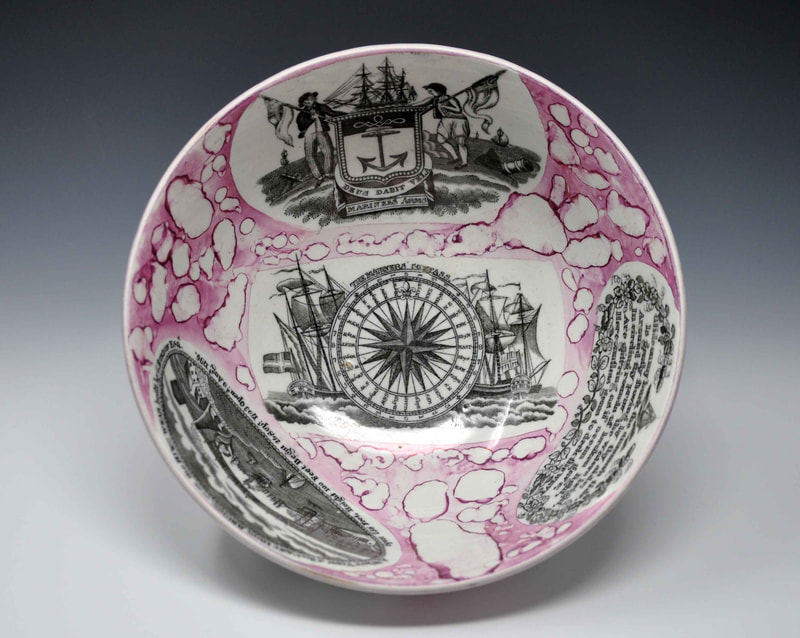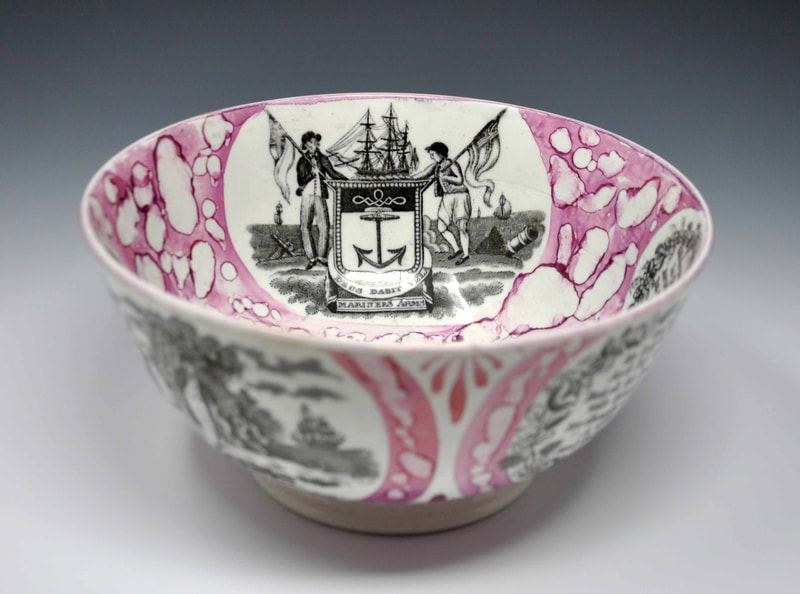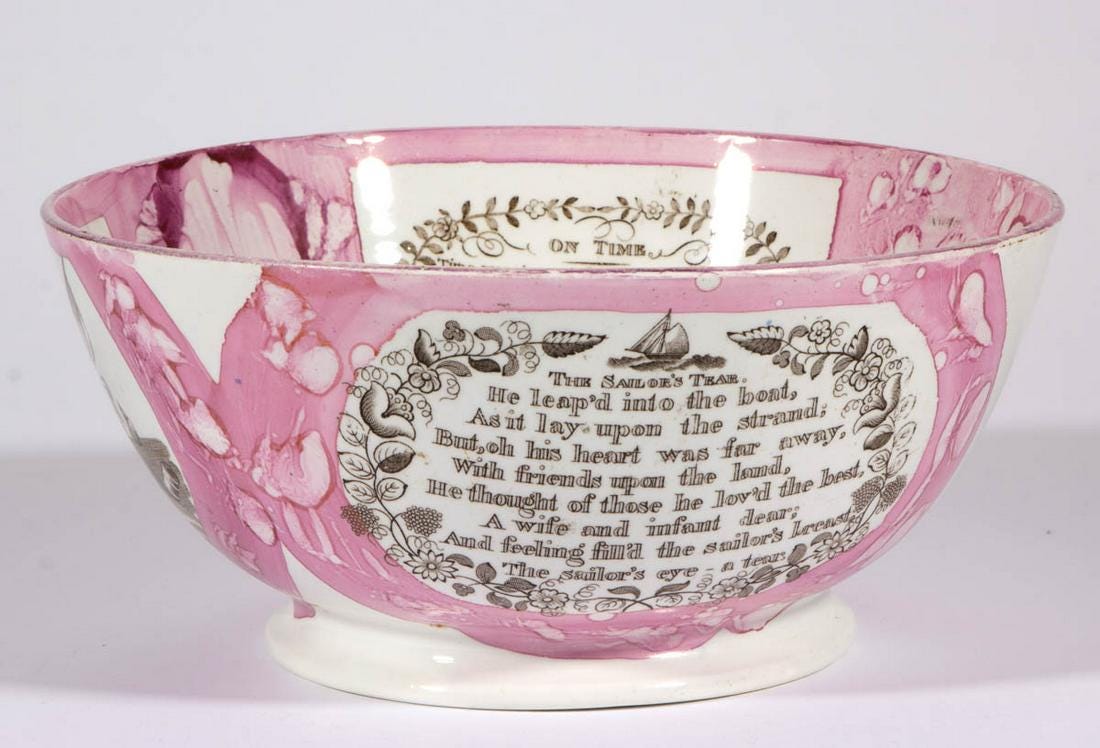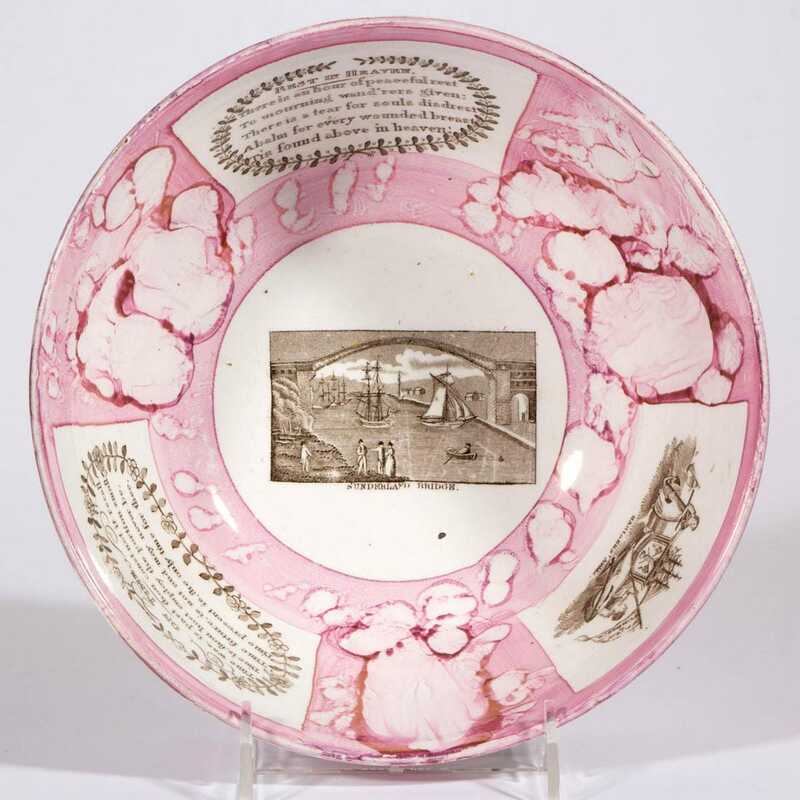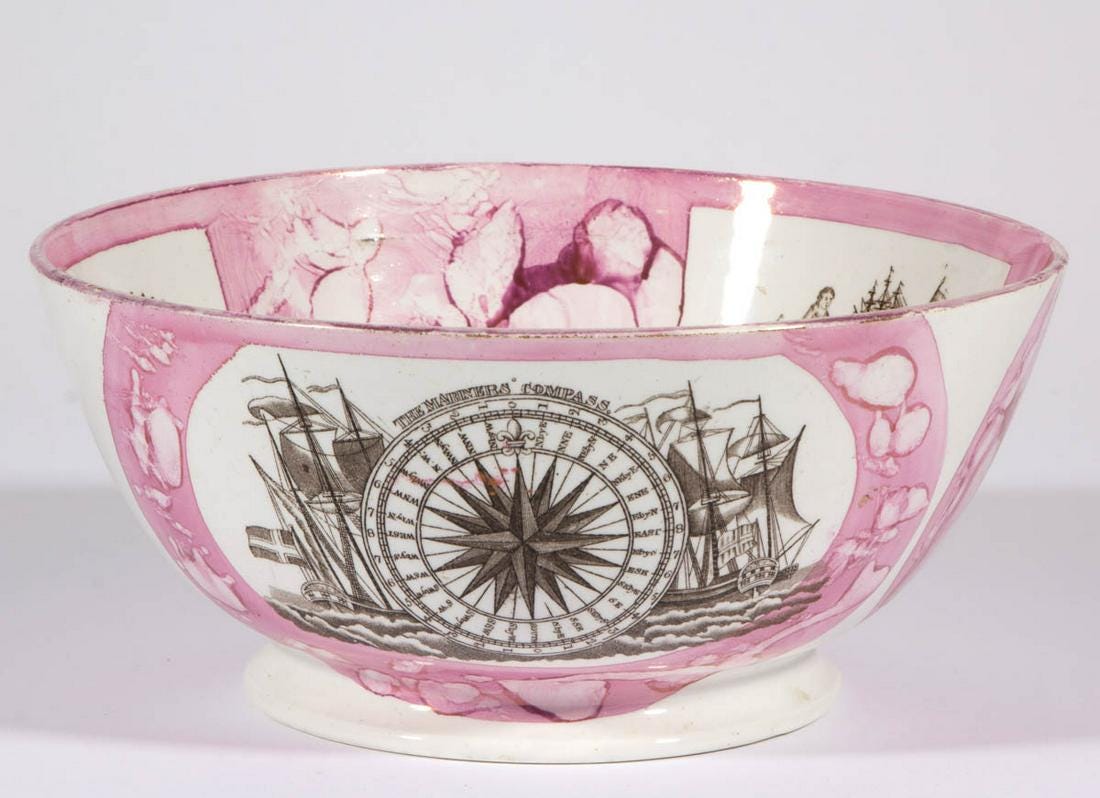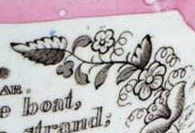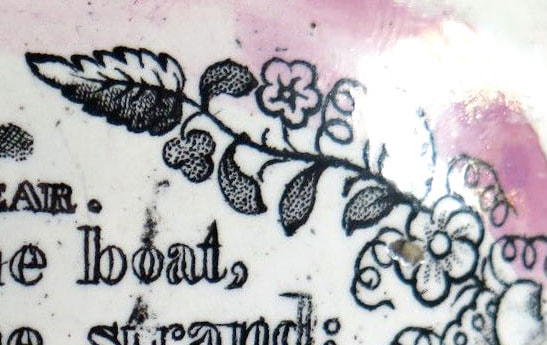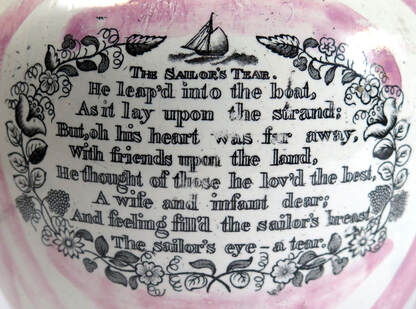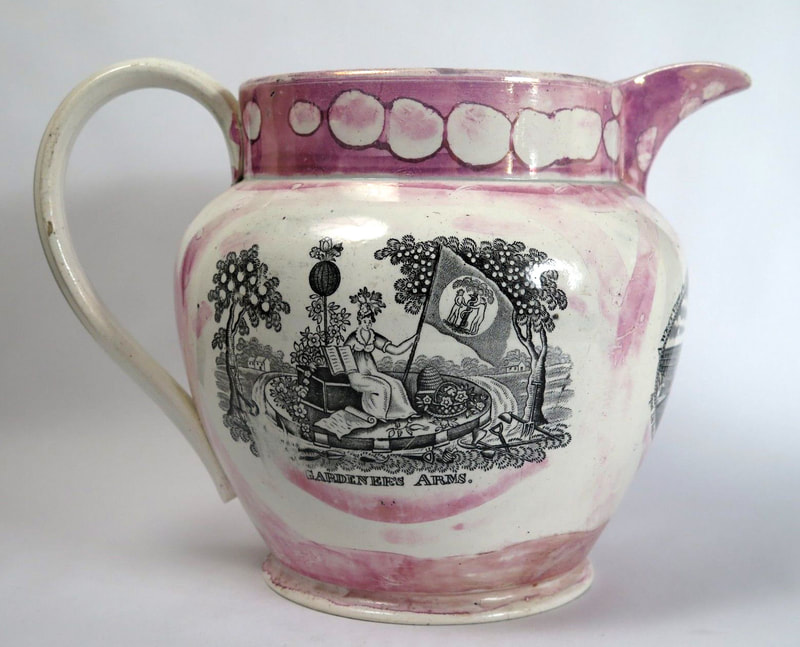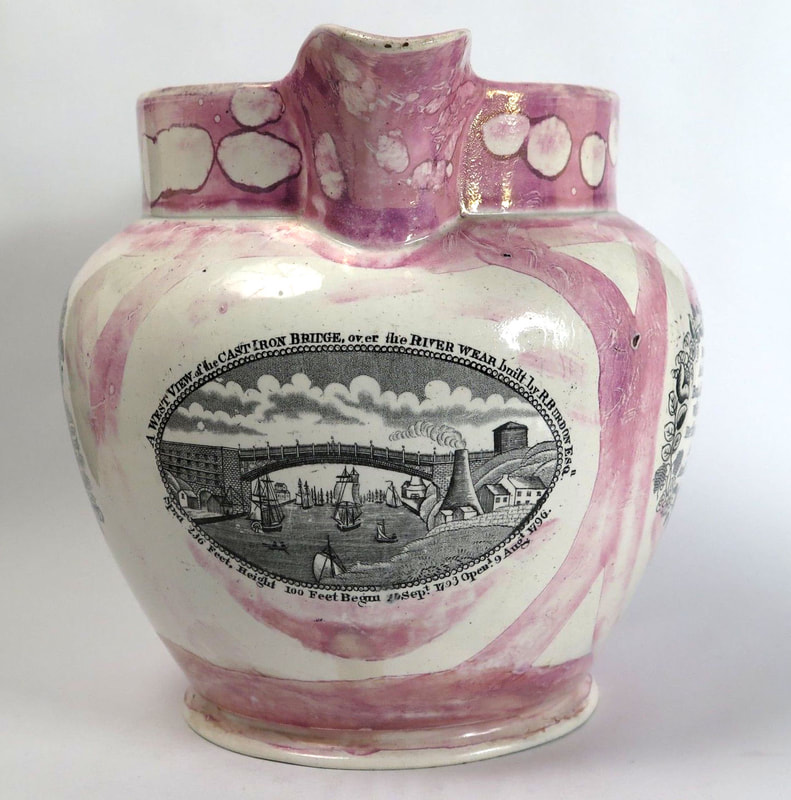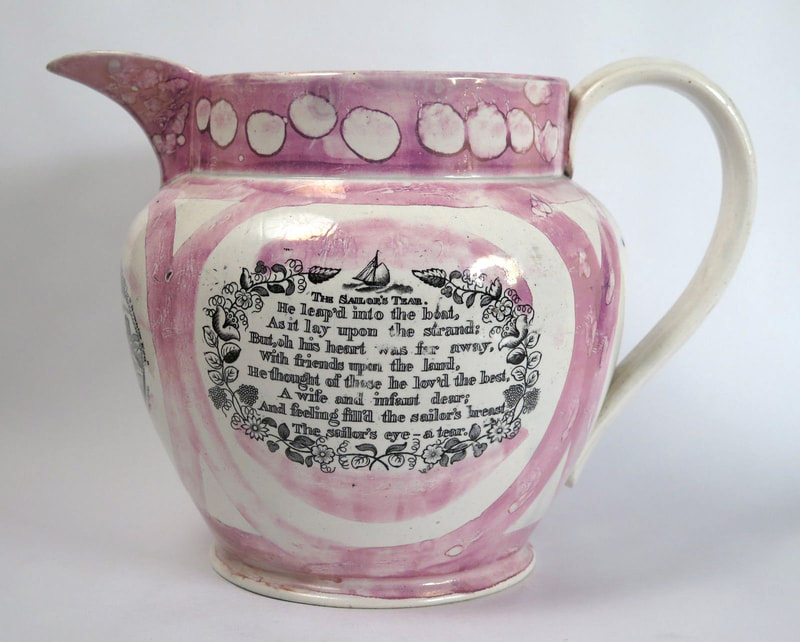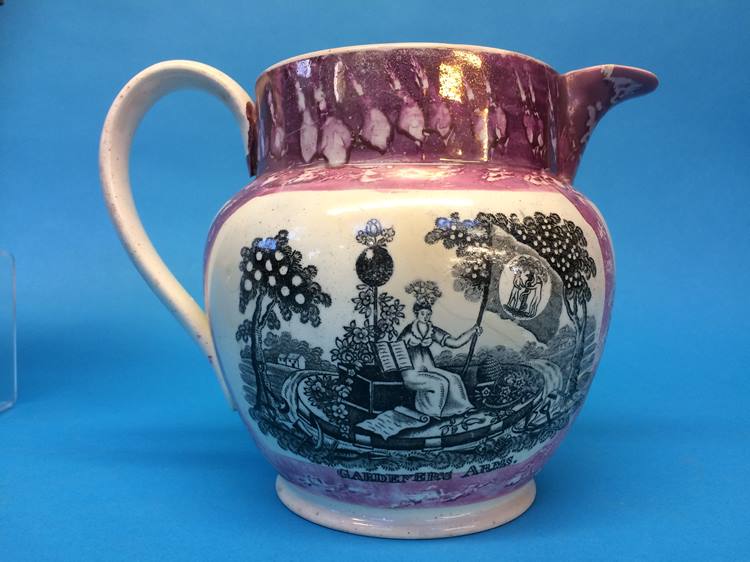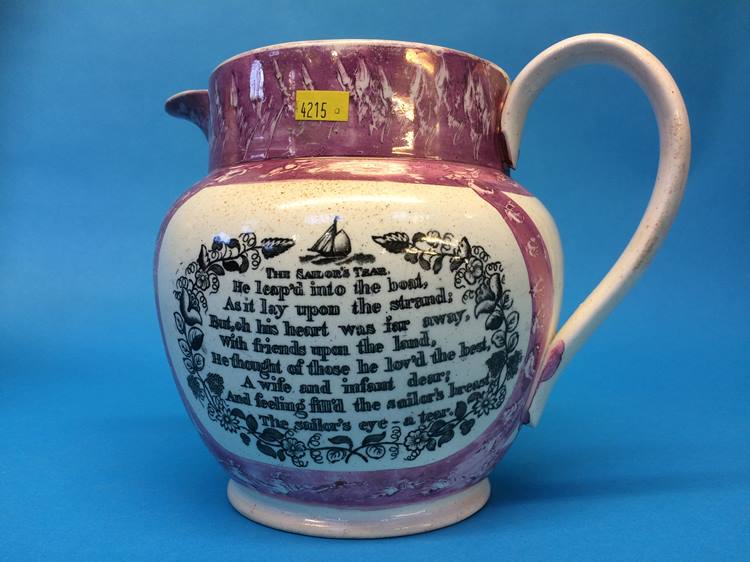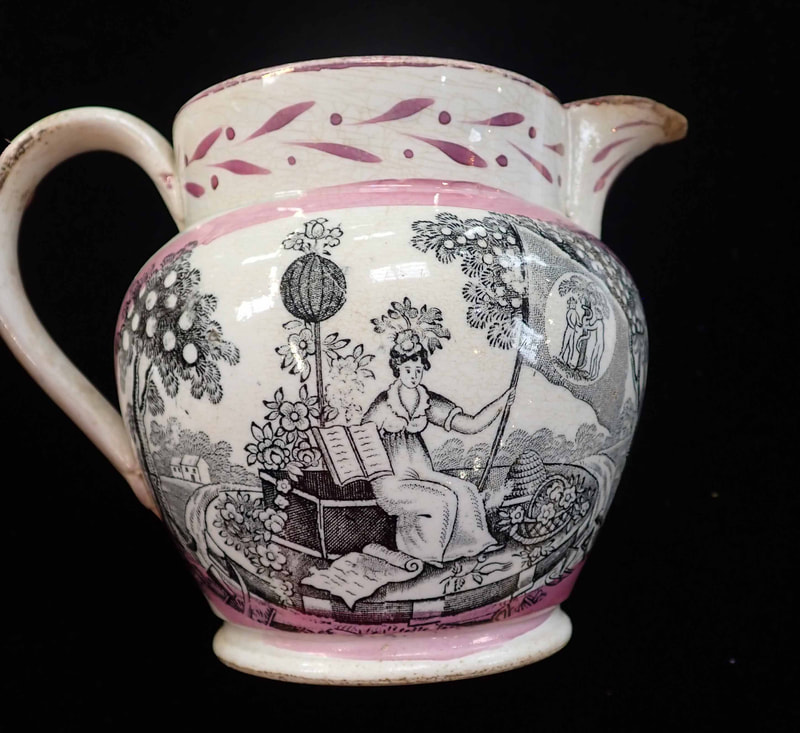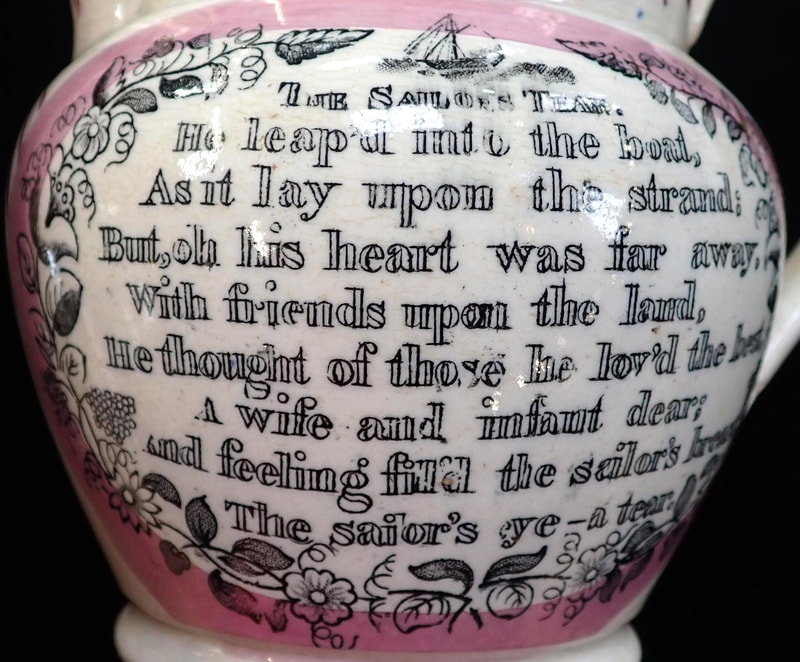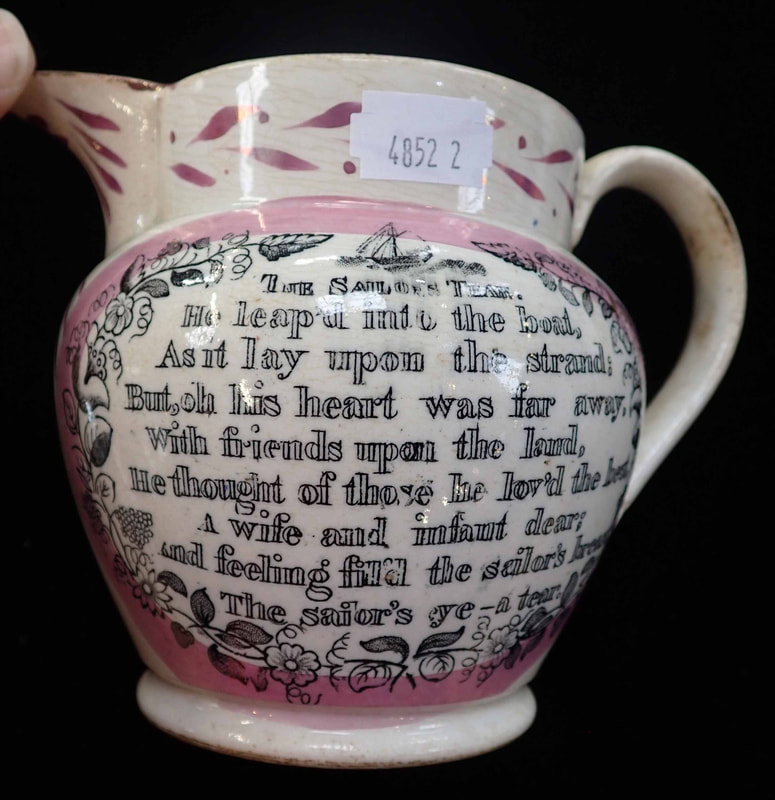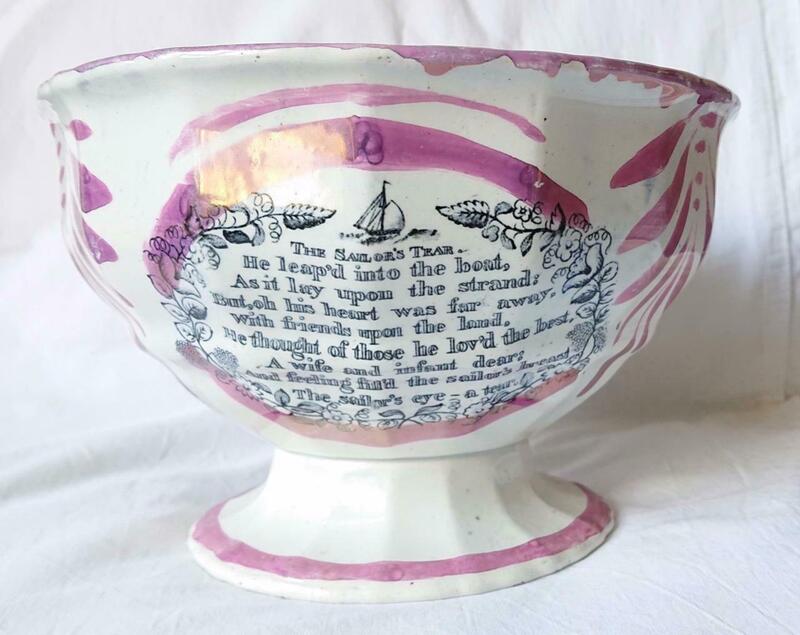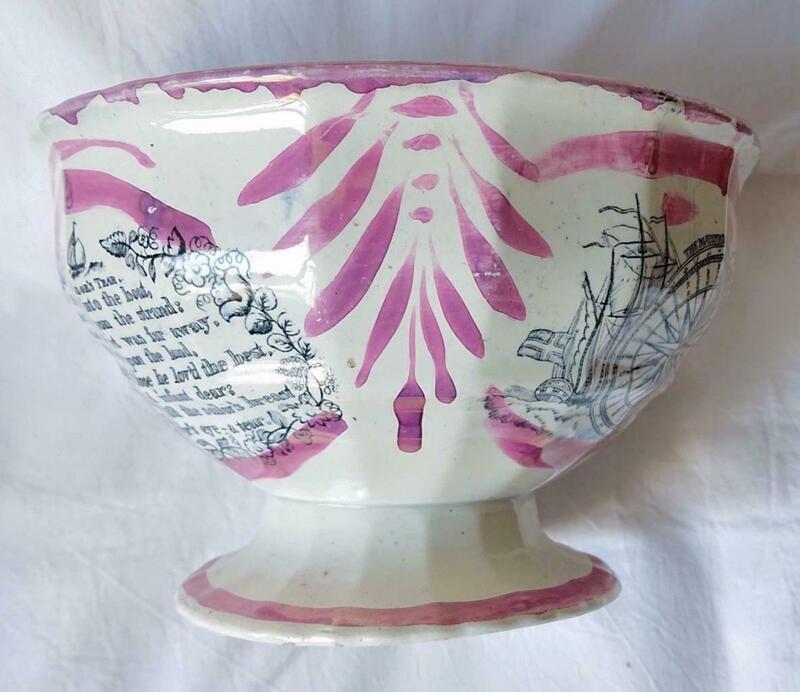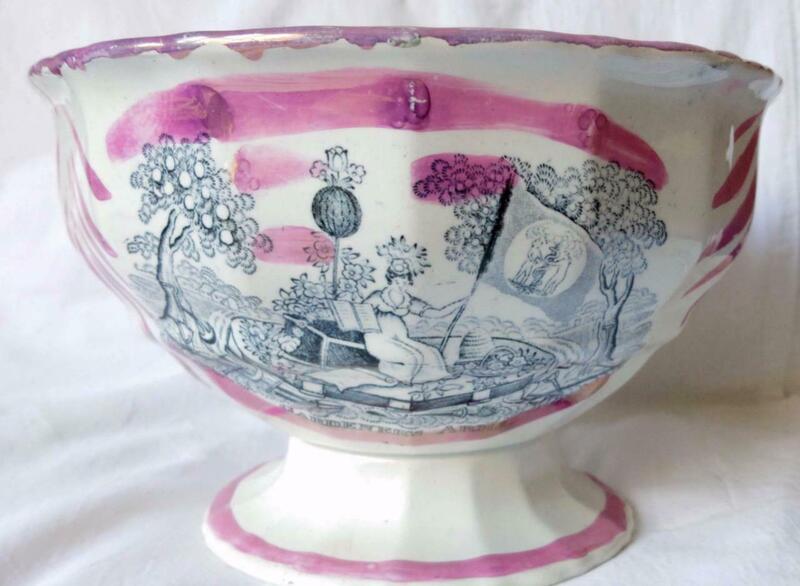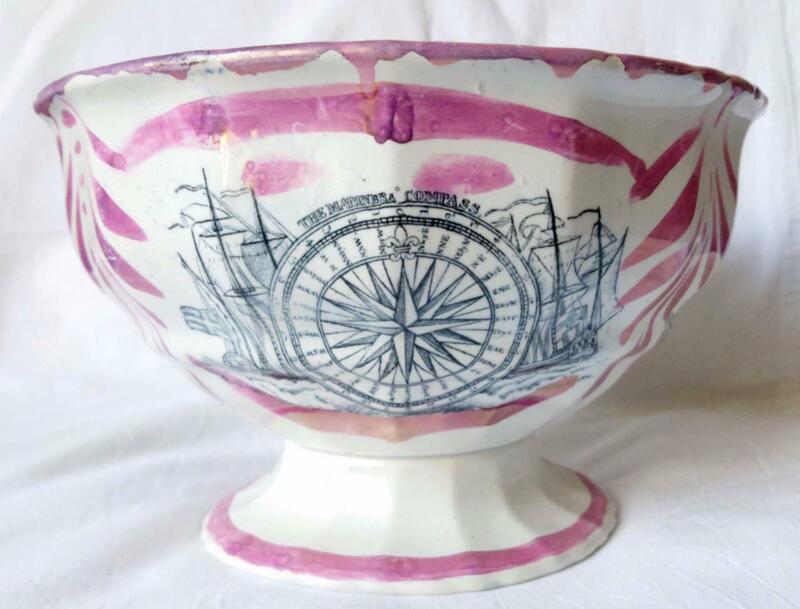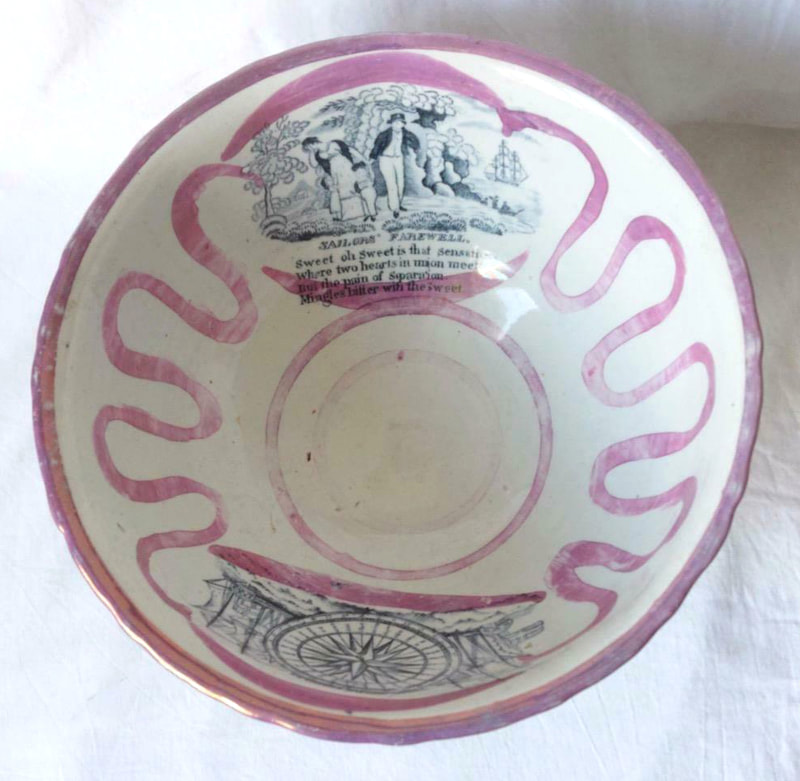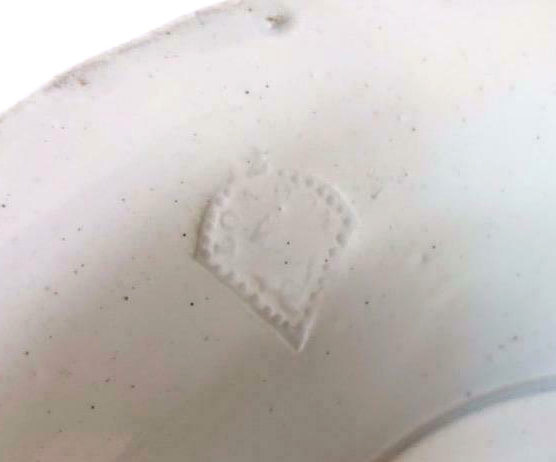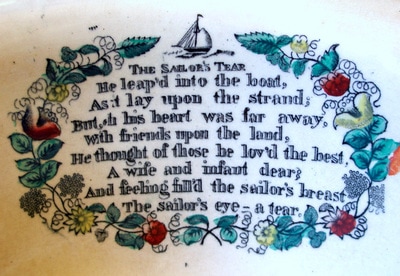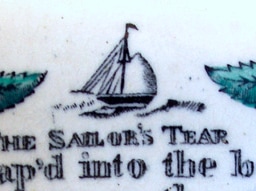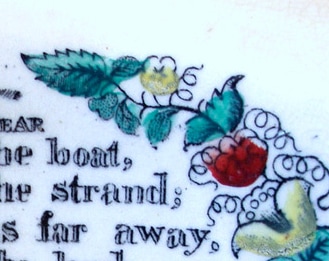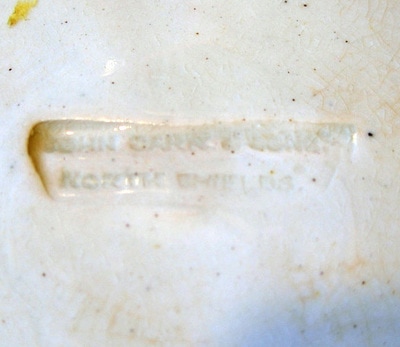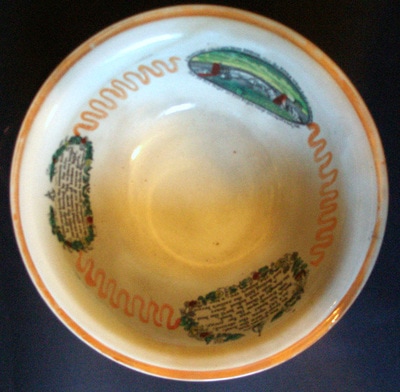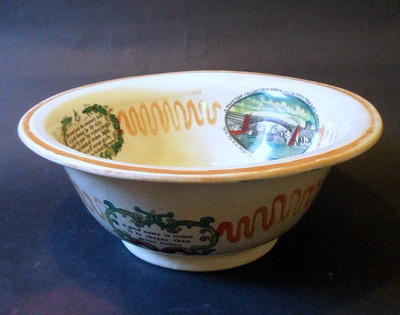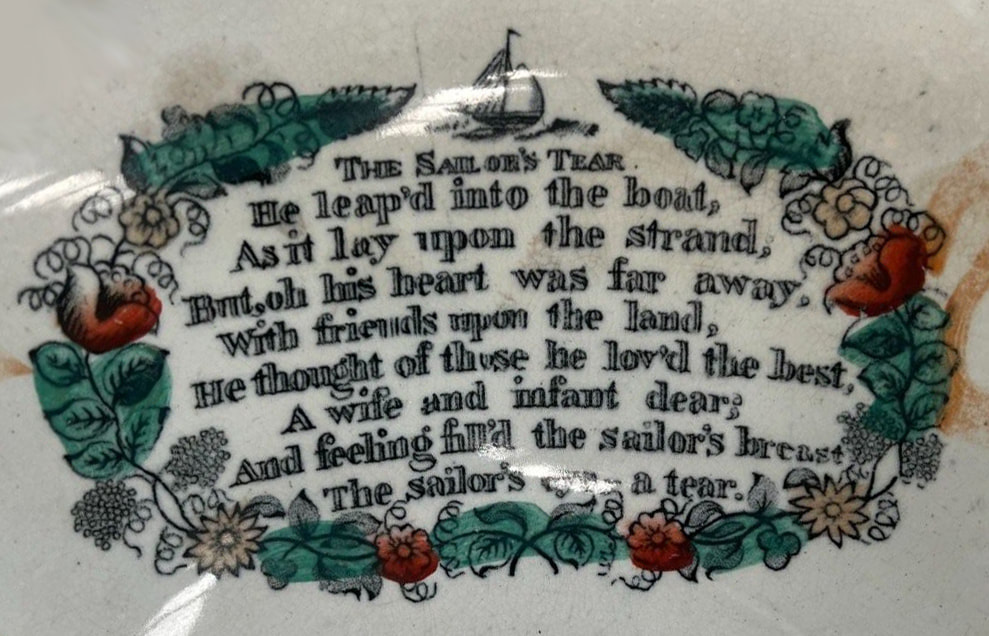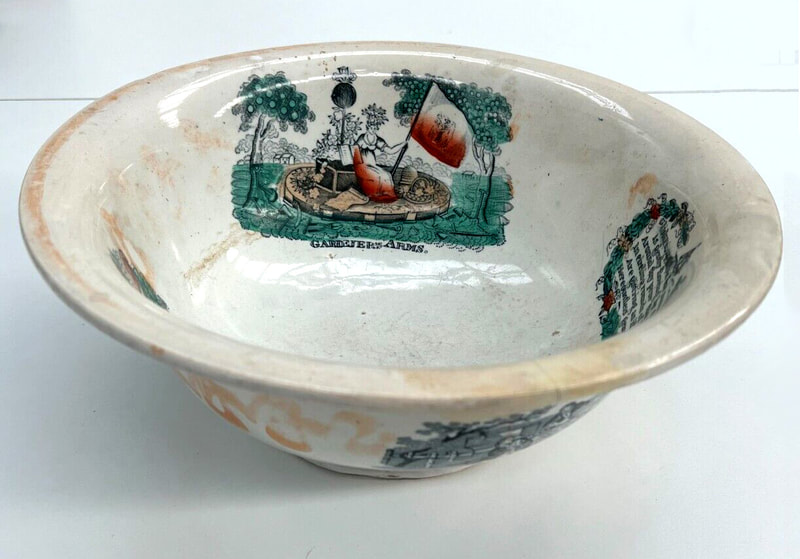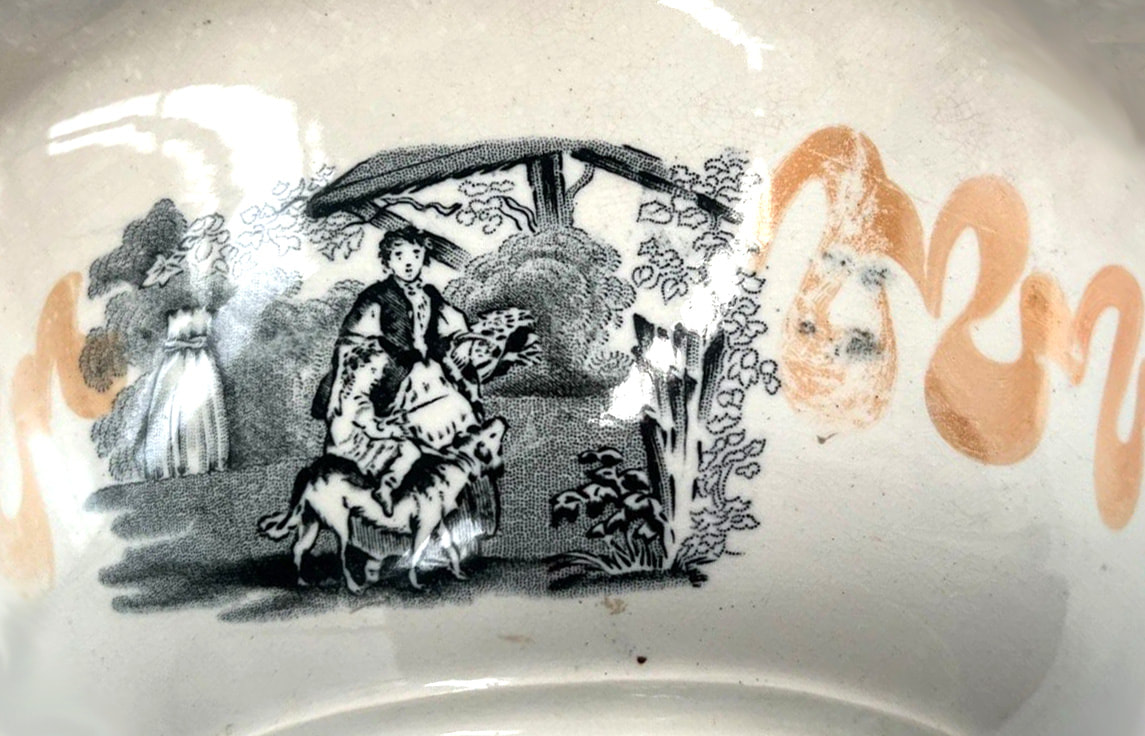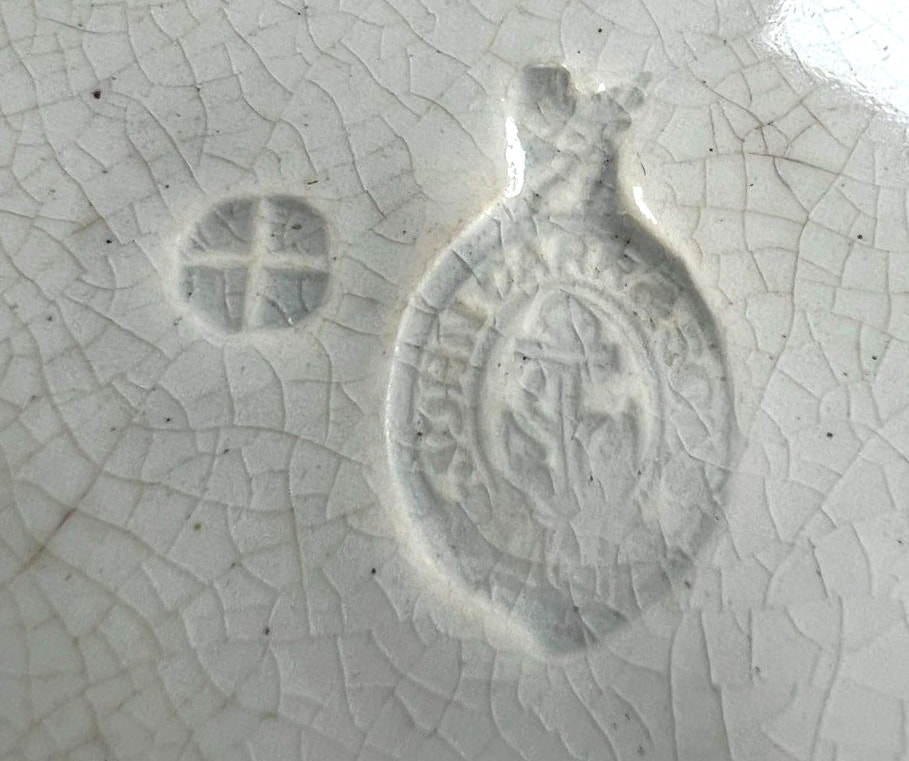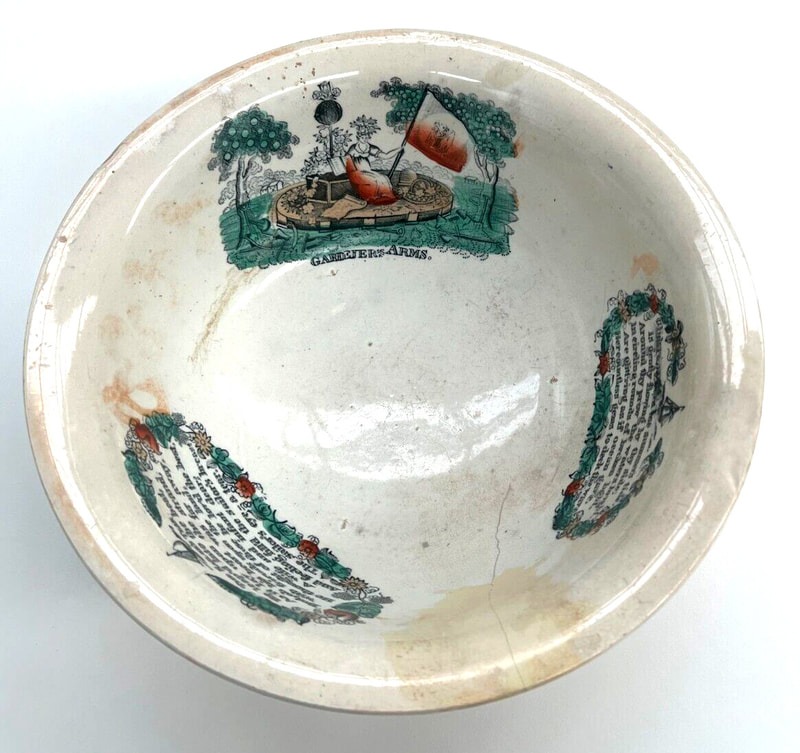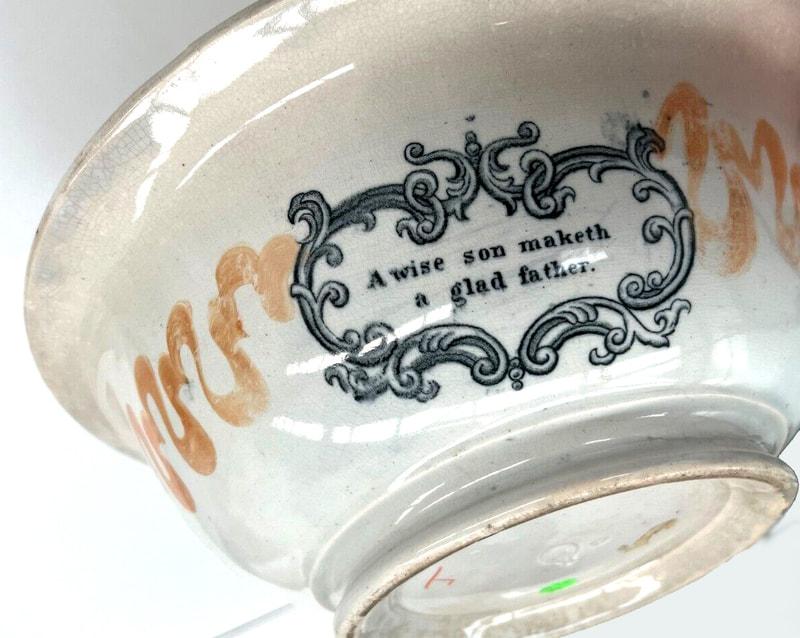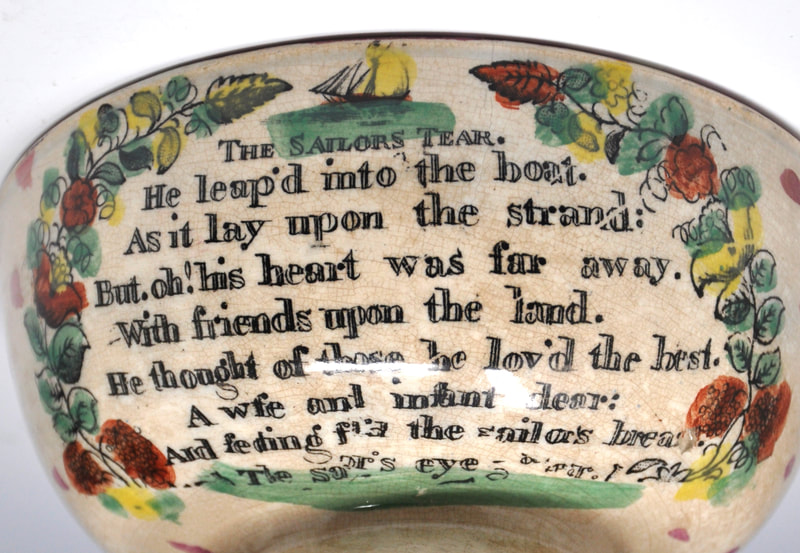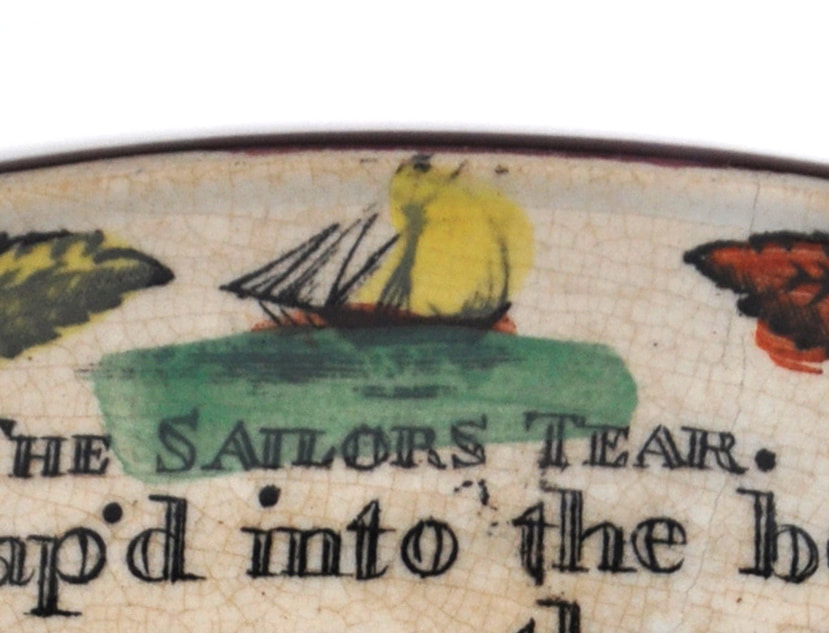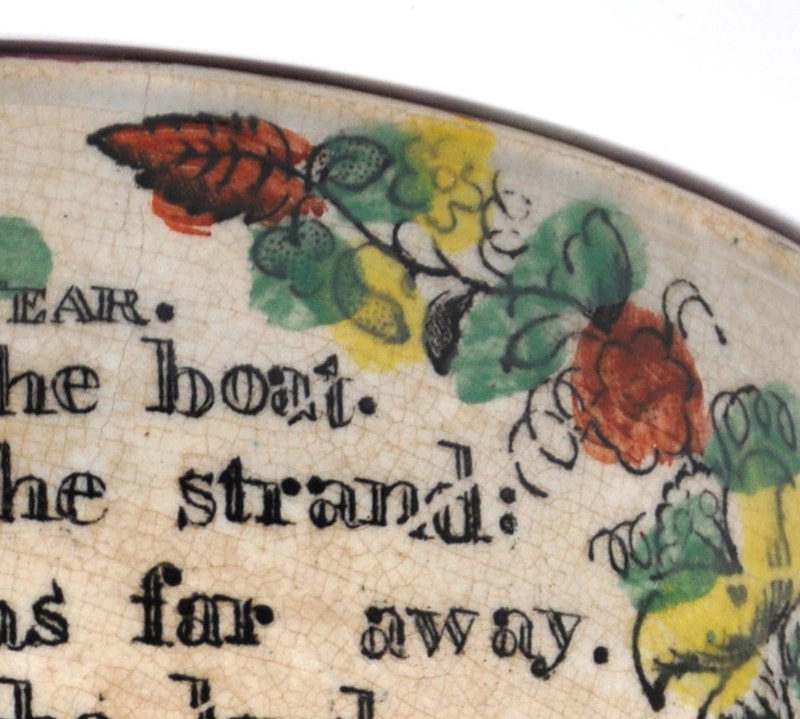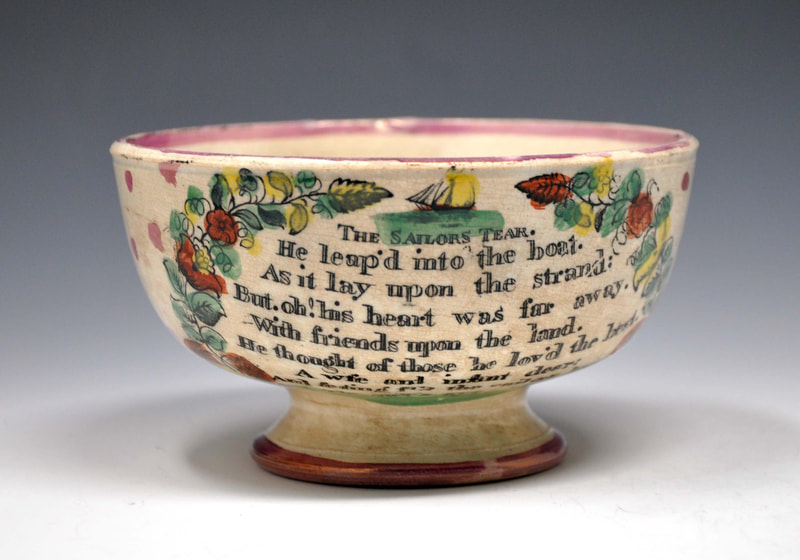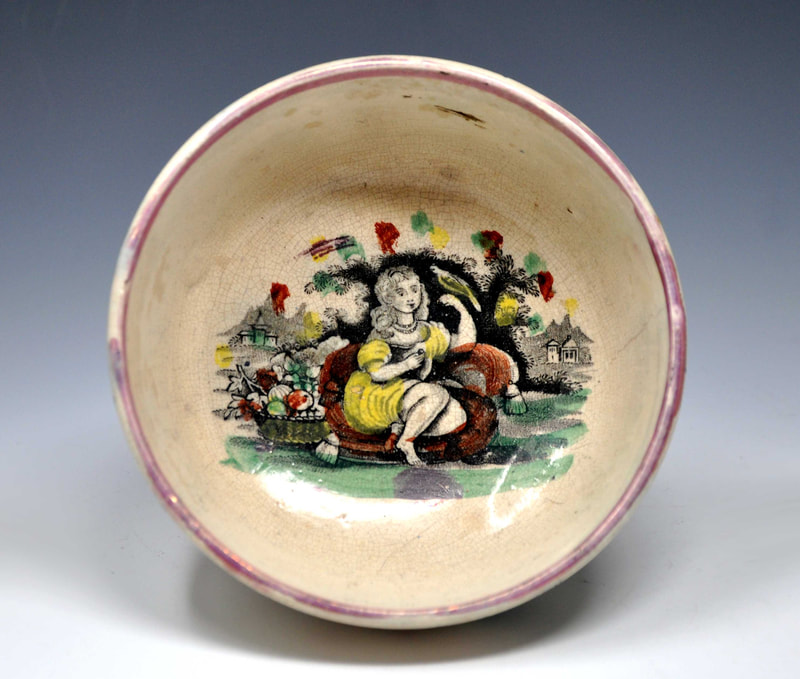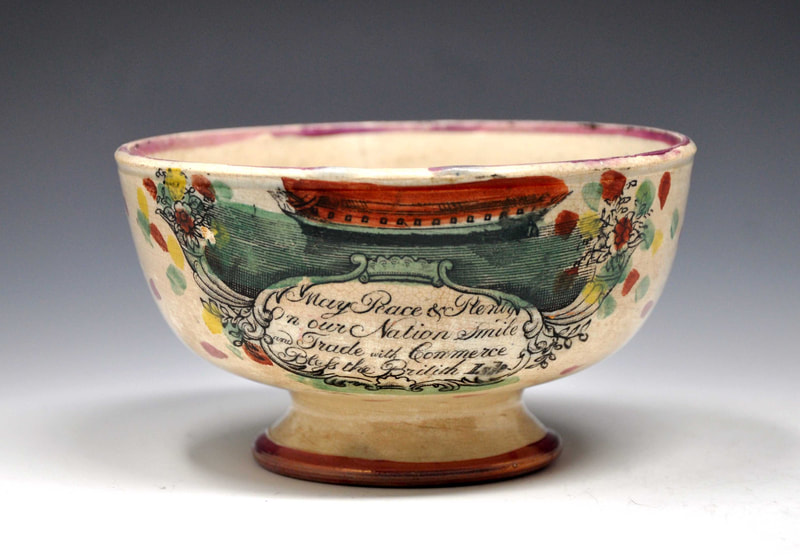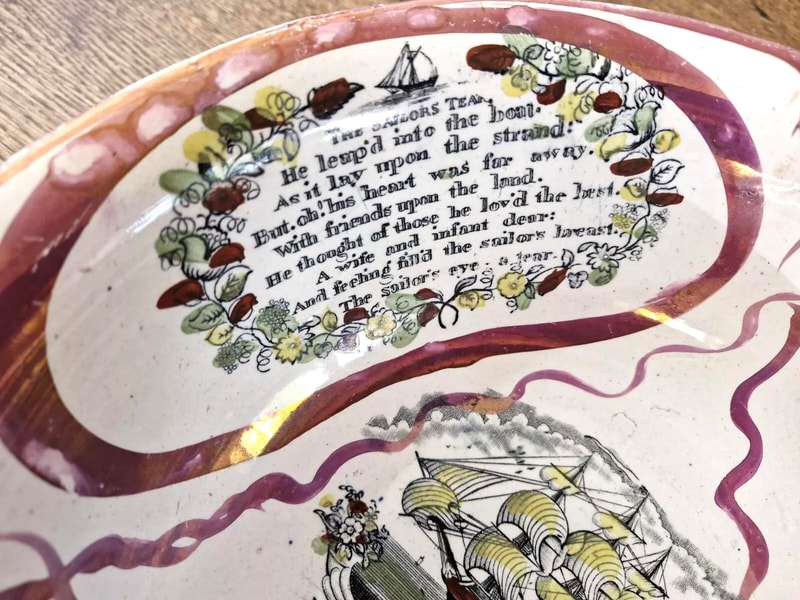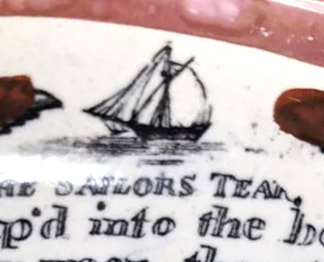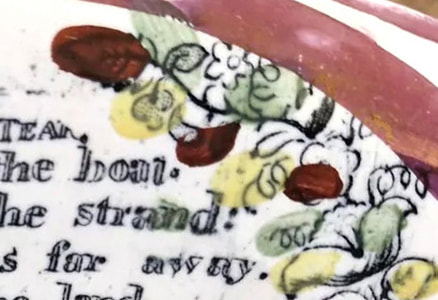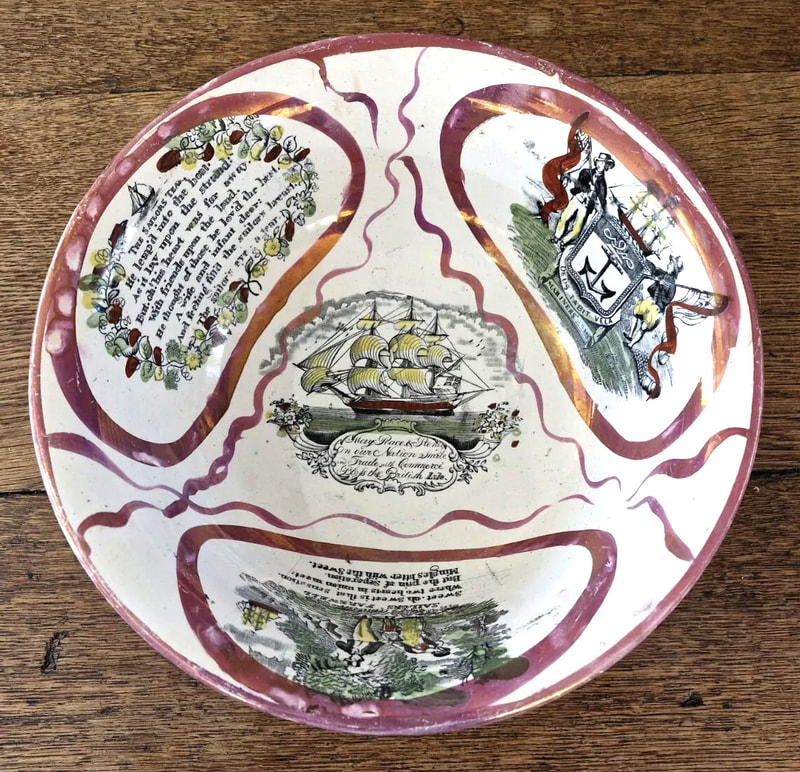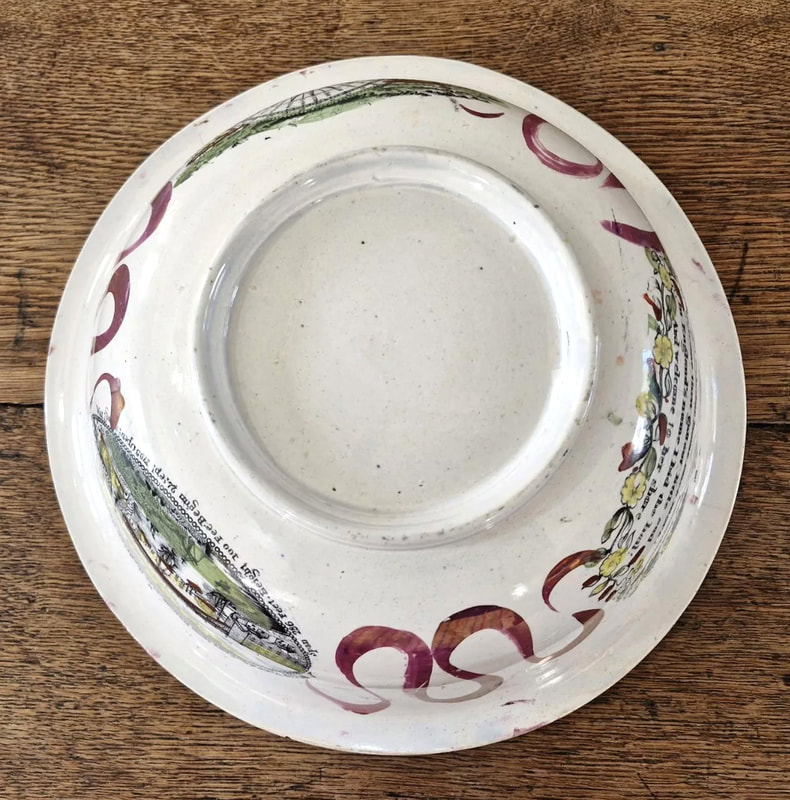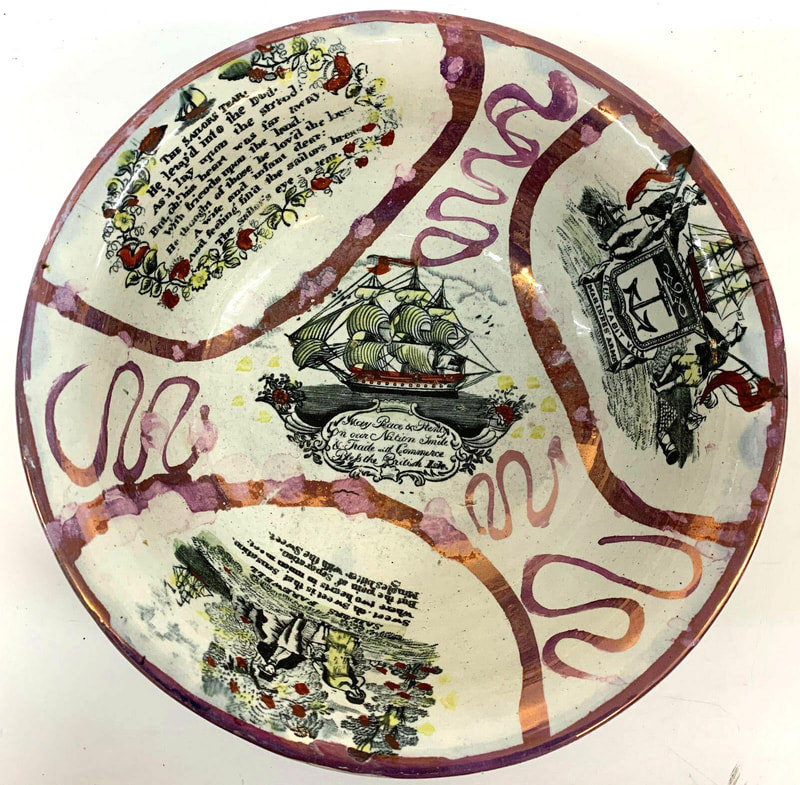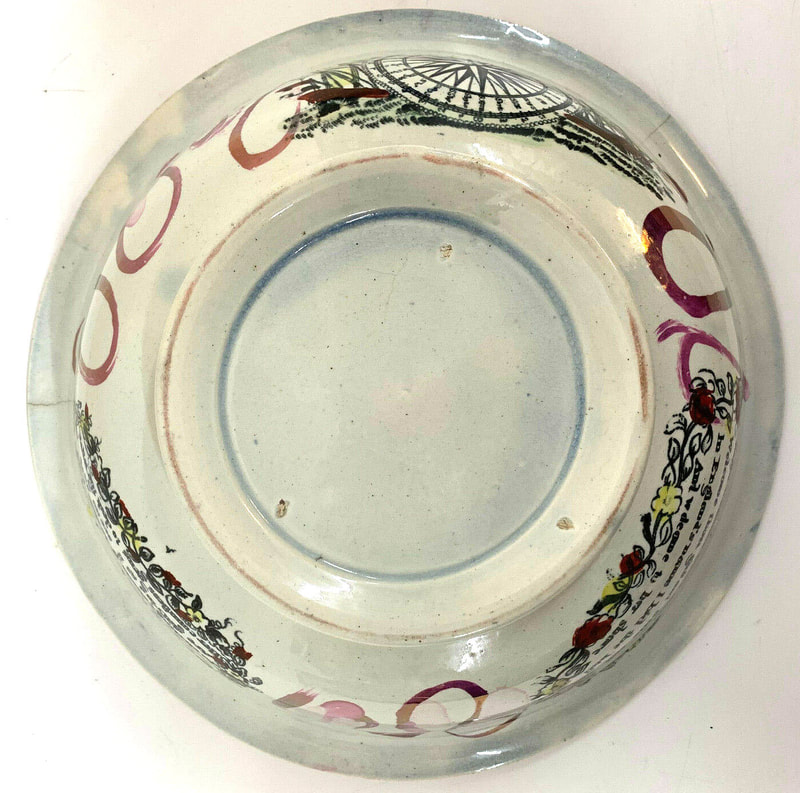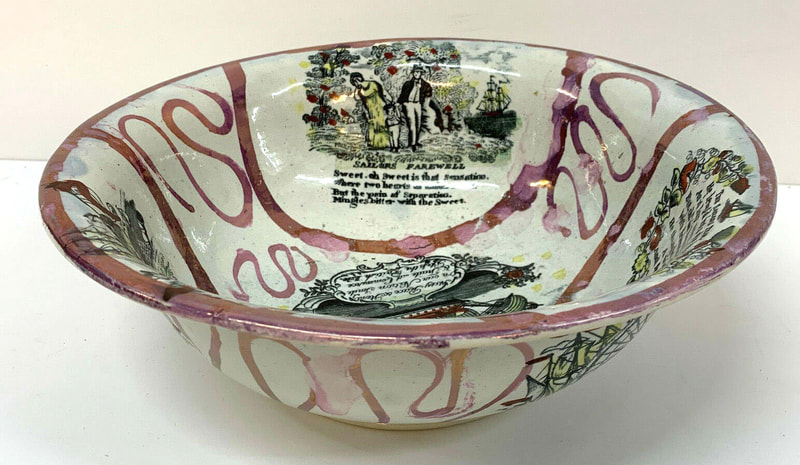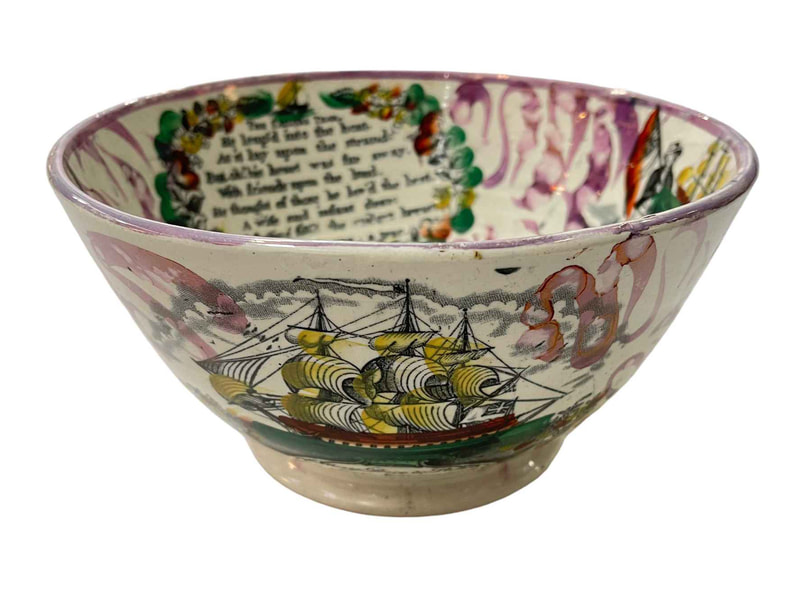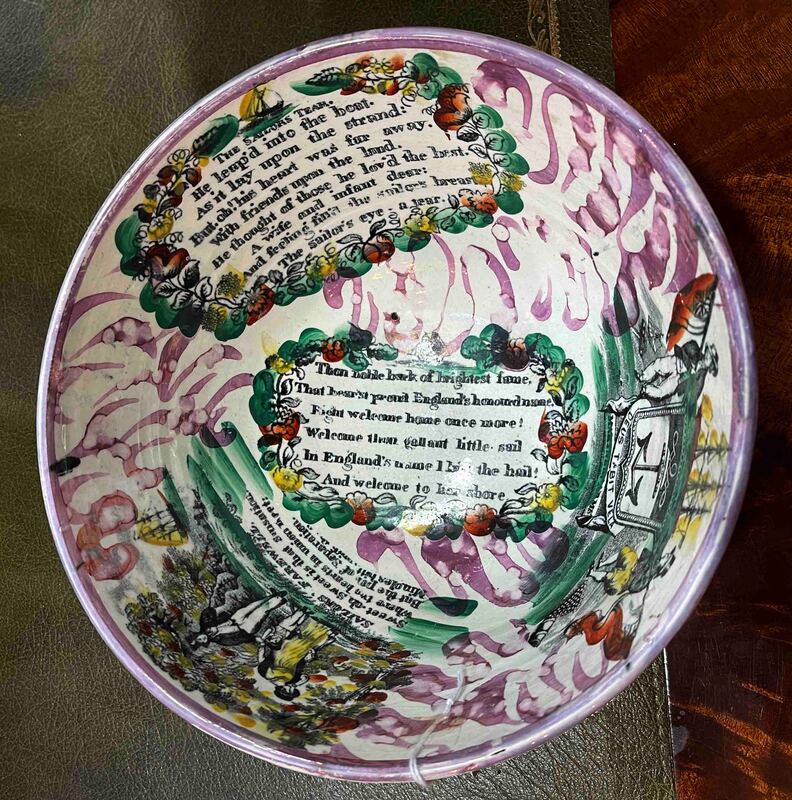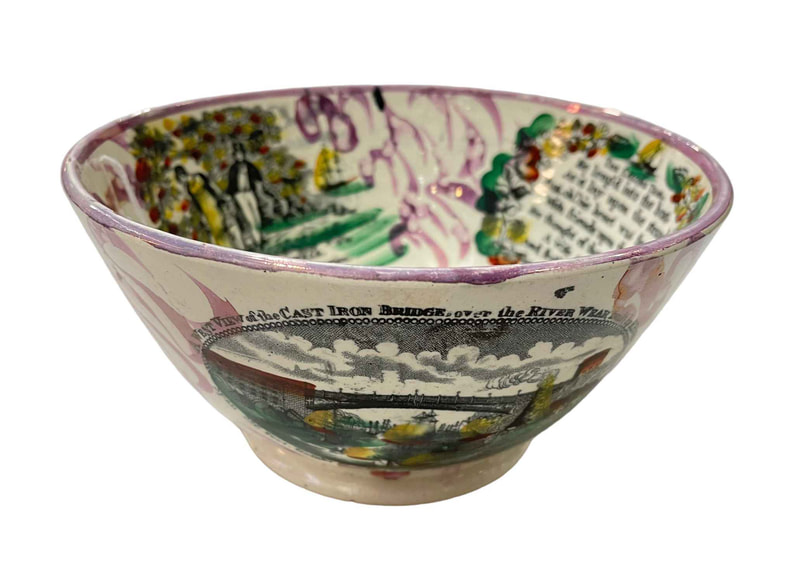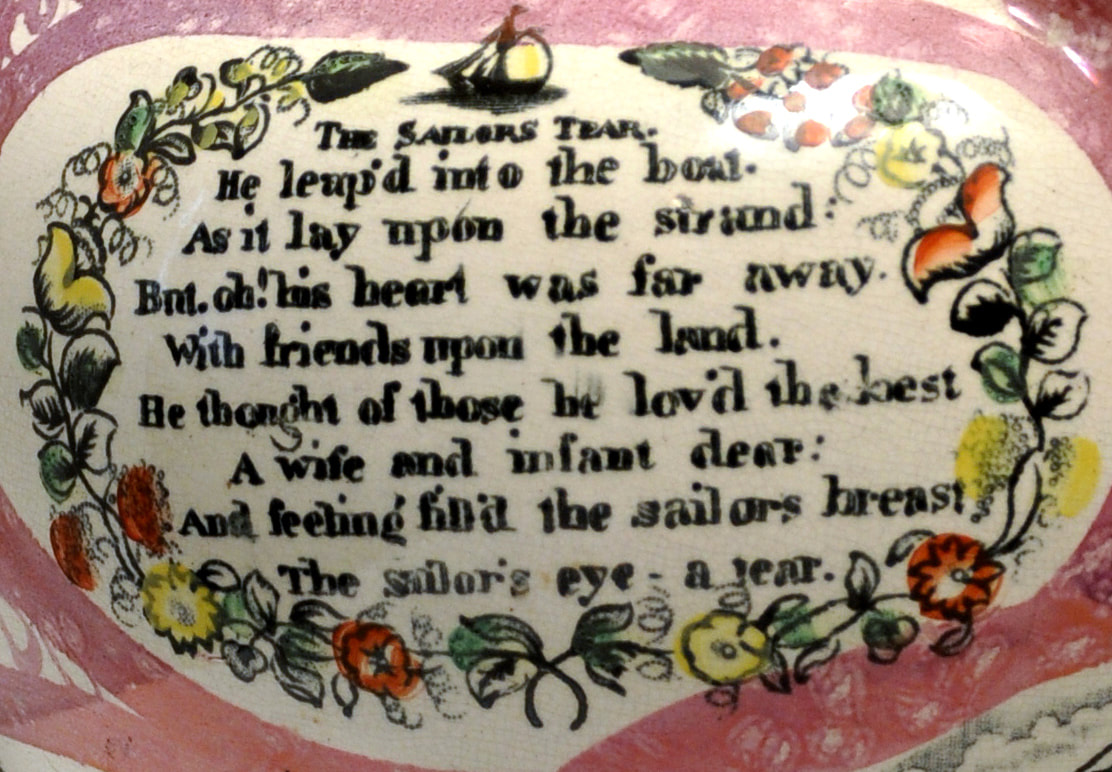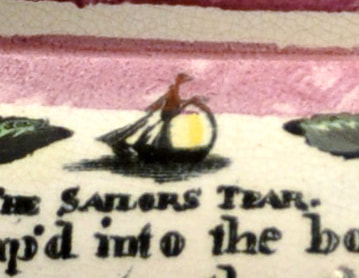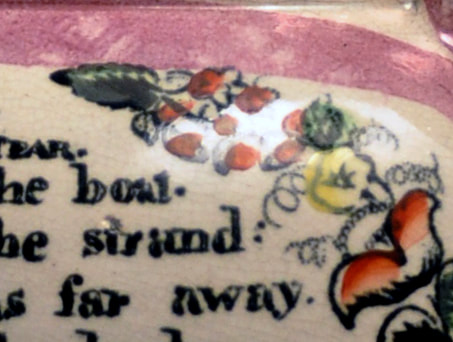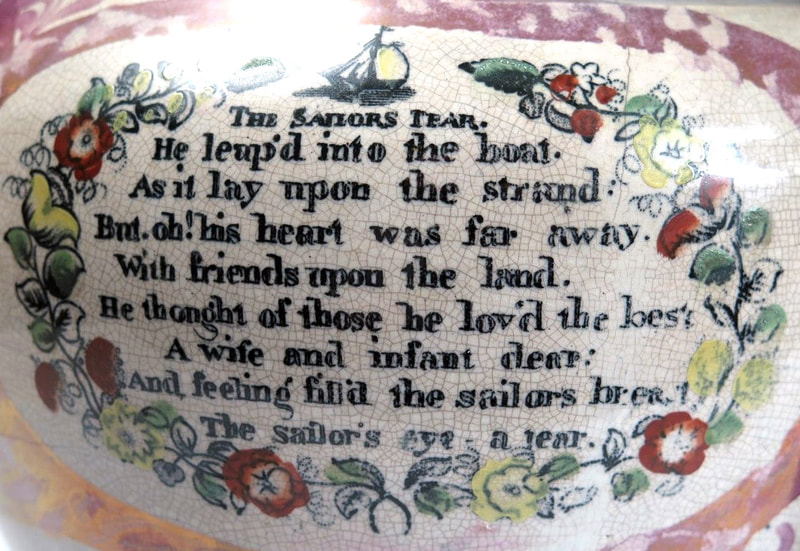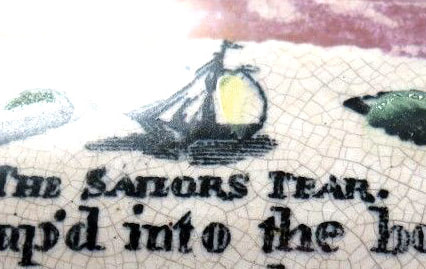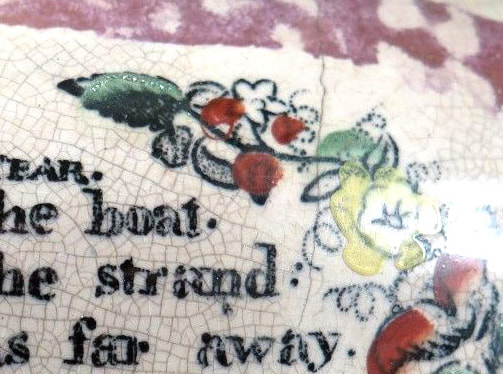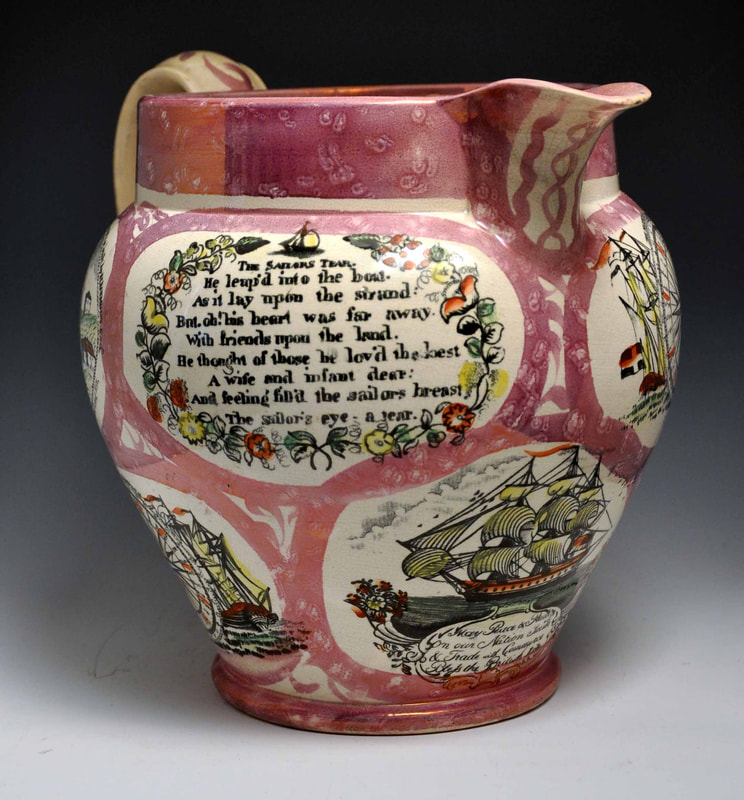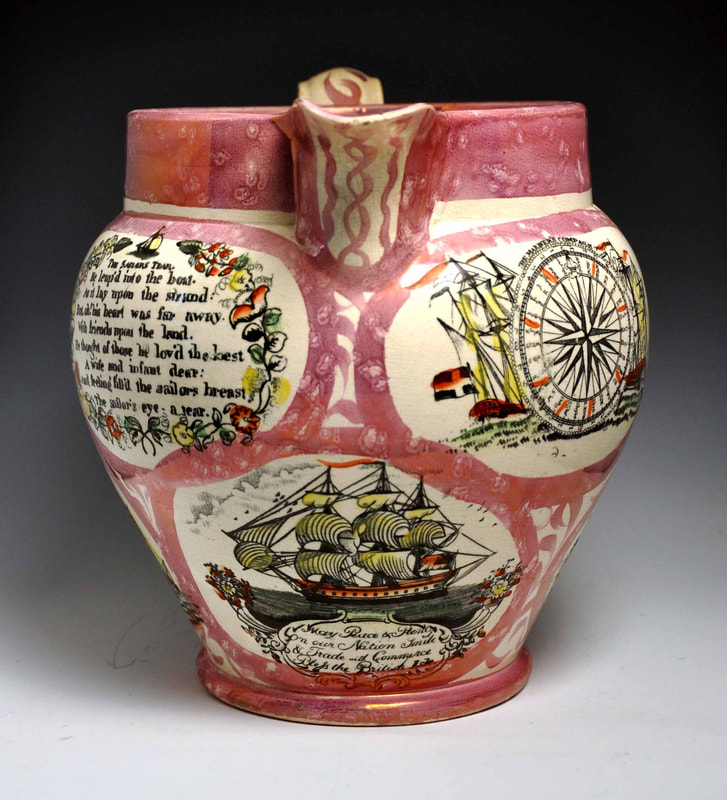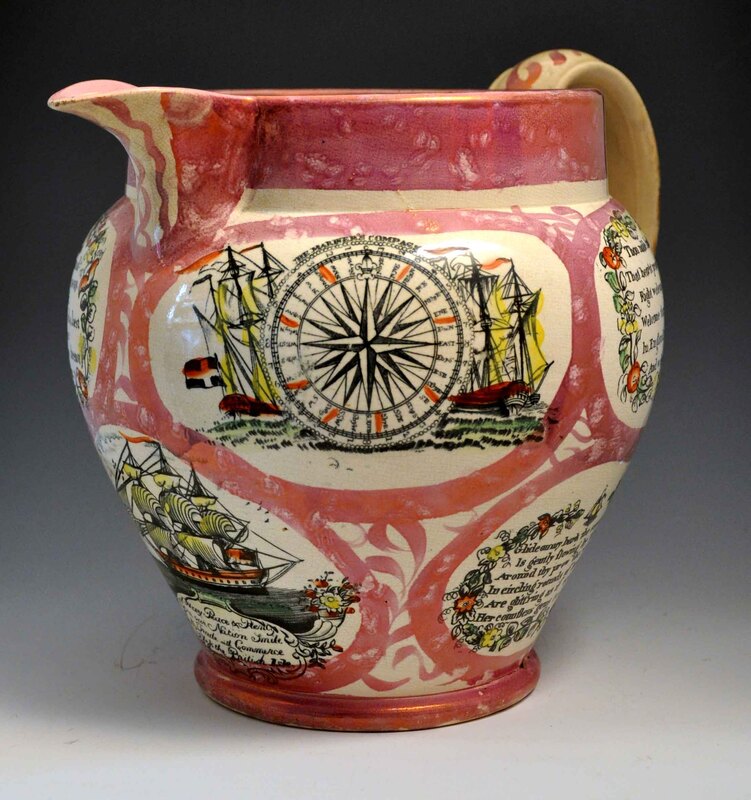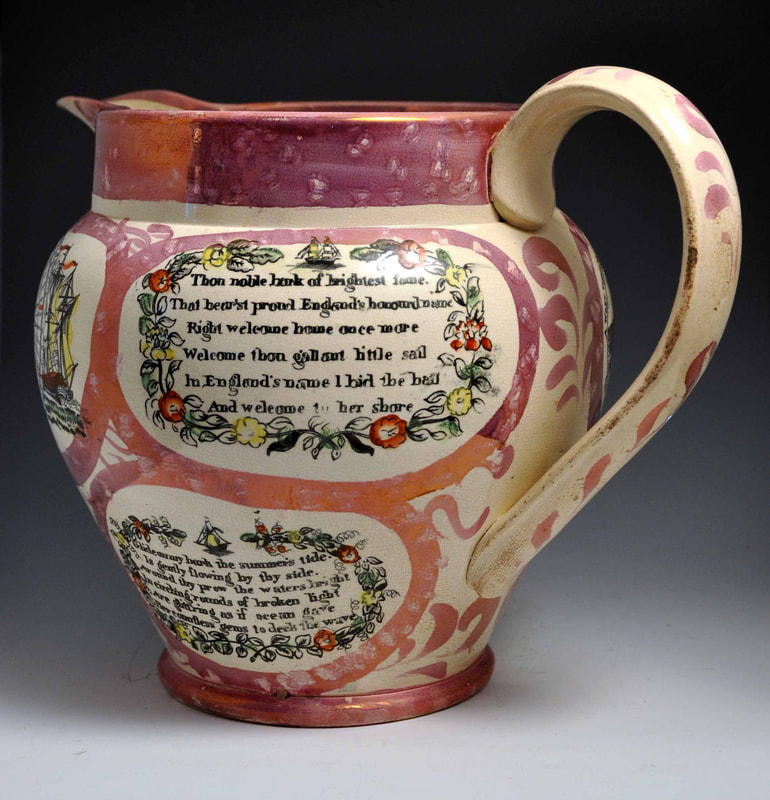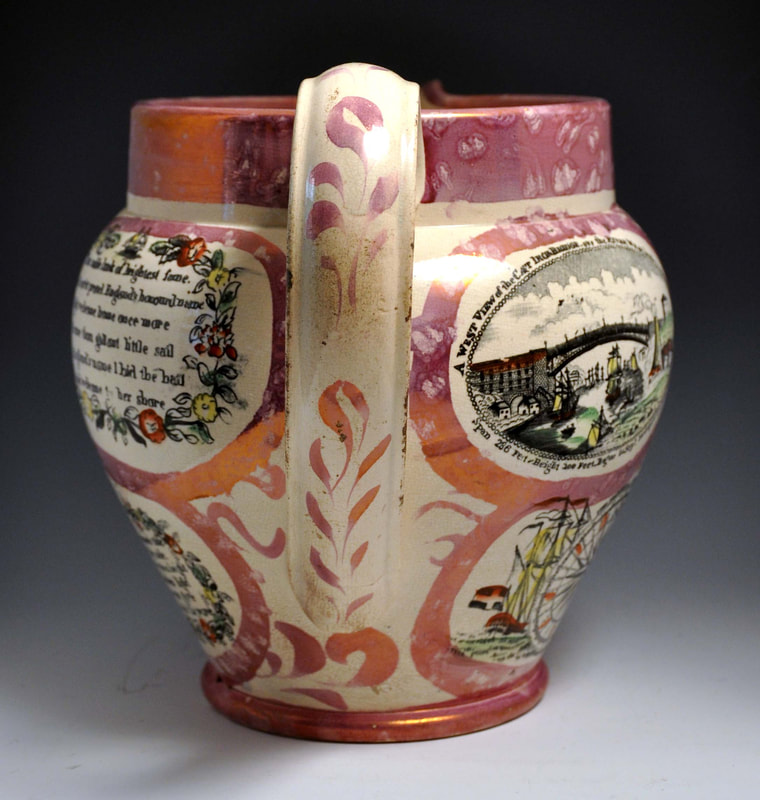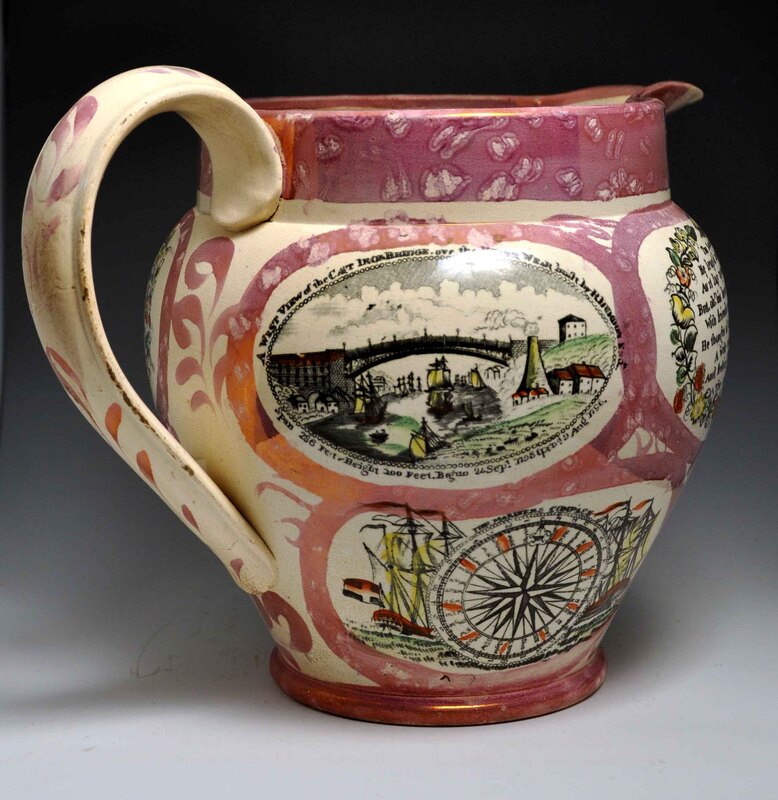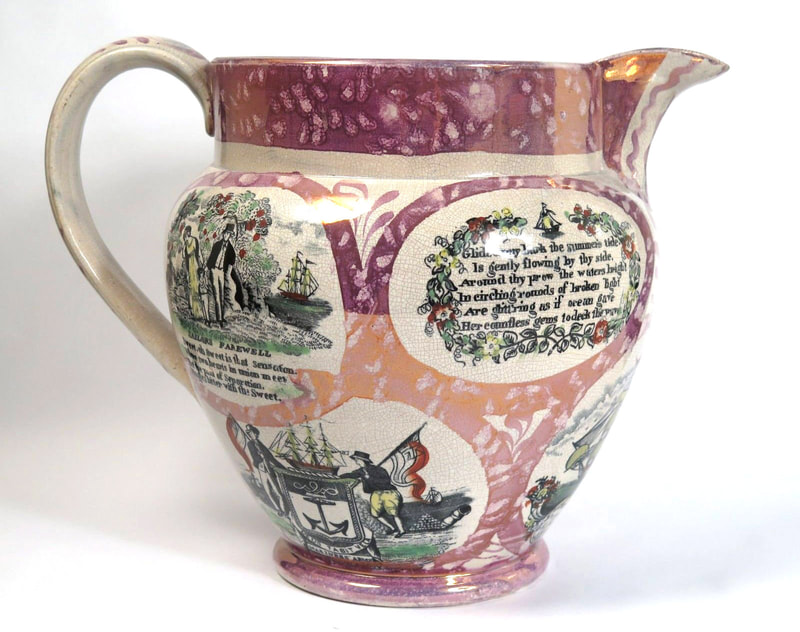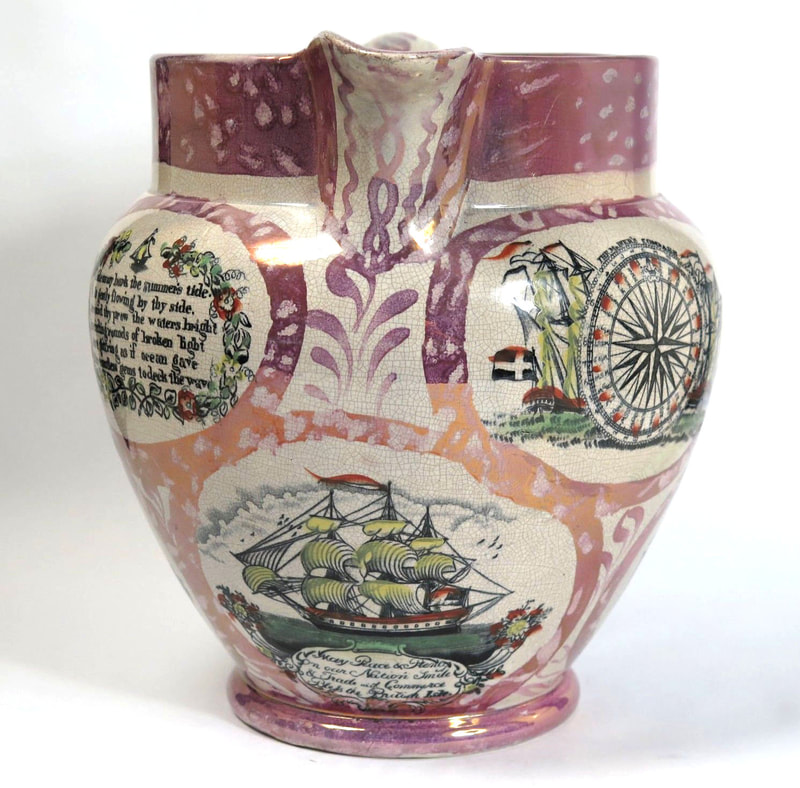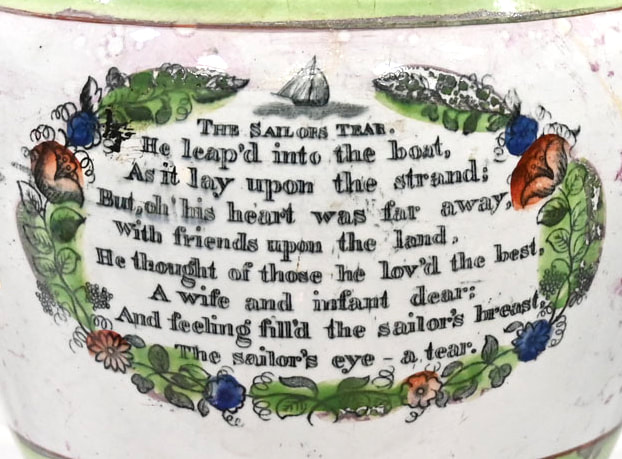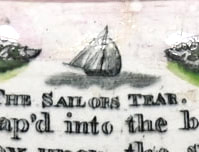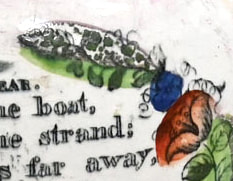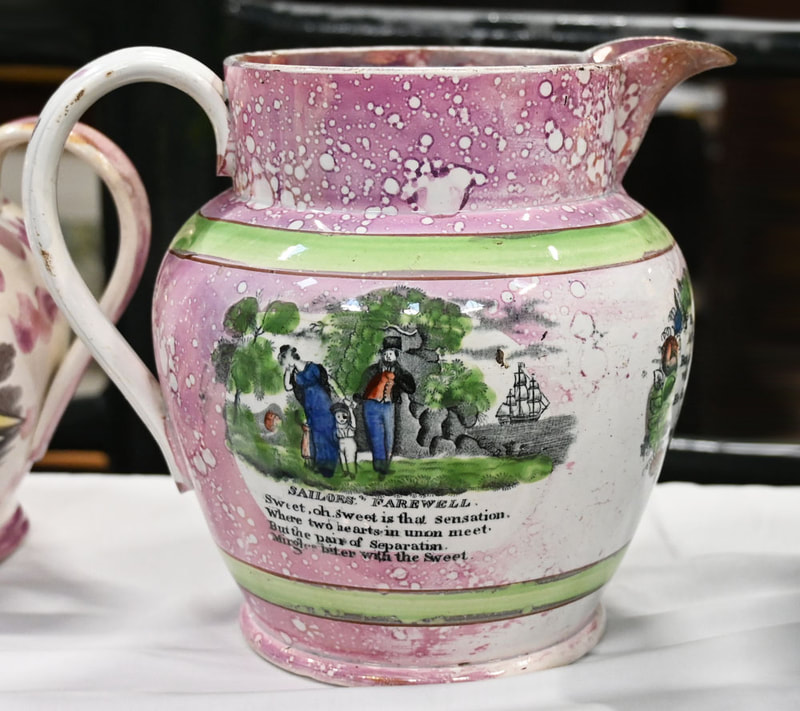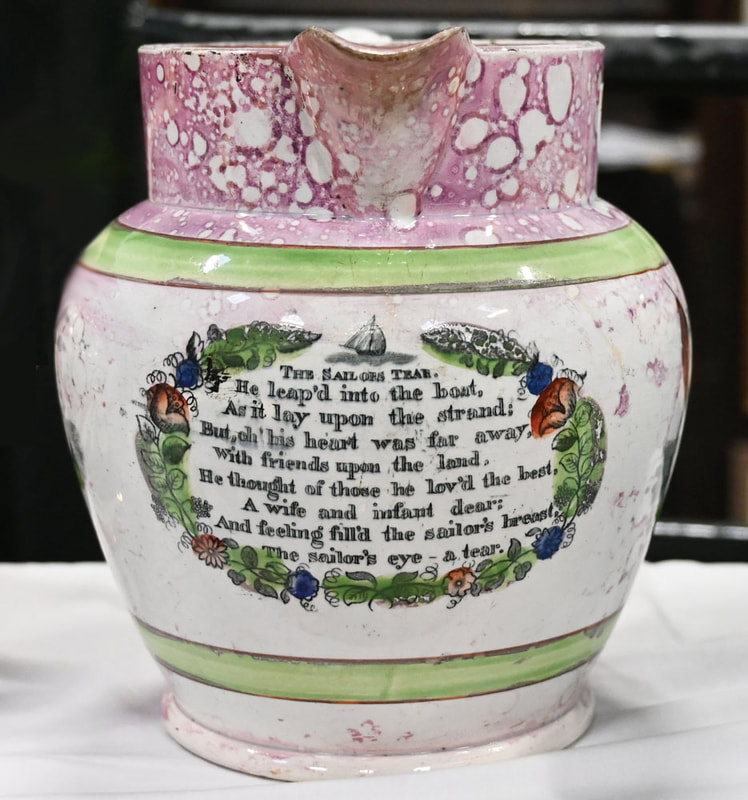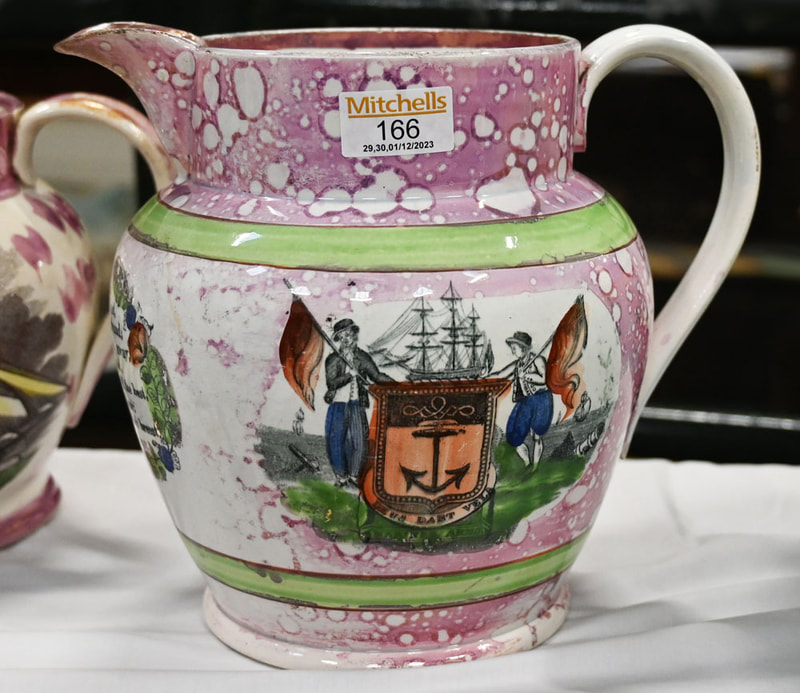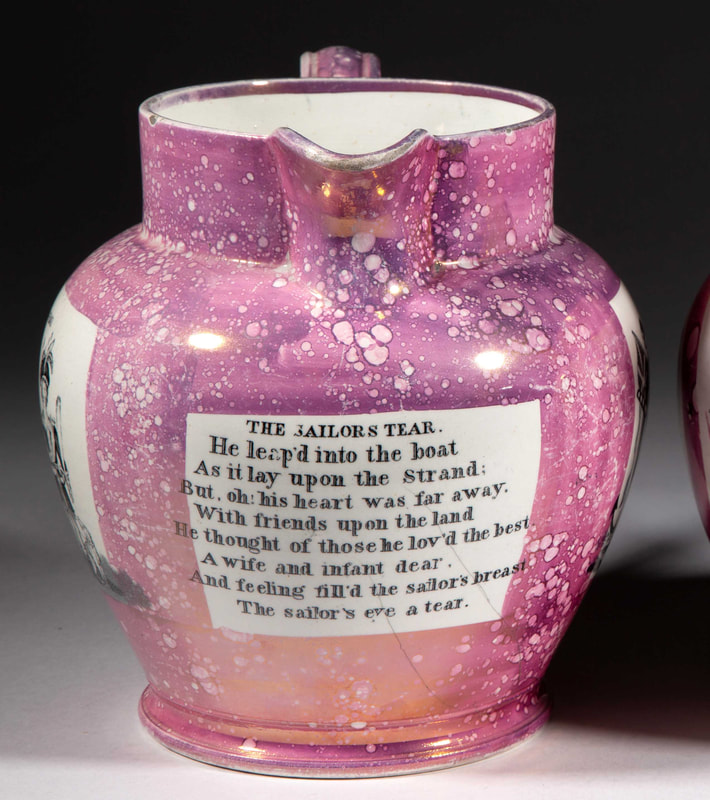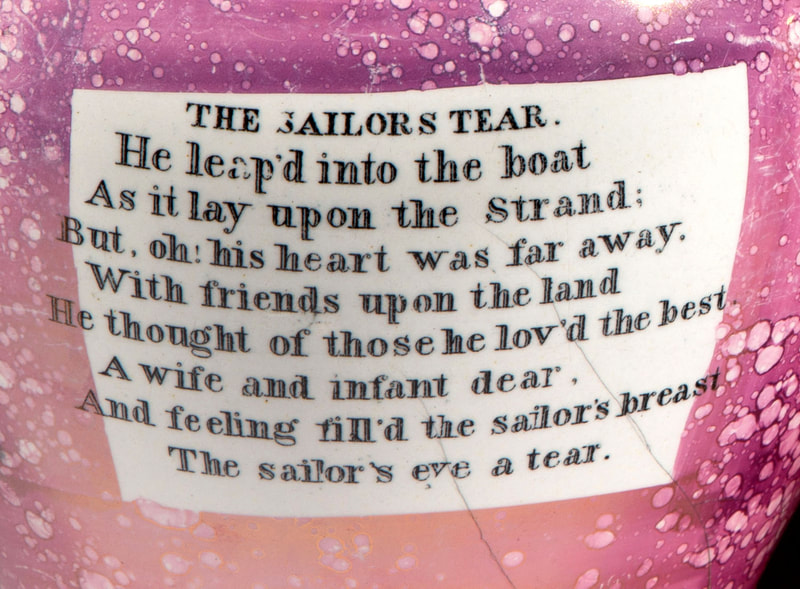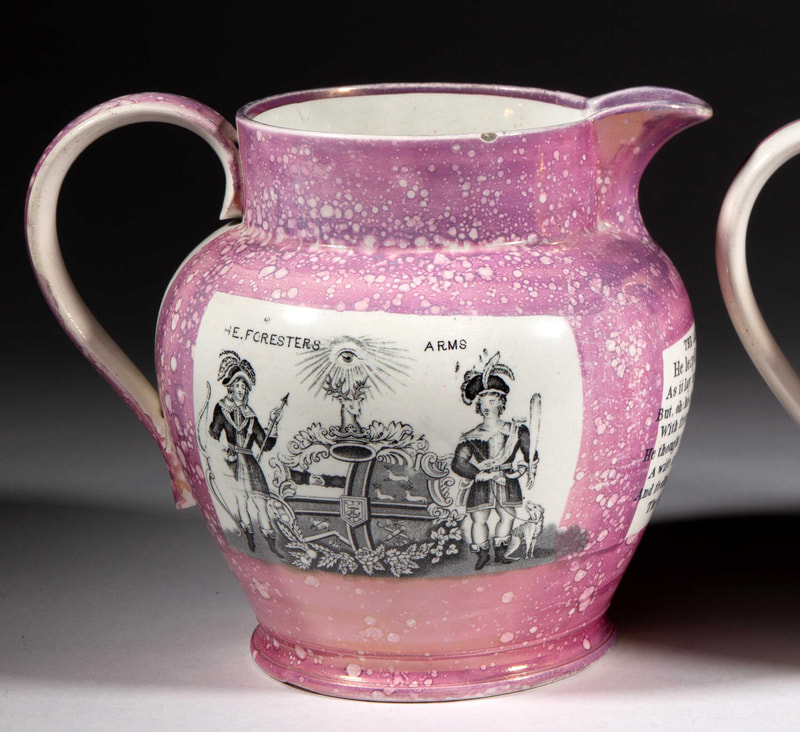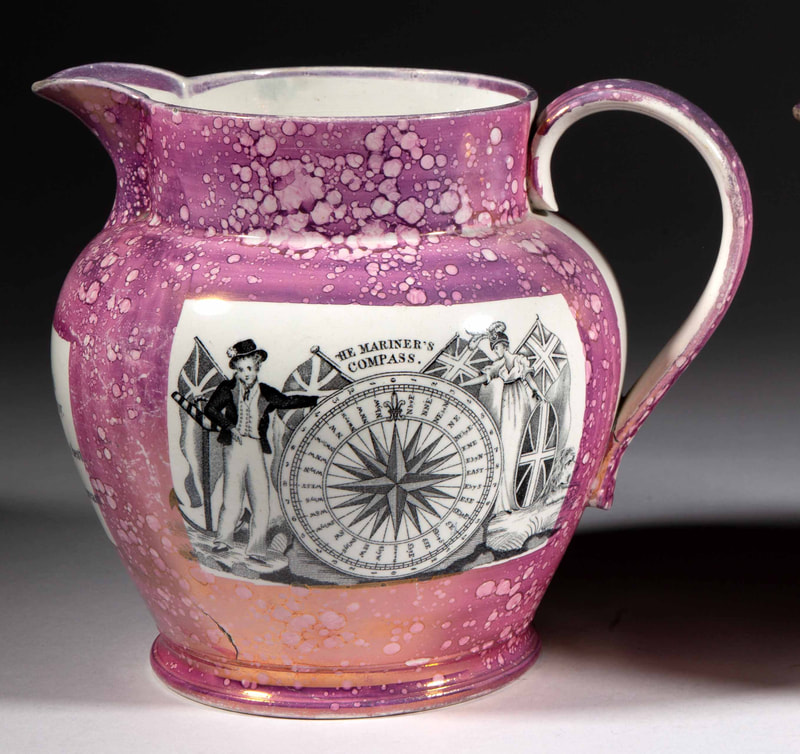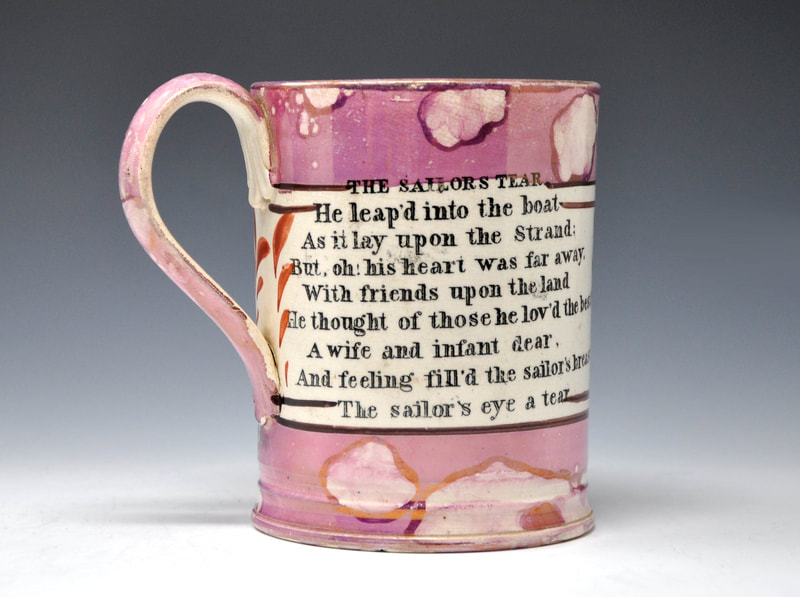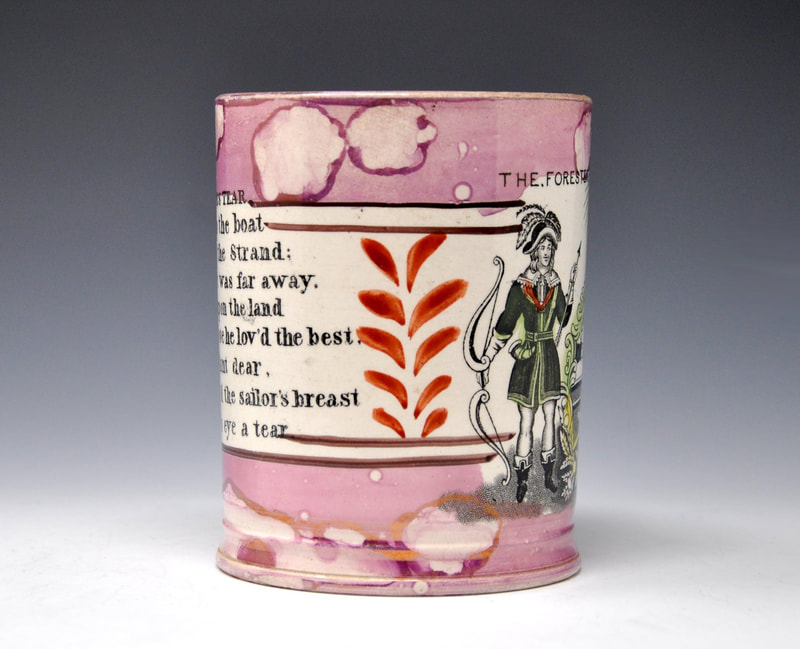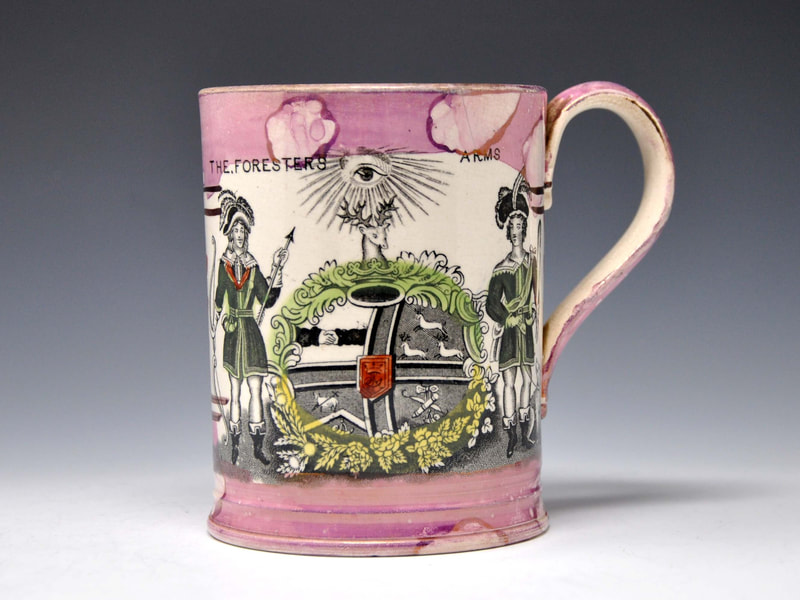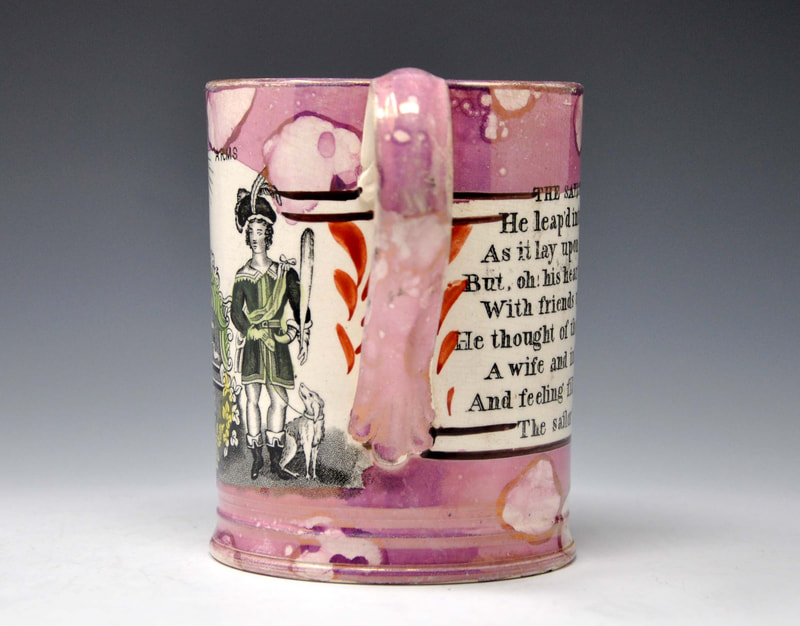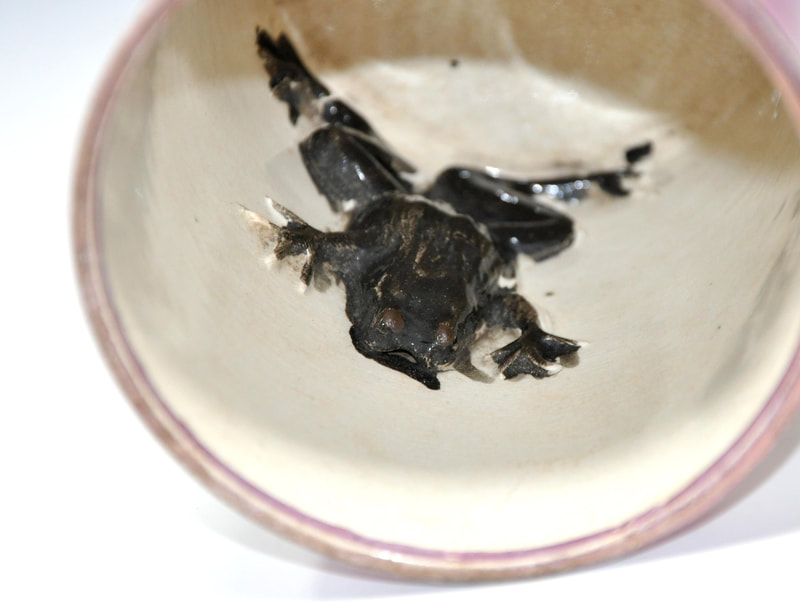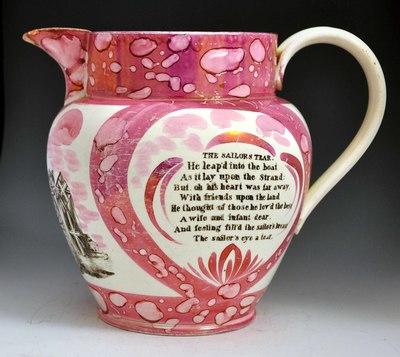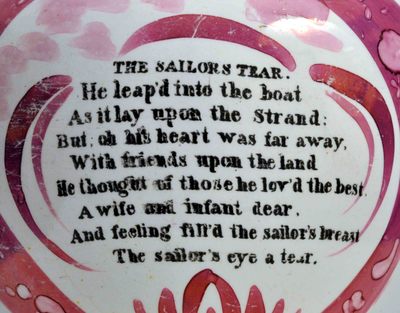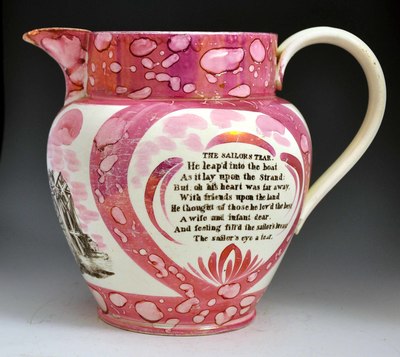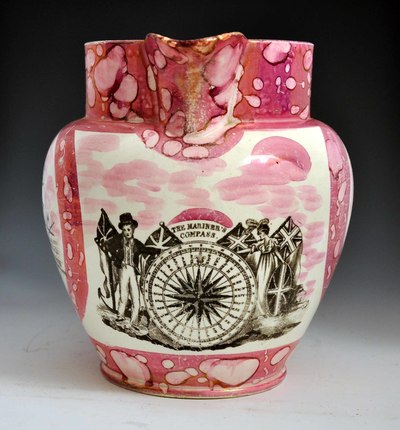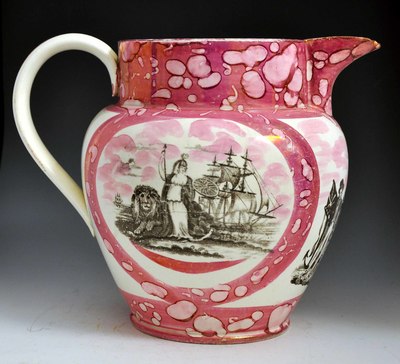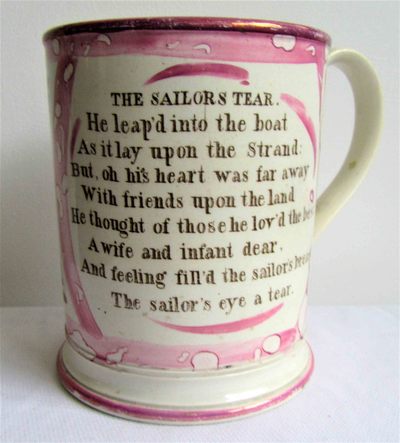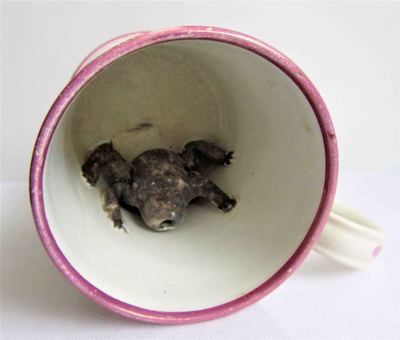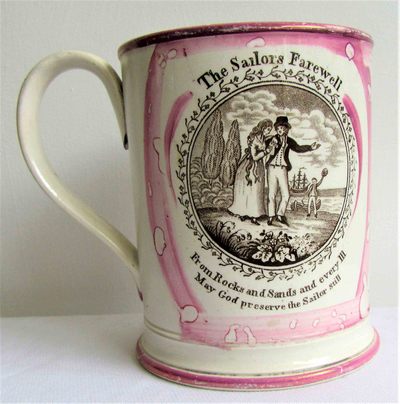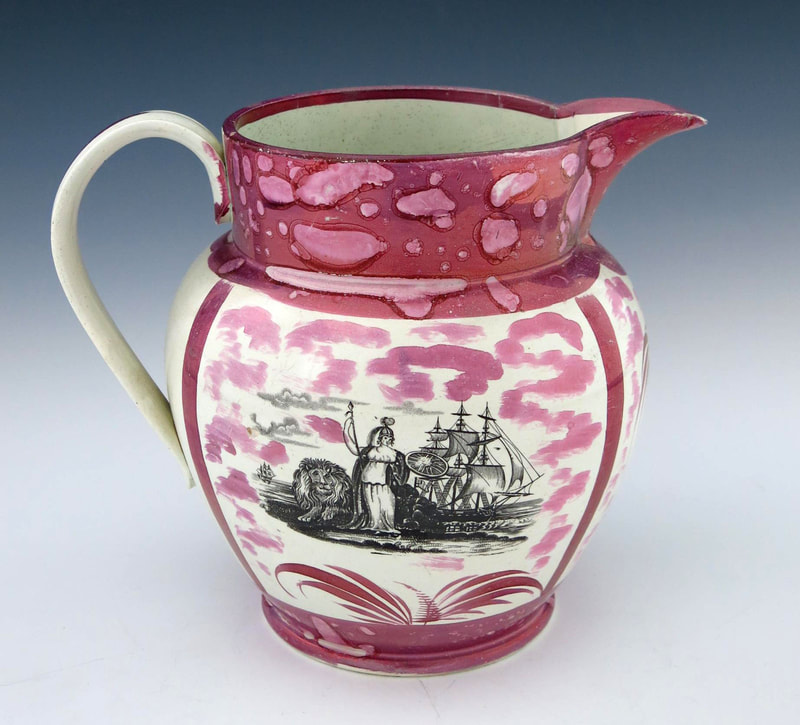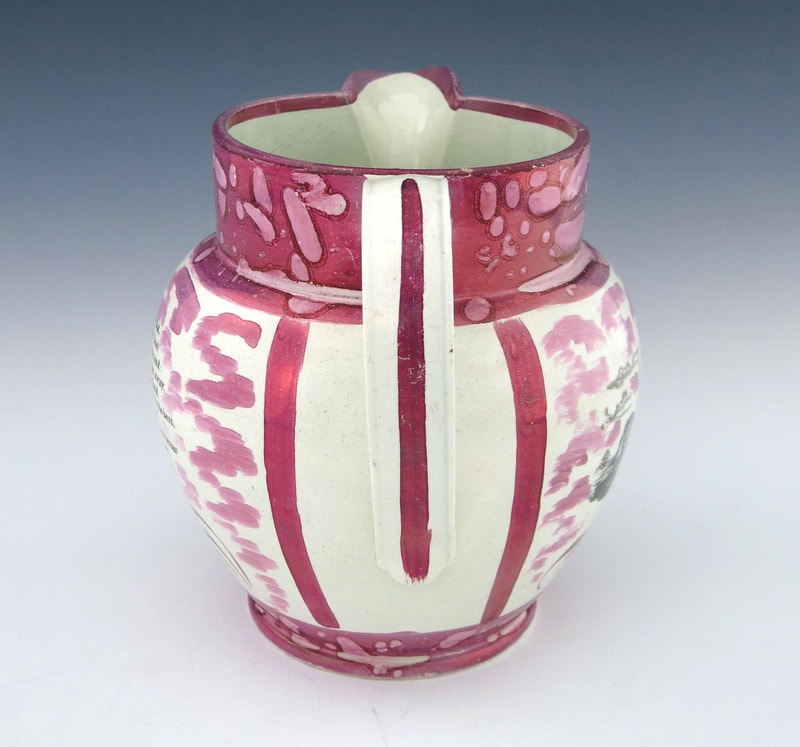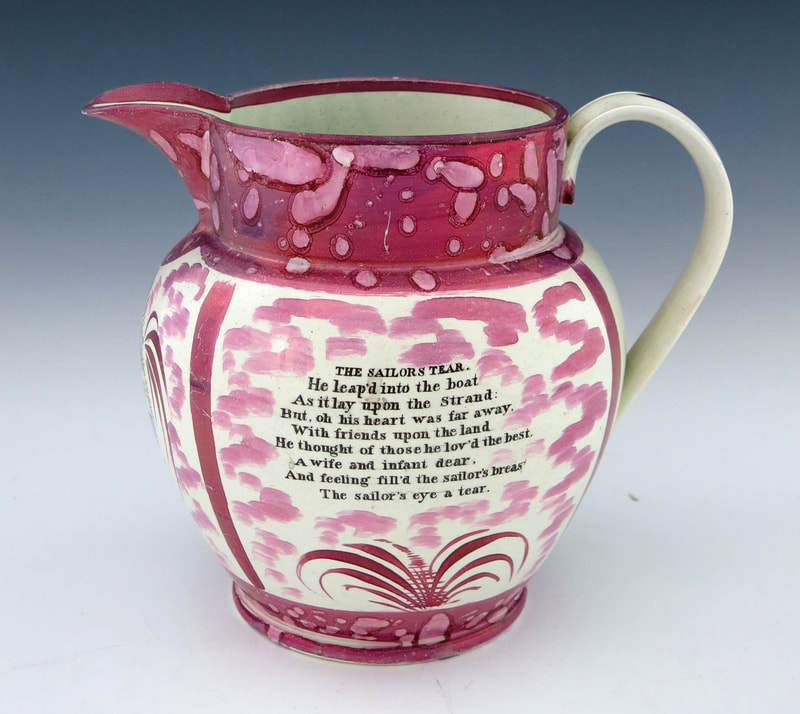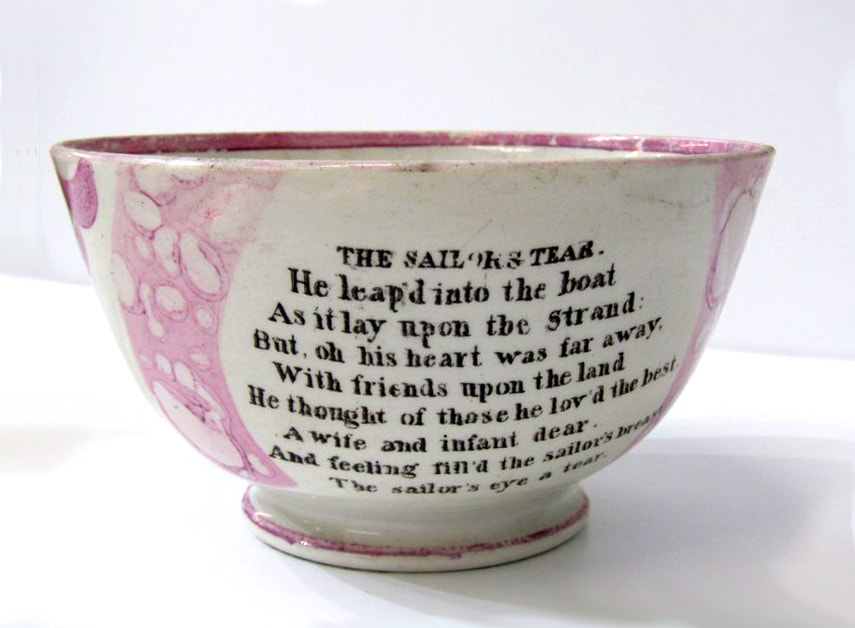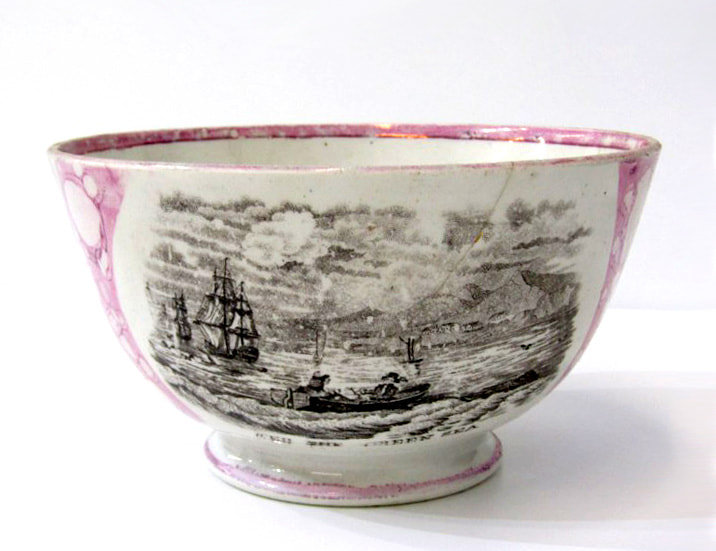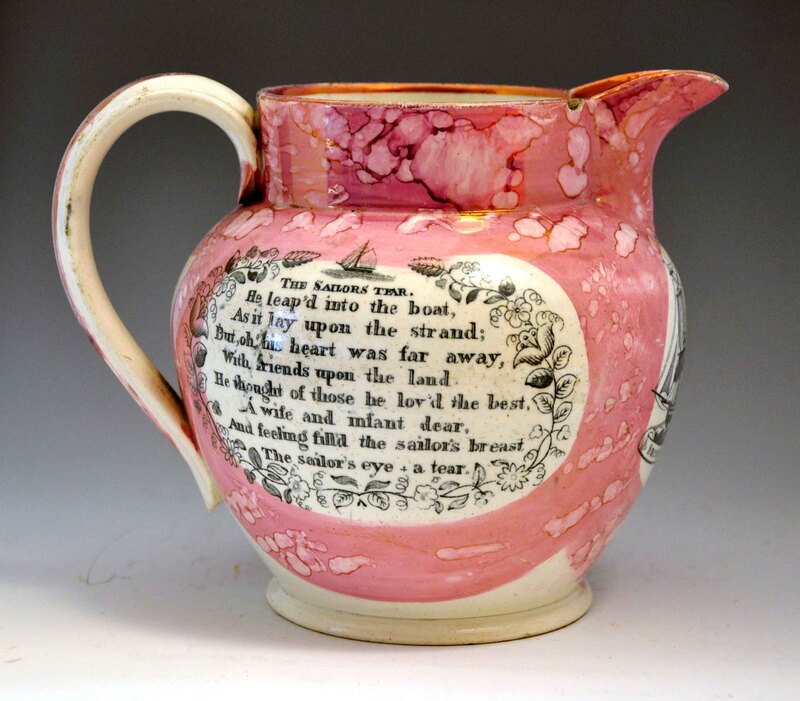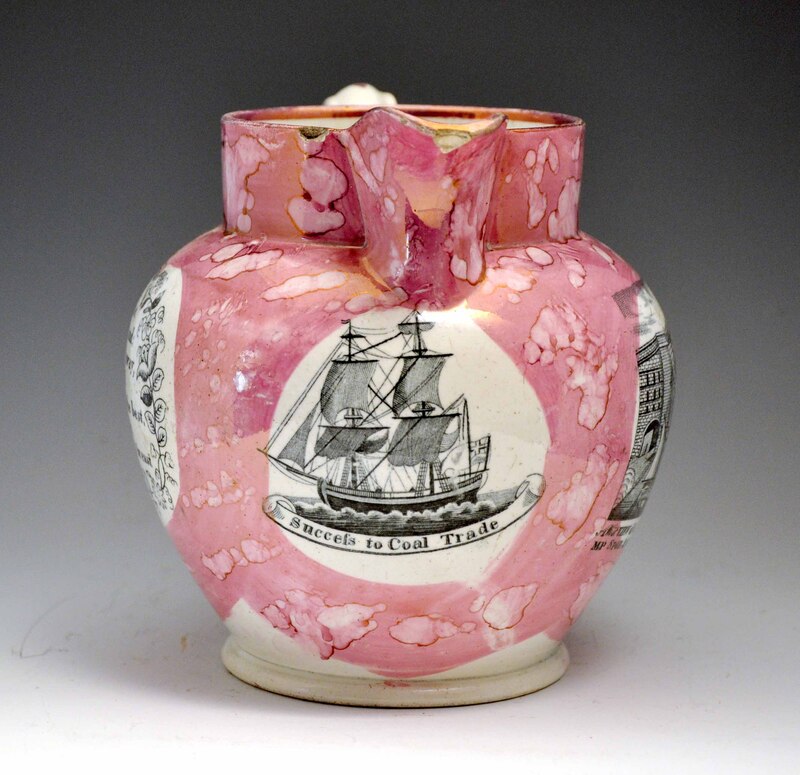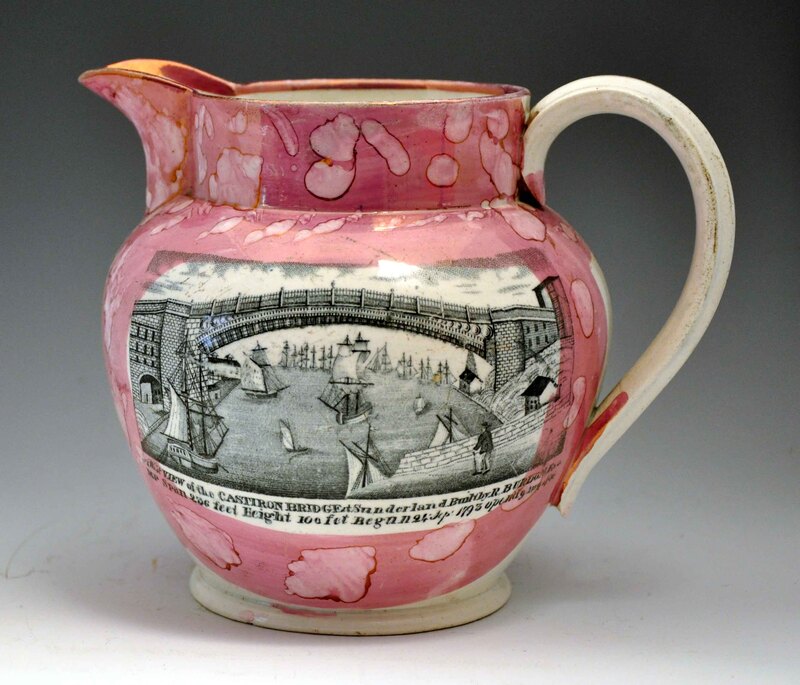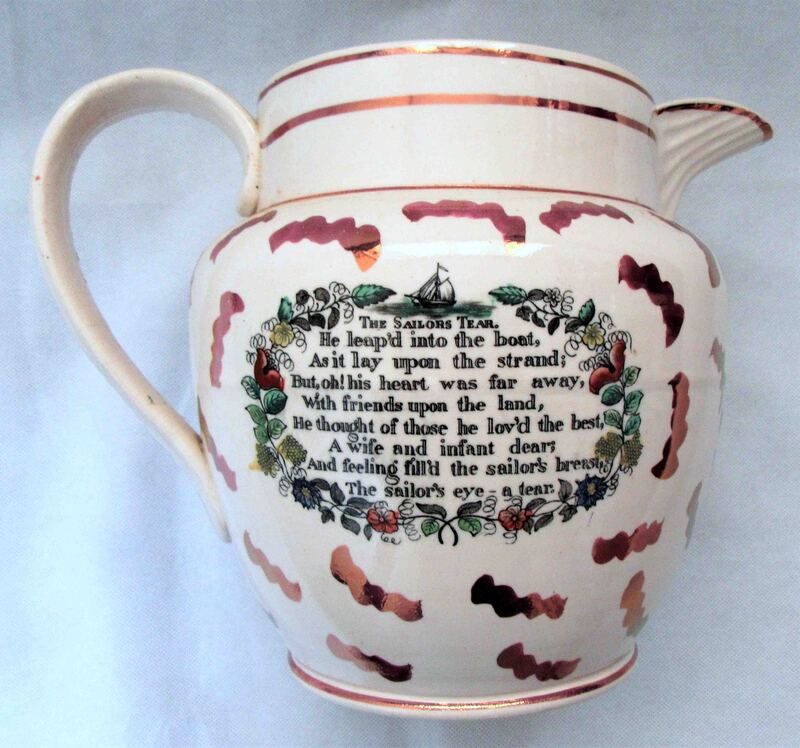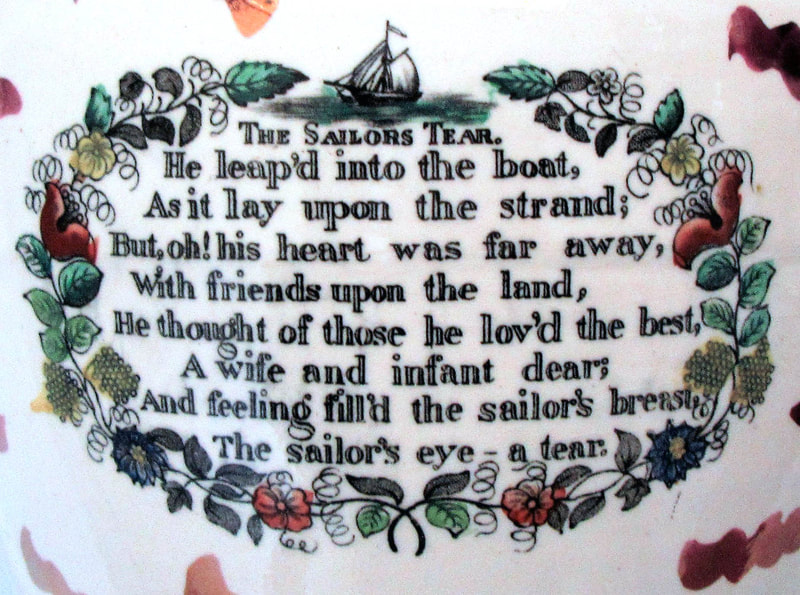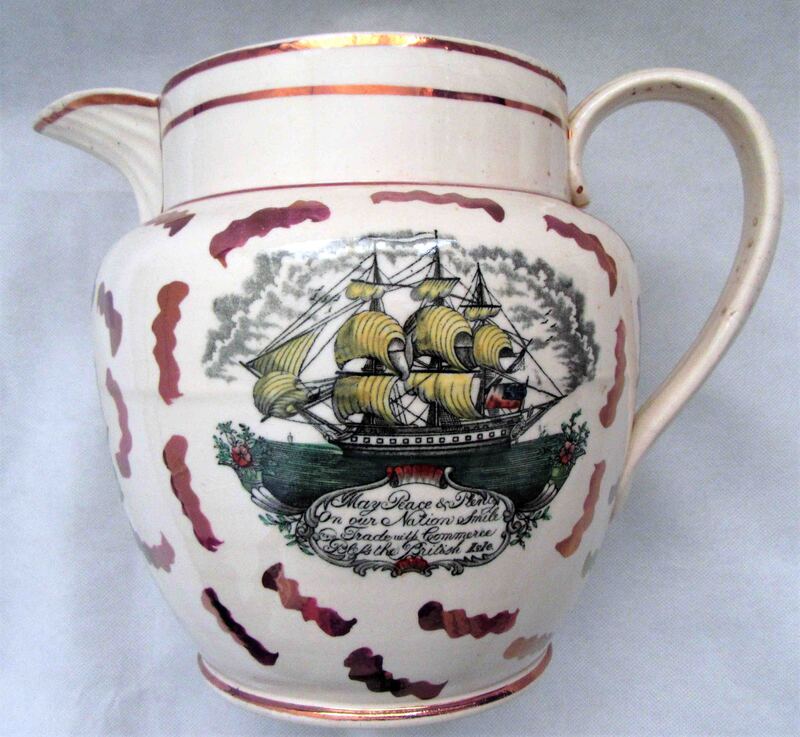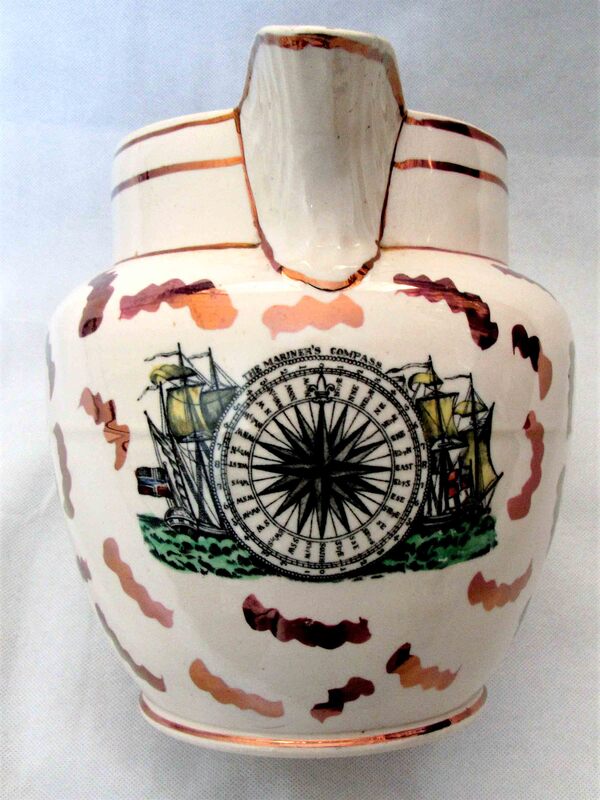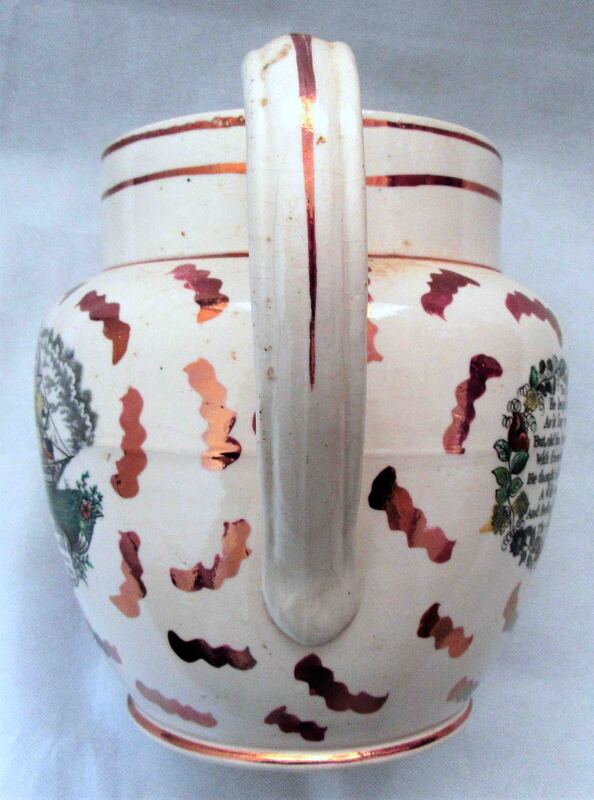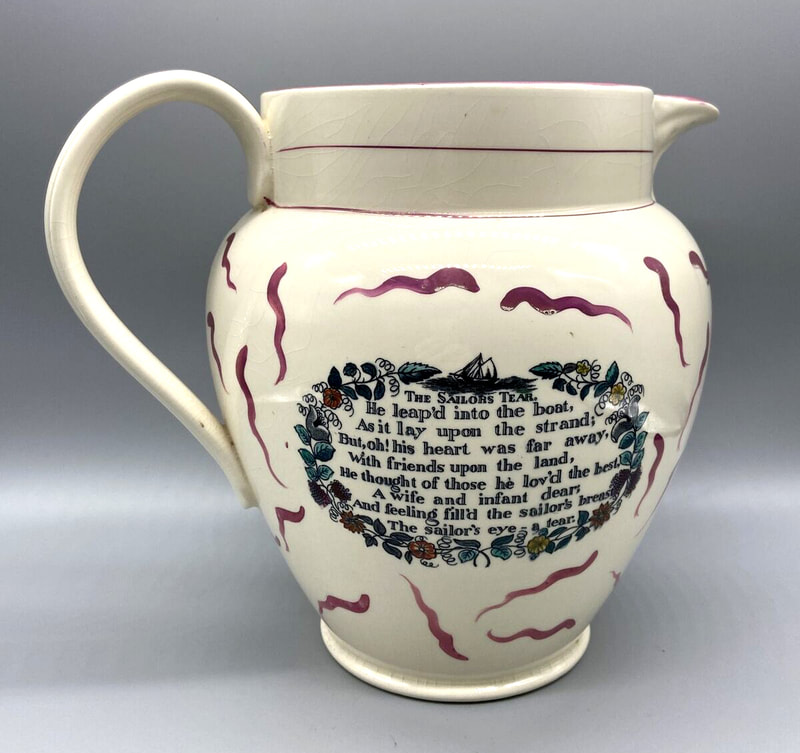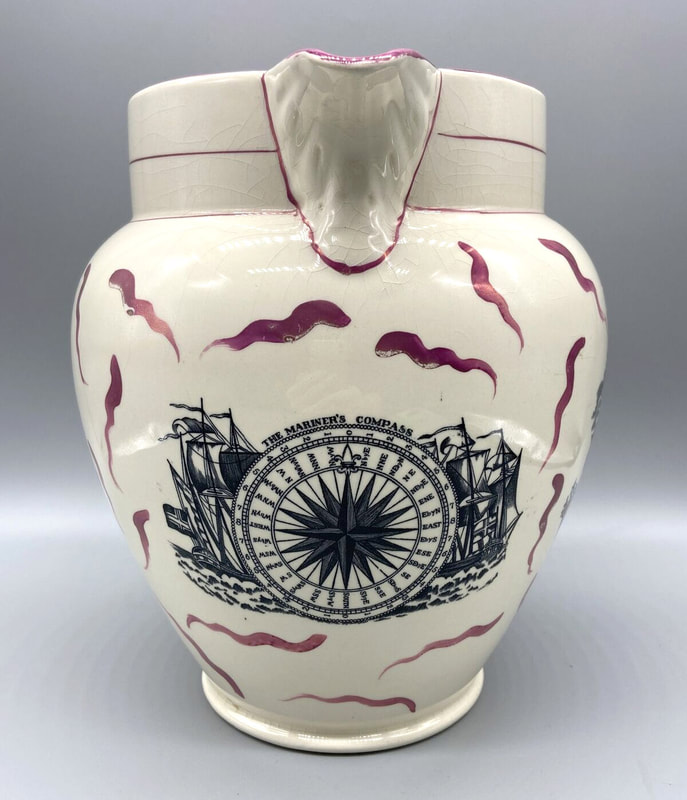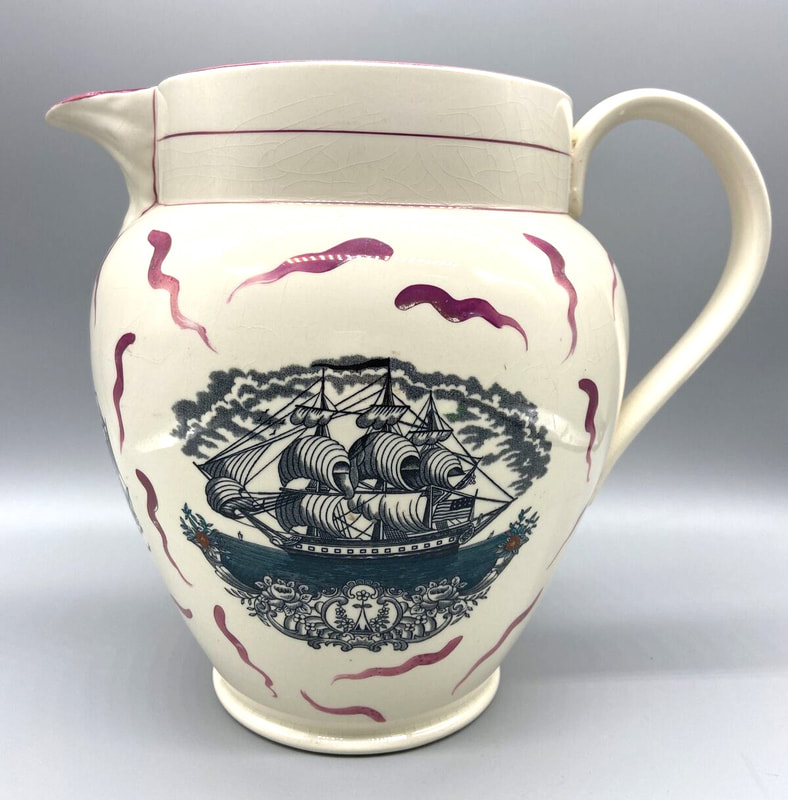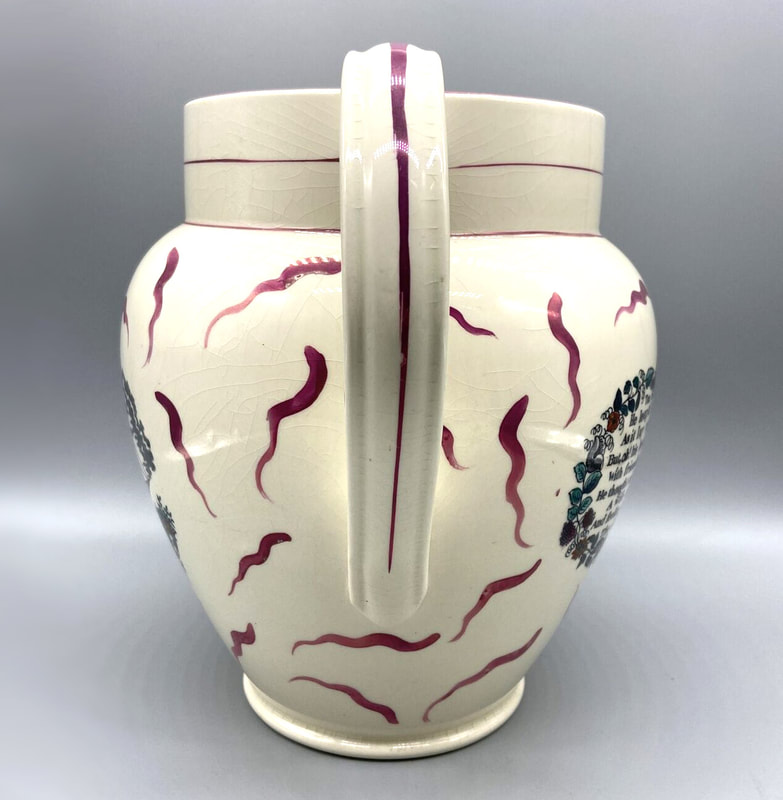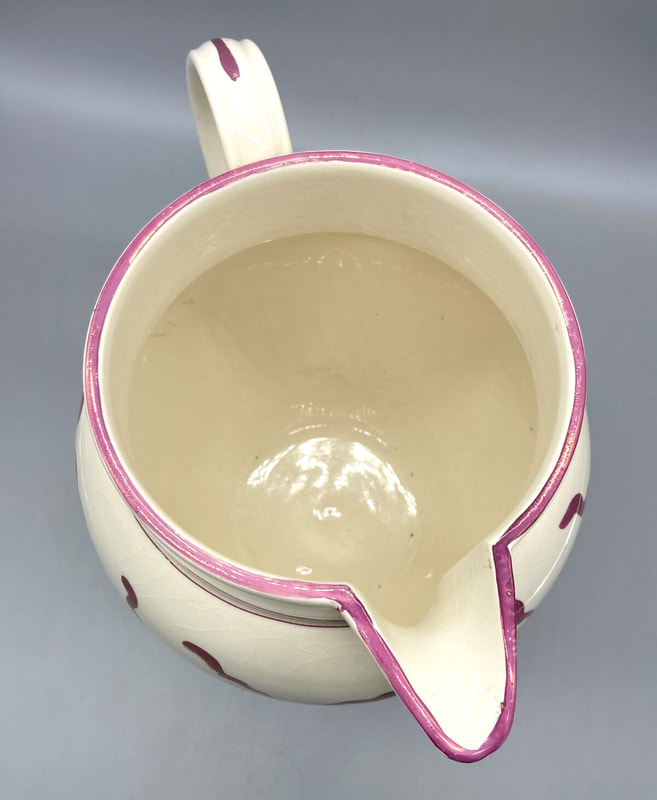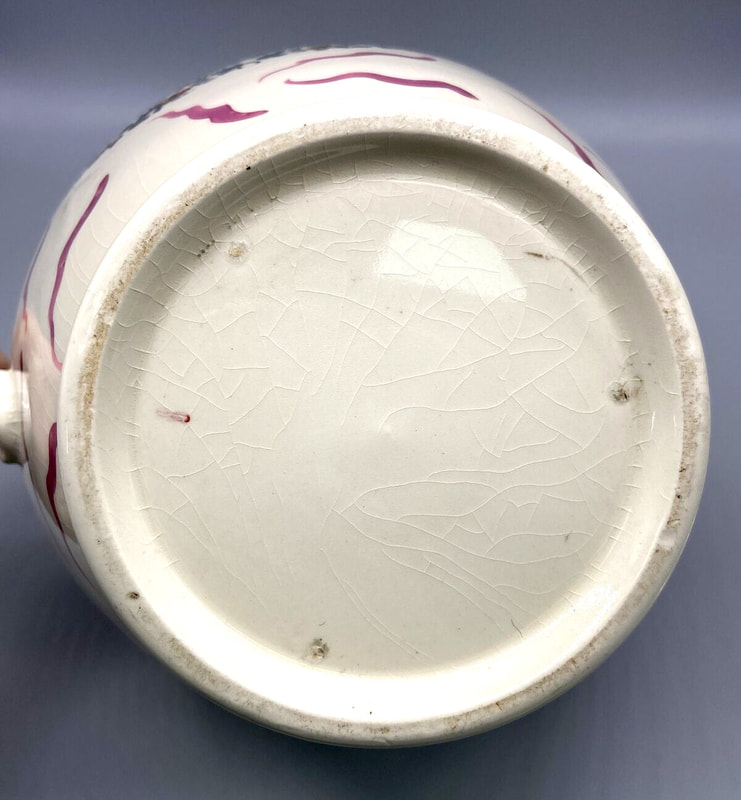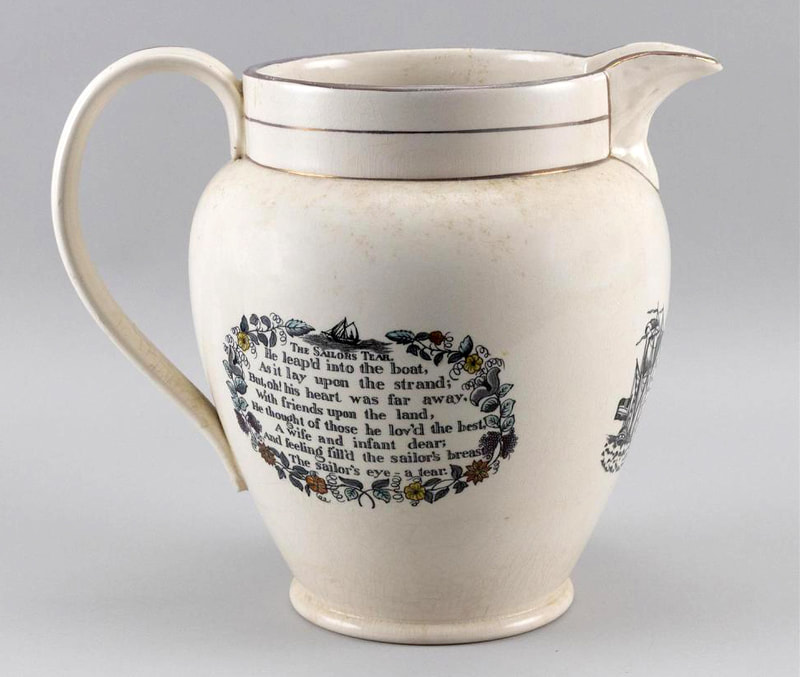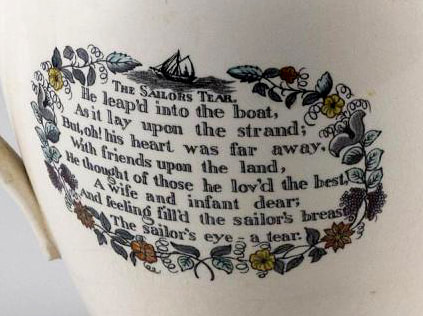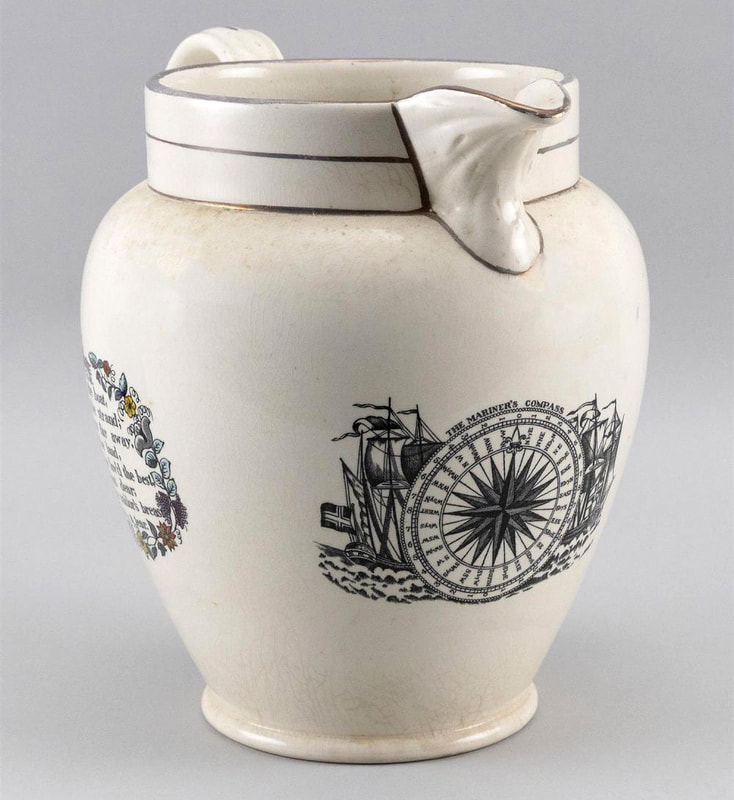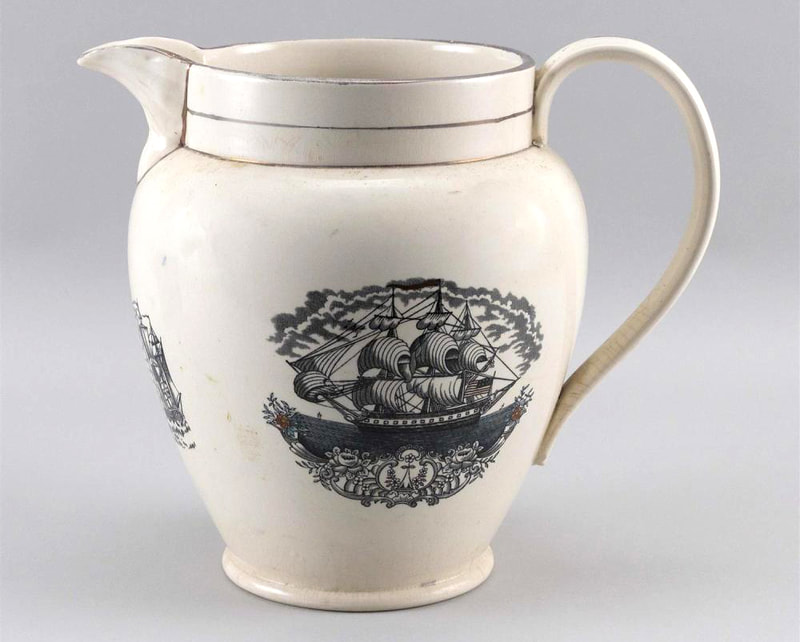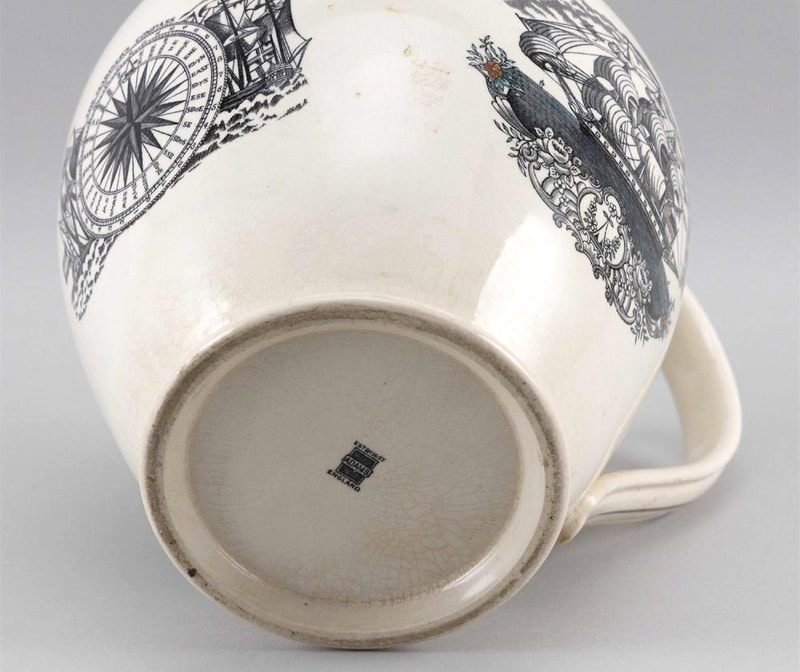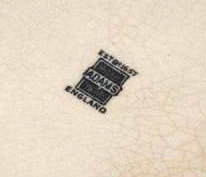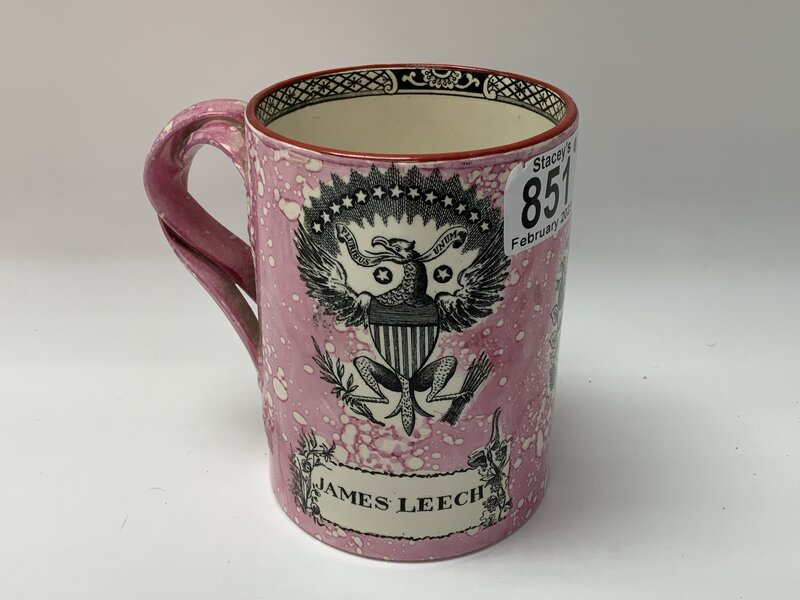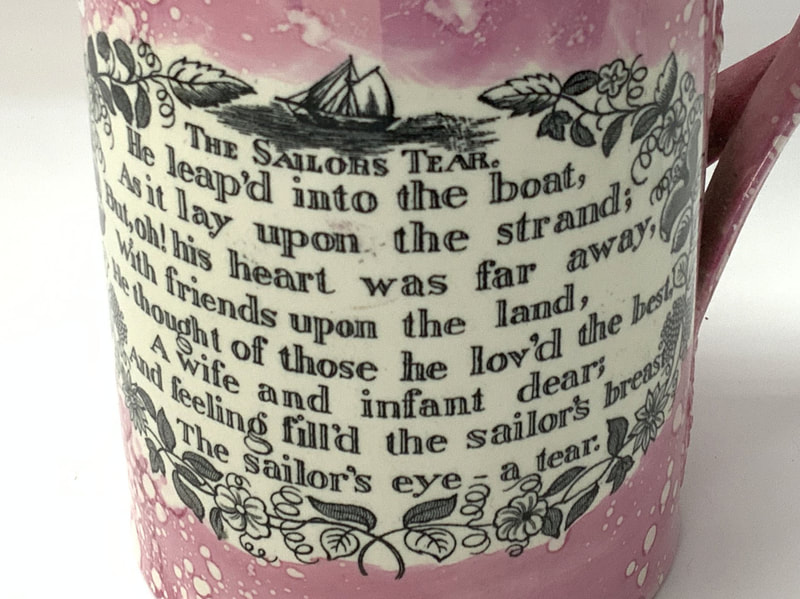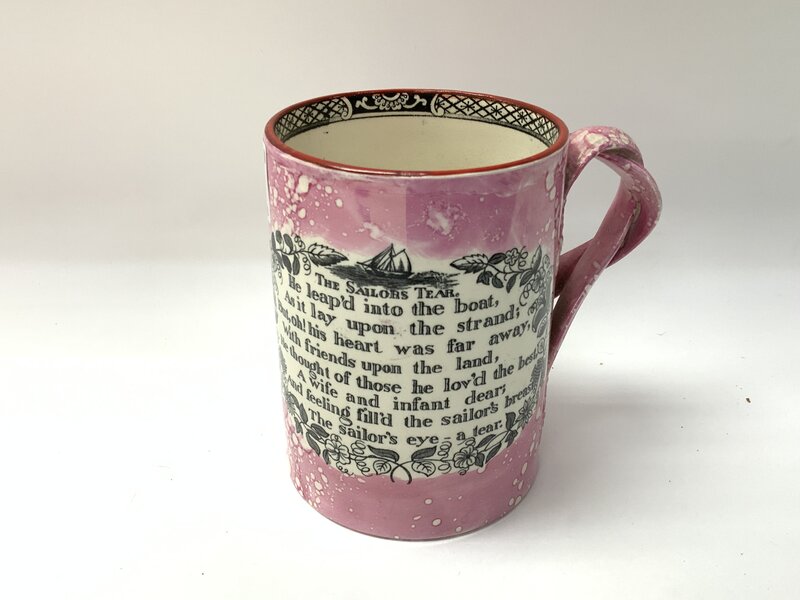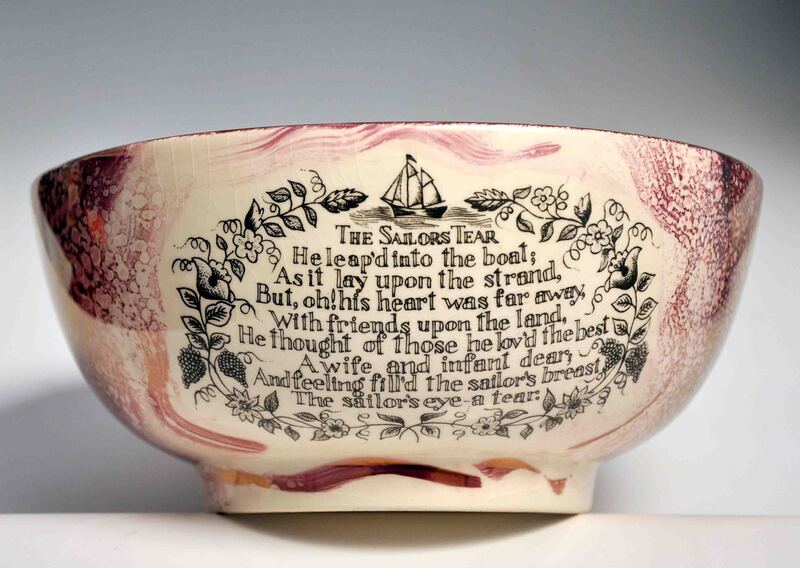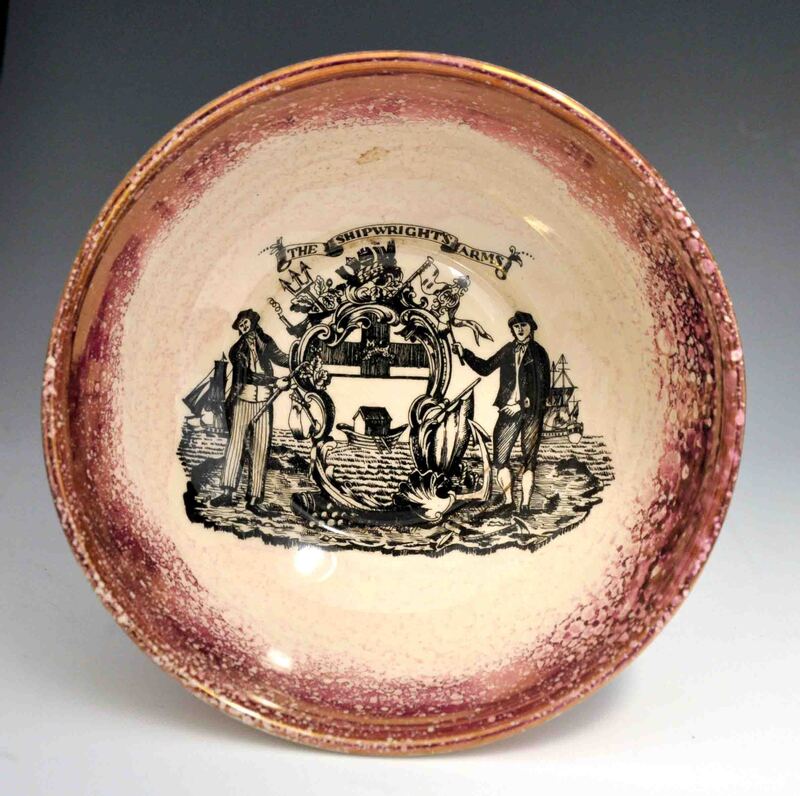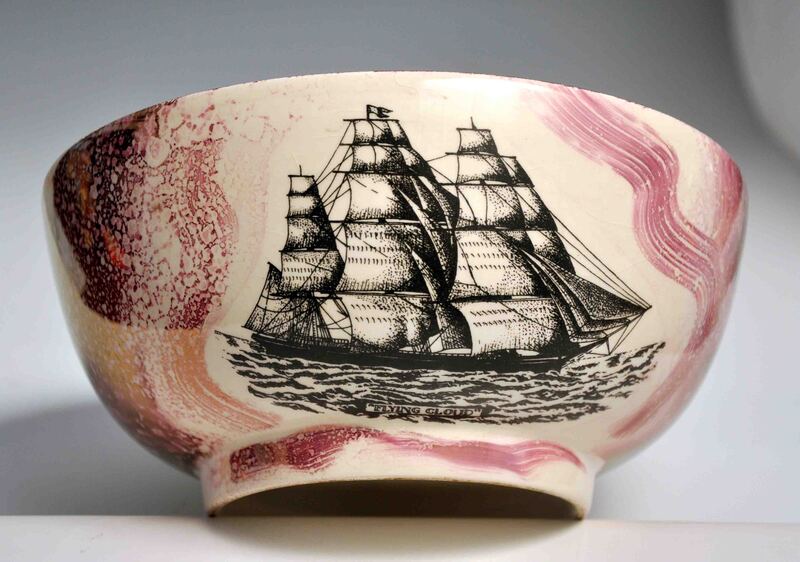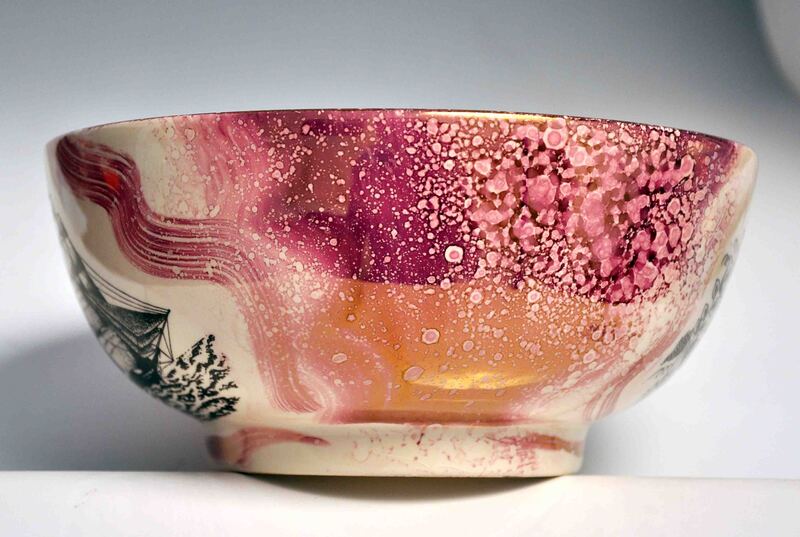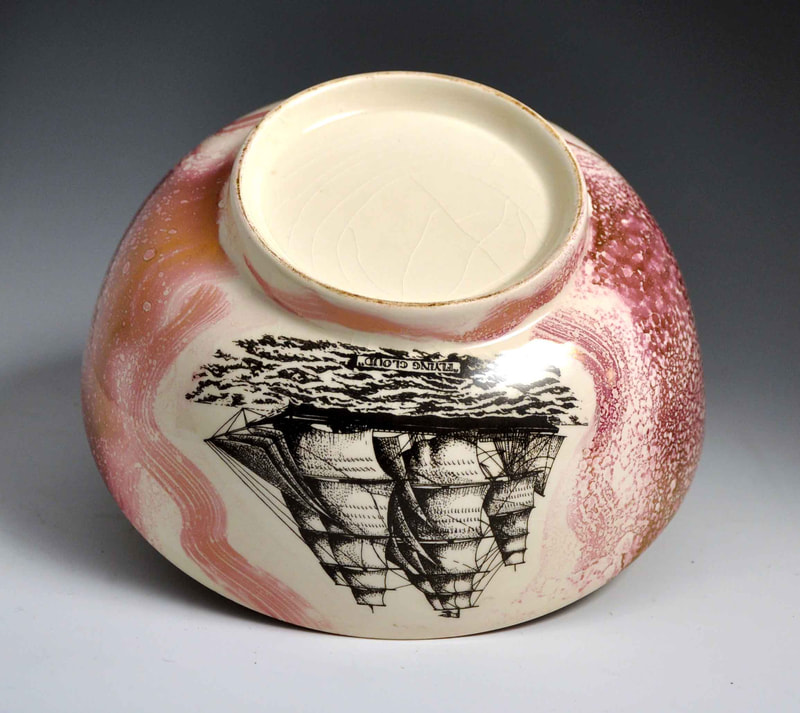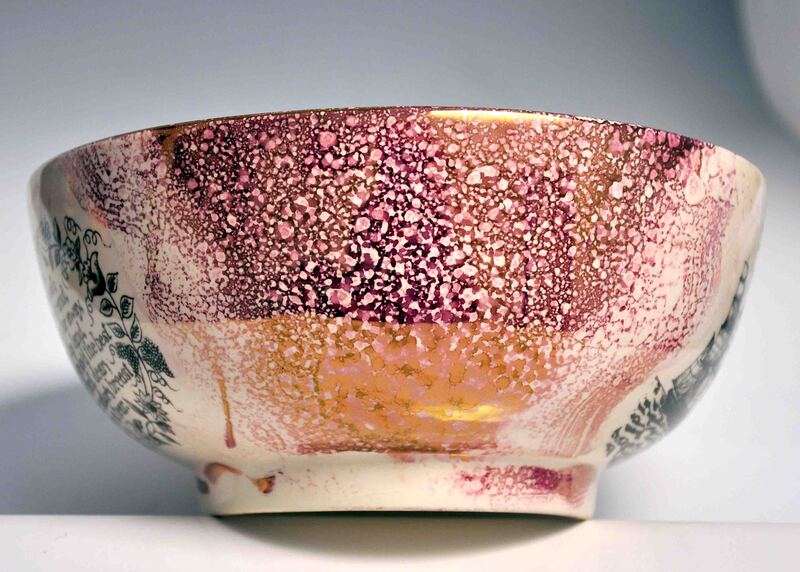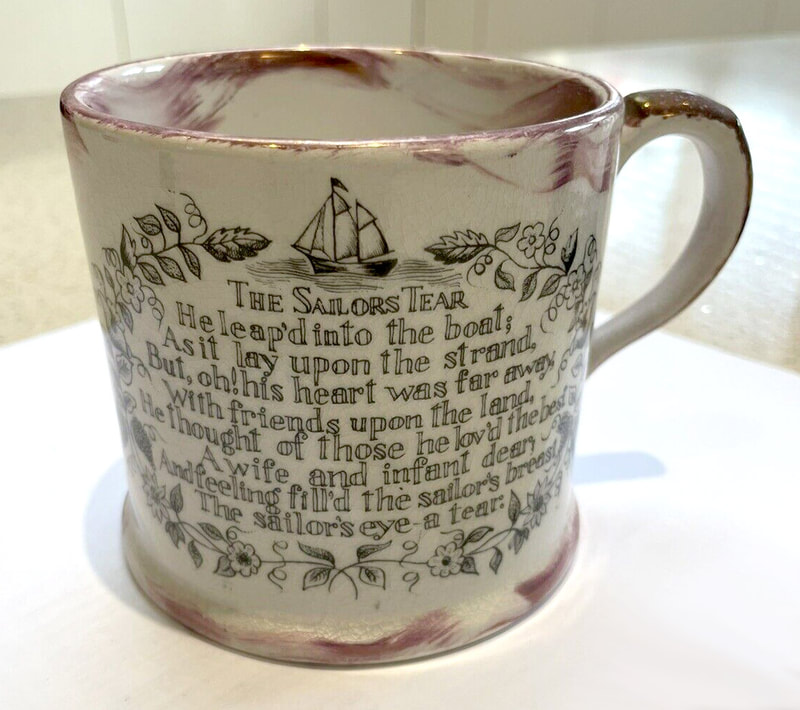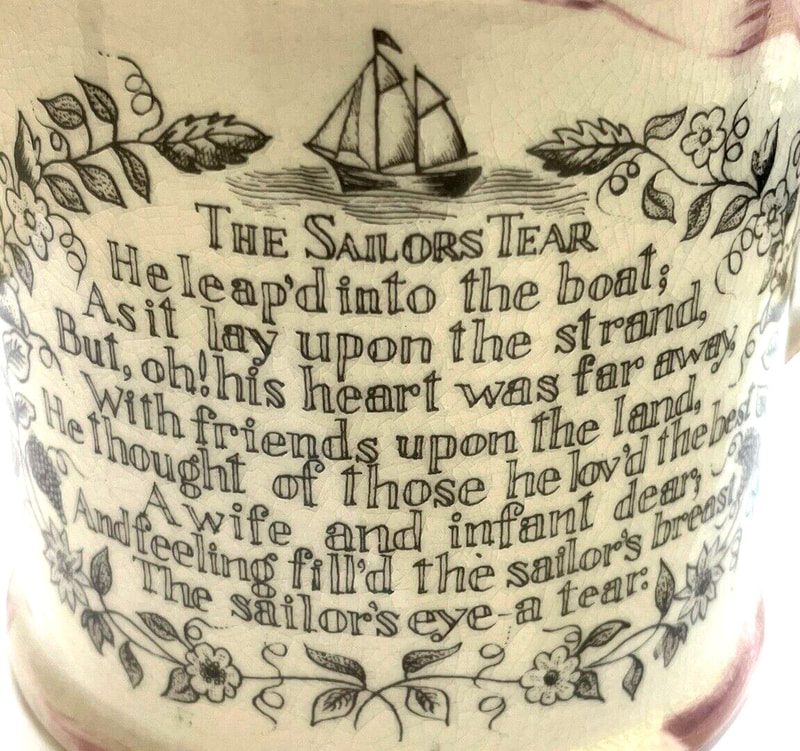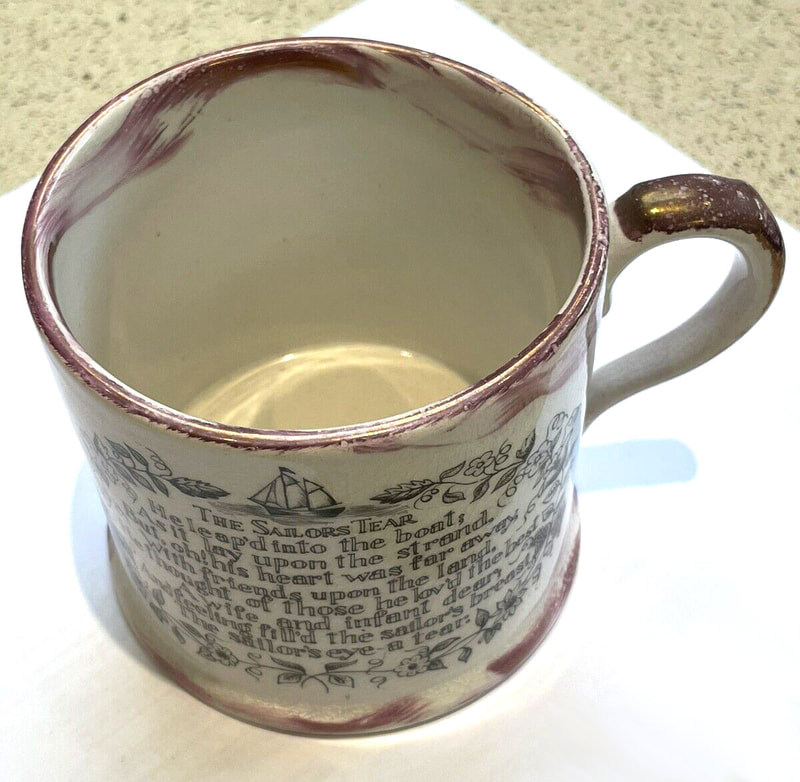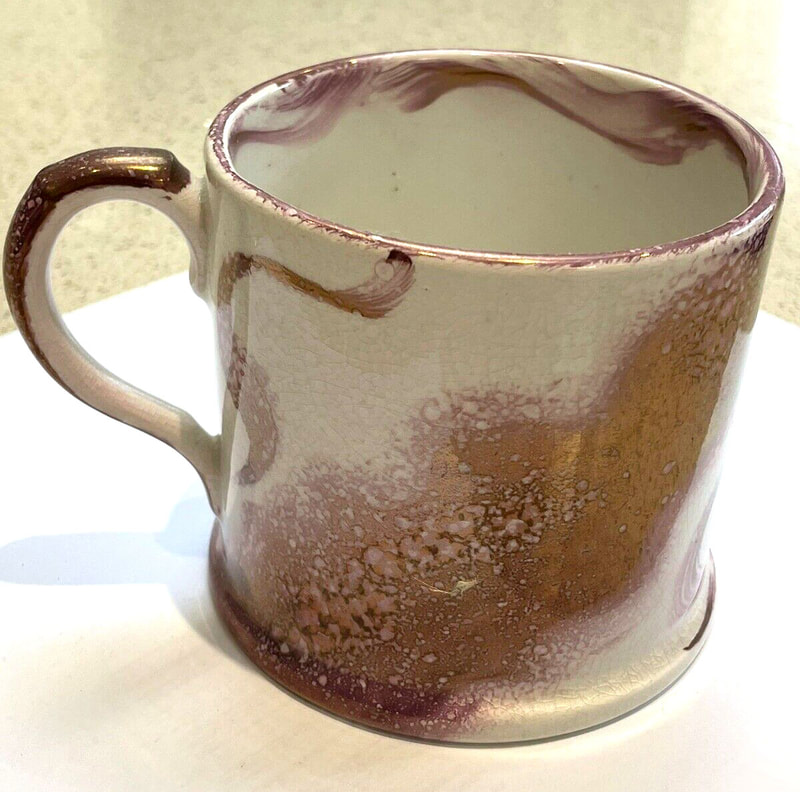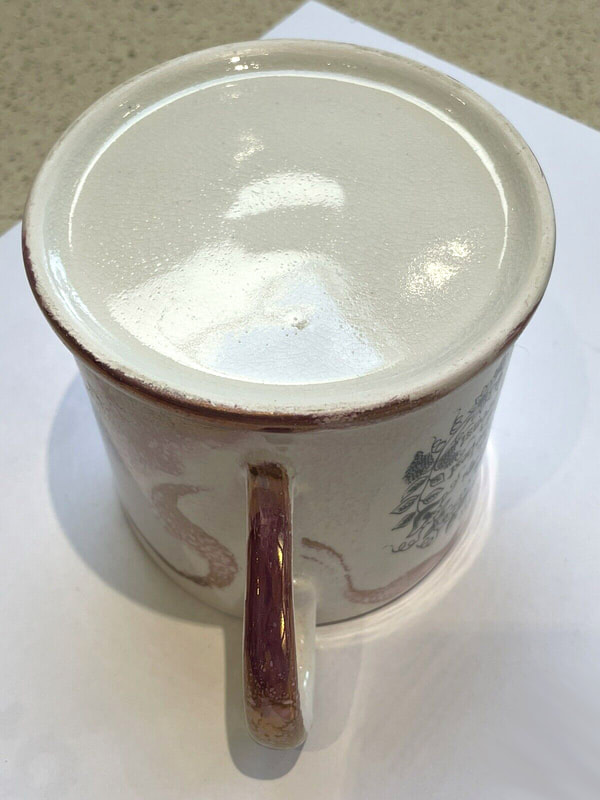The Sailor's Tear – Sunderland
Garrison Pottery
Two imprints from the same copper plate, the first with coloured enamels, and likely earlier, c1840s. The second is from a jug with the inscription 'Robert & Margaret Gove' and dated 1850, and the third from a jug with an inscription for 1855. By that date, the transfer plate had been reengraved. The ship acquires a flag on top and the shape of the water beneath it changes.
The transfer has a unique flaw – a long downstroke on the letter 'H' at the start of the poem's first line. The details from the items above, respectively, showing that the do come from the same copper plate.
The jug below has a transfer of Robert Peel, c1850.
Garrison Pottery later imprints
The mug above has the flaw on the letter 'H' still visible but the bowl does not. Both C 1860 with similar enamel decoration.
Newbottle Pottery
It is hard to date these Newbottle-attributed items. The plaque below could be as early as the 1840s. The transfer has very distinctive lettering.
There's a scratch running through the word 'friends' and then down to 'wife' and appears to become more pronounced over time. In the left imprint below, from the plaque, there is no trace of the scratch, suggesting this is an earlier item (pre-scratch). The middle detail is from the first bowl below, and the right imprint from the jug.
A bowl with the whole range of Newbottle maritime transfers, presumably side by side on the same copper plate.
A jug with darker lustre, perhaps from the 1850s.
Below a wash ewer and bowl with faded lustre decoration, and a lidded pot with flowers on the lid.
The scratch is much more pronounced on this bowl and appears to have widened over time.
Scott and Sons, Southwick Pottery, 1829–1841.
Above, two tankards with the printed mark under the verse 'Scott & Sons Southwick'. Below, a nice crisp image of the transfer on an eel pot, but trimmed to fit, so the maker's mark is missing.
Below a jug with the same transfer.
The decoration around the collar of the jug and under the spout is typical of Scott's pottery and was used as late as 1860. This jug c1840.
Scott Brothers and Co, Southwick Pottery, 1841–1872
This is the same transfer as above, but with the mark obliterated. It seems likely that the printed mark 'Scott & Sons' was erased when the partnership changed at the Southwick Pottery in 1841. Below, an example with an inscription for 1843.
Seaham Pottery
The transfer on this c1847 bowl is smudged, and difficult to read (see the relevant Mariner's Compass page for more details on this attribution).
A clearer image of the transfer on a large jug. We know that the jug predates 1847 because of scratches on the Mariner's Compass transfer.
The transfer again with coloured over-enamels on a large mug, paired with the Mariner's Compass.
The Sailor's Tear – Tyneside
Carr and Patton, North Shields, 1838–1846
Two heavily lustred North Shields jugs with signature lustre decoration to the handle. The red enamel decoration is also typical of North Shields c1840.
Another jug from the 1840s with a transfer from the same copper plate. It has distinctive brick red and yellow enamel around the transfers, typical of North Shields, and neat rows of lustre strokes to the handle.
John Carr and Sons, North Shields – plate 1 (Seaham transfer)
This transfers on this bowl come from the same copper plate as the Seaham-attributed items above. However, this bowl below was likely made after the pottery's closure, which appears to be c1852. The London impressed mark was used by several Tyneside potteries when making wares for a London retailer. This particular London impress is know to have been used by Carr around 1860.
The lustre decoration around the transfer is typical of North Shields.
Attributed to Carr and Patton, 1838–1846; and
John Carr and Sons, North Shields – plate 2
A highly lustred jug, typical of the Carr & Patton partnership at North Shields in the 1840s. An engraver's slip, almost joins the 's' in 'was' with the 't' in 'the' shown in the detail below. There's also a small scratch under the 's' in 'strand'.
These faults can also be seen in the bowl below, from the John Carr period c1850. John Carr continued at the Low Lights Pottery in North Shields after his partnership with John Patton dissolved in 1846. RC Bell suggests that initially he traded as Carr & Co, but then by 1855, as John Carr & Sons.
This highly lustred and finely potted bowl could easily be confused with wares from Dixon's Garrison Pottery. However, the variations of the more common transfers that it carries (Mariners' Arms, Mariners' Compass, etc) are all found on objects attributable to Carr.
The bowl below has sepia coloured transfers associated with Carr. The verse 'On Time' and the bridge transfer in the centre are peculiar to Tyneside.
|
|
The verse transfer on these bowls comes from the same copper plate as the jugs below. Note the two small nicks above the smaller flower and the leaf to its left in these details (second bowl far left, jug near left). The jugs in the section below share scratches that don't appear on the bowls, suggesting they were made at a later date. |
Both these jugs and the smaller one below have a diagonal scratch to the left of the first 'T' in the title. And a small diagonal mark, where the engraver slipped, under the 'H' that starts the first line.
The lustre decoration around the collar is particular to North Shields, c1850.
This pedestal bowl looks like a later imprint of the transfer plate above, although there is no remnant of any of the marks on the bowl and jugs above. The wavy lustre decoration is typical of Carr, c1870. The impressed London mark with anchor was known to be used by Carr's pottery.
John Carr and Sons, North Shields – plate 3
A marked 'JOHN CARR & SONS, NORTH SHIELDS' bowl from c1870s with orange lustre.
The verse also appears on bowls with the John Carr & Sons 'stag's head' impress. Note the difference in application of the wavy lines of orange lustre on these two items.
John Carr and Sons, North Shields – plate 4
Yet another North Shields version. The red, green and yellow enamelling (clobbering) over the transfer is typical of late Carr wares.
This version of transfer belongs to the group with the misspelt motto under the Mariners' Arms 'Deus Tabit Vela' (instead of 'Deus Dabit Vela' – God will give sail), which appears on all three unmarked bowls below.
The bowl below, although very similar to the one above, has a different 'May Peace and Plenty' transfer. Note the ampersand in the third line of the verse.
John Carr and Sons, North Shields – plate 5
The details above from the two, very similar, large jugs below respectively. These jugs are heavily potted and might be as late as 1880.
Redhead, Wilson & Co, Forth Banks, Newcastle Pottery – 1833–1838
The bands of coloured green enamel are typical of the Newcastle Pottery in the 1830s. More typically, these jugs have yellow bands. The transfer appears to have been faithfully copied from the Garrison Pottery plate at the top of this page (or vice versa).
Redhead, Wilson & Co, Forth Banks, Newcastle Pottery – 1833–1838 and
James Wallace & Co, Forth Banks, Newcastle Pottery – 1838–1858
A completely different rendering of the verse from a jug from the Newcastle Pottery, c1840.
The short spout and deep purple splash lustre are typical of the Newcastle Pottery. This distinctive transfer of The Foresters Arms appears on Newcastle jugs with a yellow stripe. The Newcastle Pottery version of this borderless verse transfer has an exclamation mark after the word 'oh' on the third line.
A typical Newcastle frog mug from the 1830s with red enamel decoration.
Thomas Fell, St Peter's Pottery – plate 1
A very similar transfer to that on the Newcastle jug above. This jug is attributed to Fell on the basis of the distinctive lustre decoration, elements of which are found on plaques with the Fell impress. The over-glaze transfers of Fell items from this period have a sooty quality. There is no exclamation mark after the word 'oh' on the third line.
The other transfers on the jug shown below with a frog mug and another similar jug, all c1840s.
Finally, the transfer on a slop bowl paired with another titled 'Oe'r the Green Sea'.
Thomas Fell, St Peter's Pottery – plate 2
|
Fell appears to have had a more typical version of the transfer engraved c1840. There is a small scratch above the 'f' in 'infant' that appears on both these items. The mug has coloured enamels (clobbering) over the transfer. The verse is paired with the Coal Trade transfer on both, so it seems likely they were on the same copper plate. |
|
The Sailor's Tear – Reproductions
Adams Pottery, Staffordshire
Although these Adams items are about 100 years old and antiques in their own right, they are technically reproductions. These jugs only ever seem to appear with these three transfer. The yellow enamelling over the sails of the ship transfers is reminiscent of late Dixon, as are the lustre decoration and fluted collars. However, the jug has a ridge running around it, suggesting that it was moulded, rather than turned on a wheel.
Adams appears to have used two very similar versions of this verse transfer. Note that the ship above the verse on the examples below does not have a flag. The lustre decoration on the jugs above and below has a very similar quality. Neither jug has a maker's mark to the base.
Below a jug with a printed ADAMS mark. Although almost antiques themselves, these Adams items are technically reproductions.
My best guess is that these items were made between 1914 and 1930. See more examples here.
Gray's Pottery
The items below were likely from the 1950s. You can read more about Gray's Pottery here.
These reproduction items are easy to spot. Firstly, this speckled purple lustre is very distinctive. Compare its colour and quality to the genuine Newcastle jug above. Secondly, the insides of mugs were never decorated inside with lustre in this way.
